Body
Arab Design Now: Design Doha 2024 Headline Exhibition
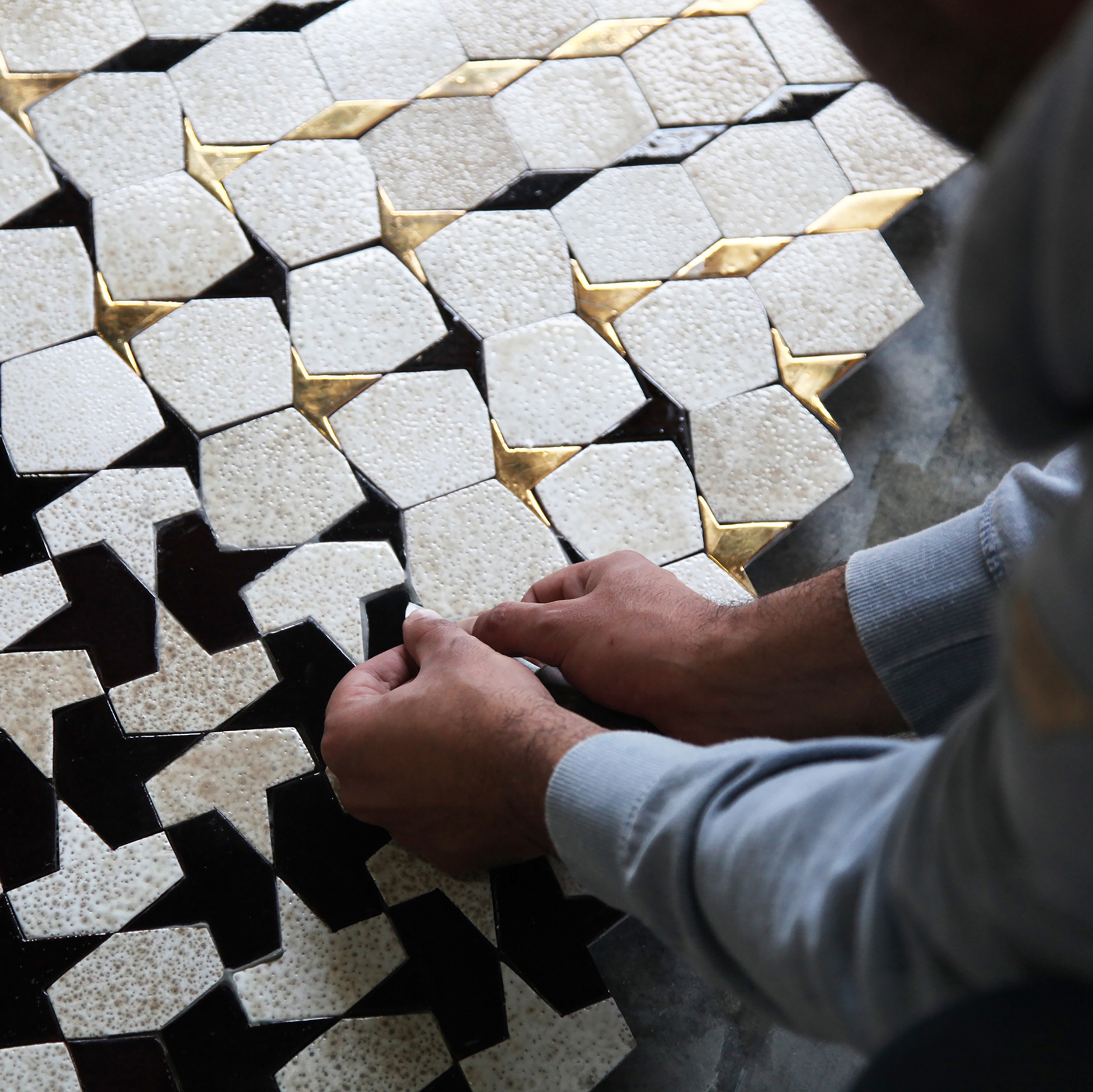
Amine Asselman –– Metamorphosis, 2023. Photo by Rita G. Rivera.
Arab Design Now is a survey exhibition of contemporary design from the Arab World. It features works done by local and regional designers across disciplines from architectural and material interventions to contemporary crafts, furniture, graphic, and object design.
The constellation of works presented reveal multifaceted conversations unfolding concurrently across our region today. The exhibition celebrates the diversity of design in the region, which is shaped by a fusion of cultures, traditions, histories, and beliefs, and seeks to map the common values, preoccupations, and histories that bind us together.
From Bilad al Sham to the Gulf to North Africa, designers exhibit a commitment to heritage-based traditions and rituals, and an eagerness to rediscover, reinterpret, and evolve them. Their design process is inspired by a culture centered on values of community, collaboration, and co-creation. A strong commitment to the environment is evident in their response to the unique geographies of the region, and their material sensibilities indicate an intimate relationship with the land and earth. Undeniably, there is a strong element of storytelling in design from the Arab World, communicated using a common language, and written using a script so distinctive it has evolved into an art form in its own regard.
Arab Design Now is an ode to the diversity and universality of the contemporary Arab identity and the possibilities that design can manifest.
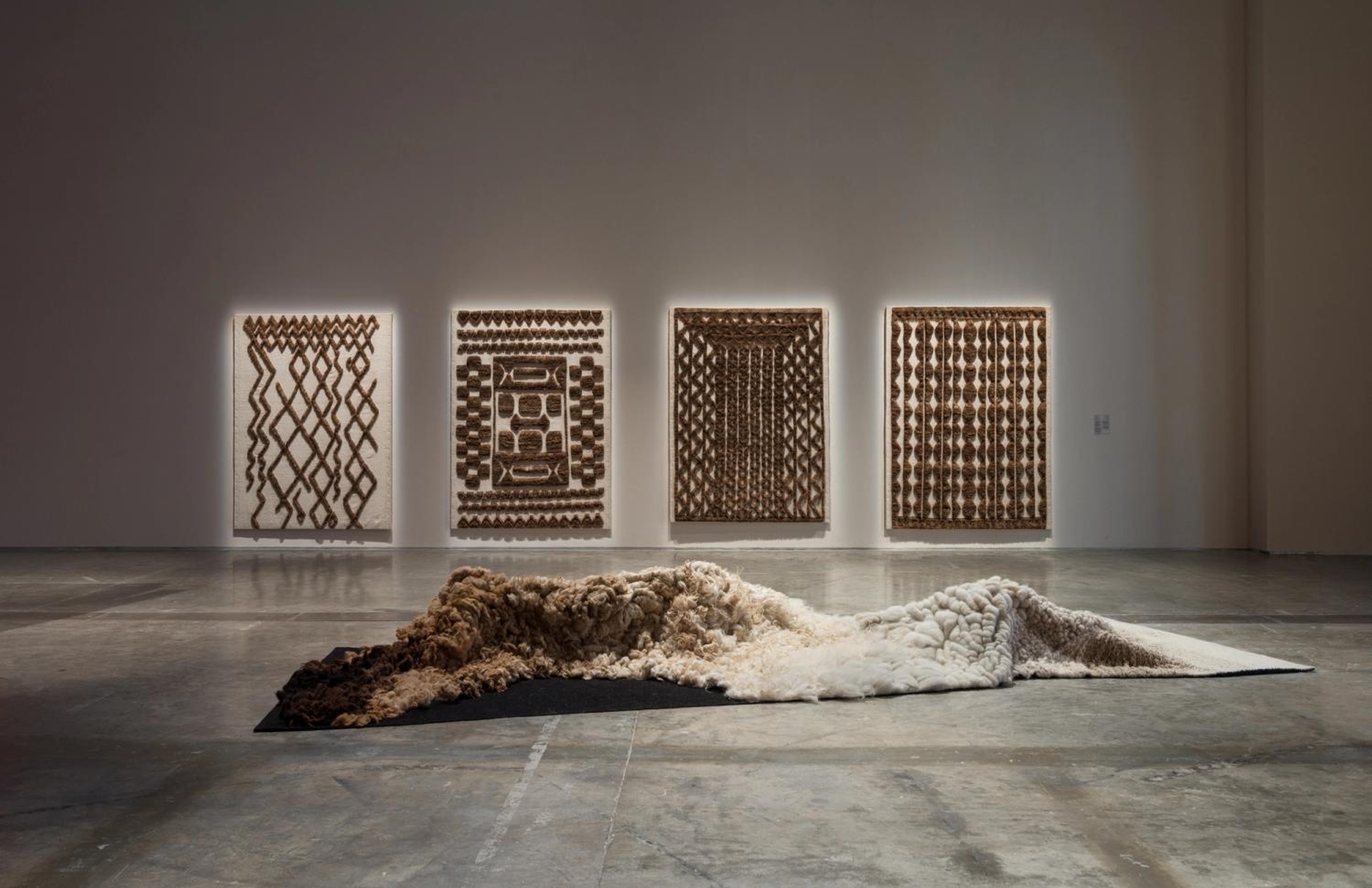
Amina Agueznay –– Portals 1-4, 2024 (background) and Ishraq Zraikat –– Raw Embrace, 2024 (foreground). Photo by Julian Velásquez.
Through a collaborative process that proposes to engage displaced rural communities with their villages of origin, Amina Agueznay, in collaboration with Cooperative Tiskmad, recreates four portals typical to the architecture of the Ksar, an Amazigh fortified village in Tissekmoudine, Morocco. Employing traditional materials processed in untraditional ways, the piece captures the path to the oasis, the texture of the shaved palm husk, the rough-spun undyed wool, as well as the architectural elements of the village, which all give way to the unpredictability of the loom.
Ishraq Zraikat's Raw Embrace is an homage to Bedouin weaving and contemporary felt making. It utilises Jordanian Awassi sheep wool across various stages of processing, from raw dirty wool to clean spun yarns. Needle felting is used to fuse the various wool fibres into a Bedouin-style tent fabric, itself made from wool and goat hair. A visual and tactile progression emerges as the wool is transformed from a crude natural resource to a refined finished product before our eyes. The piece presents a material return to the landscape and nature’s processes.

Hala Kaiksow –– Charta Domos, 2024. Photo by Julian Velásquez.
This work explores the concept of a passage between two worlds — a warm entrance inviting touch and contemplation. Made from home-made recycled paper and materials sourced from the designer’s garden, the structure alternates between soft and hard, bringing a piece of her home to this entrance.
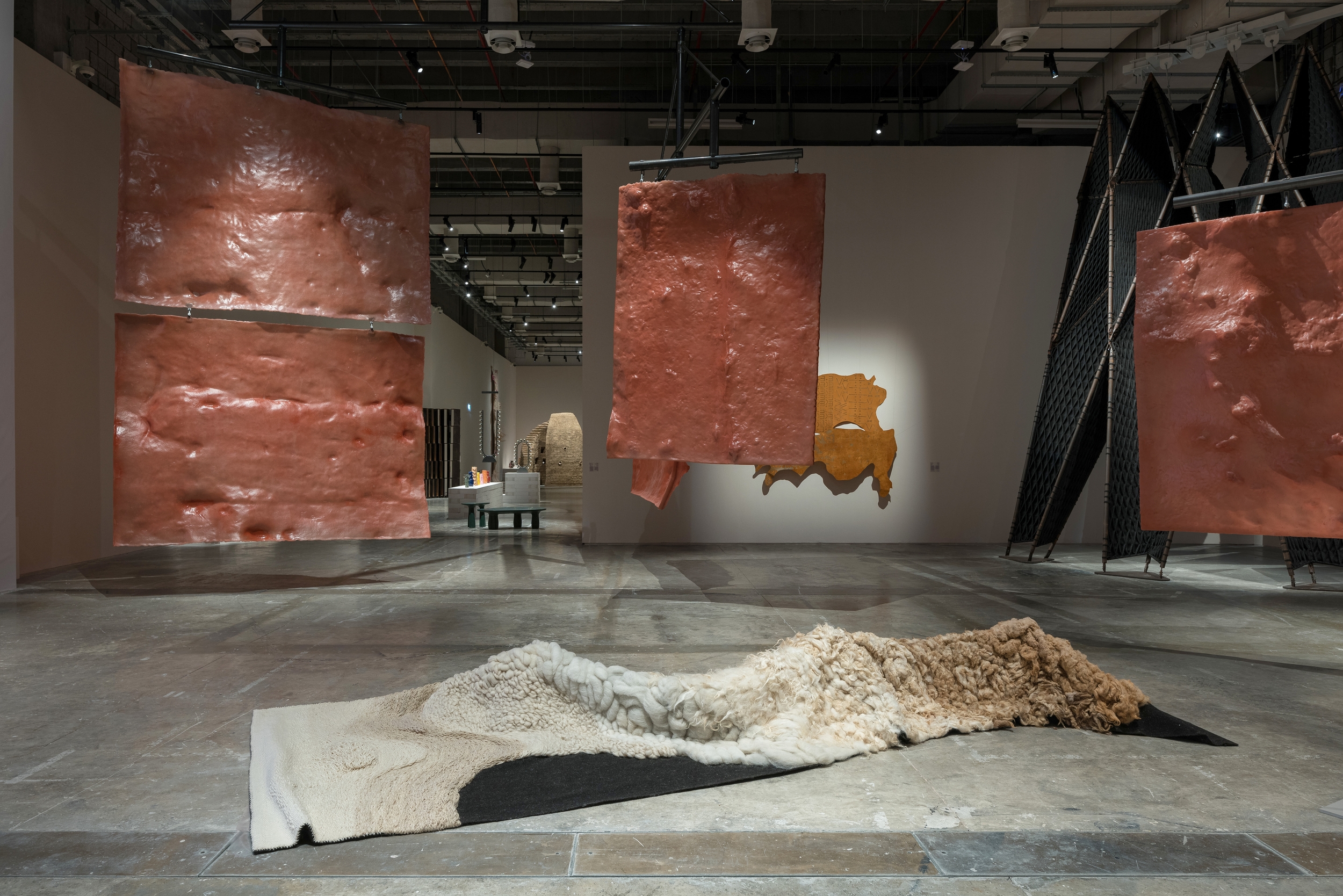
Arab Design Now –– Design Doha Biennial, 2024. Photo by Edmund Sumner.
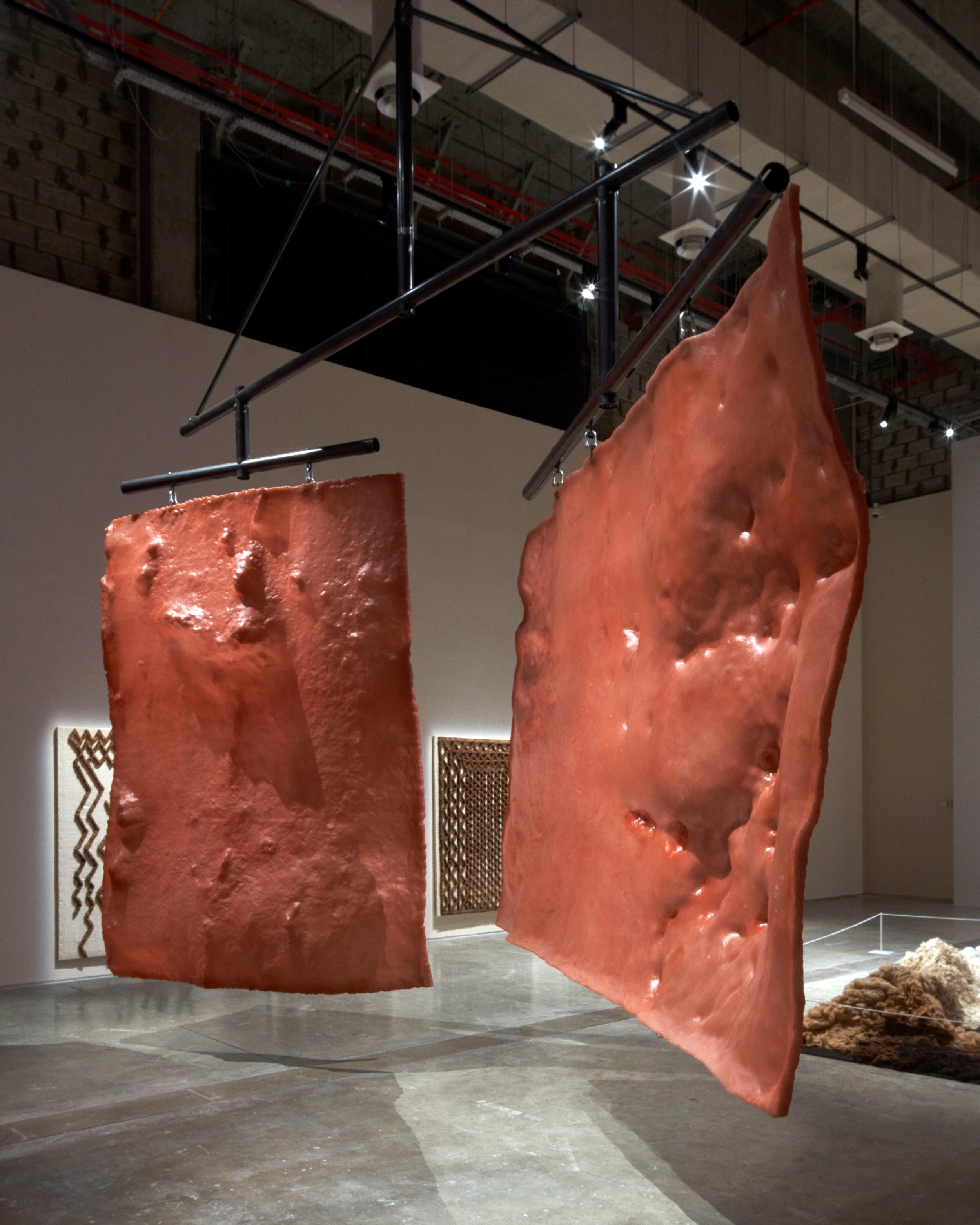
Studio Anne Holtrop –– Sites - New Sites, 2024. Photo by Edmund Sumner.
Large-scale resin casts of man-made and natural sites found in Qatar perform a slowly moving choreography of fragments of earth. Endlessly reconfiguring their relationships to each other, and presenting new sites that do not exist yet, the casts are set on mobiles with bearing mechanisms, and rotate based on interaction of the visitors and air movements, altering the spatial configuration of the room.
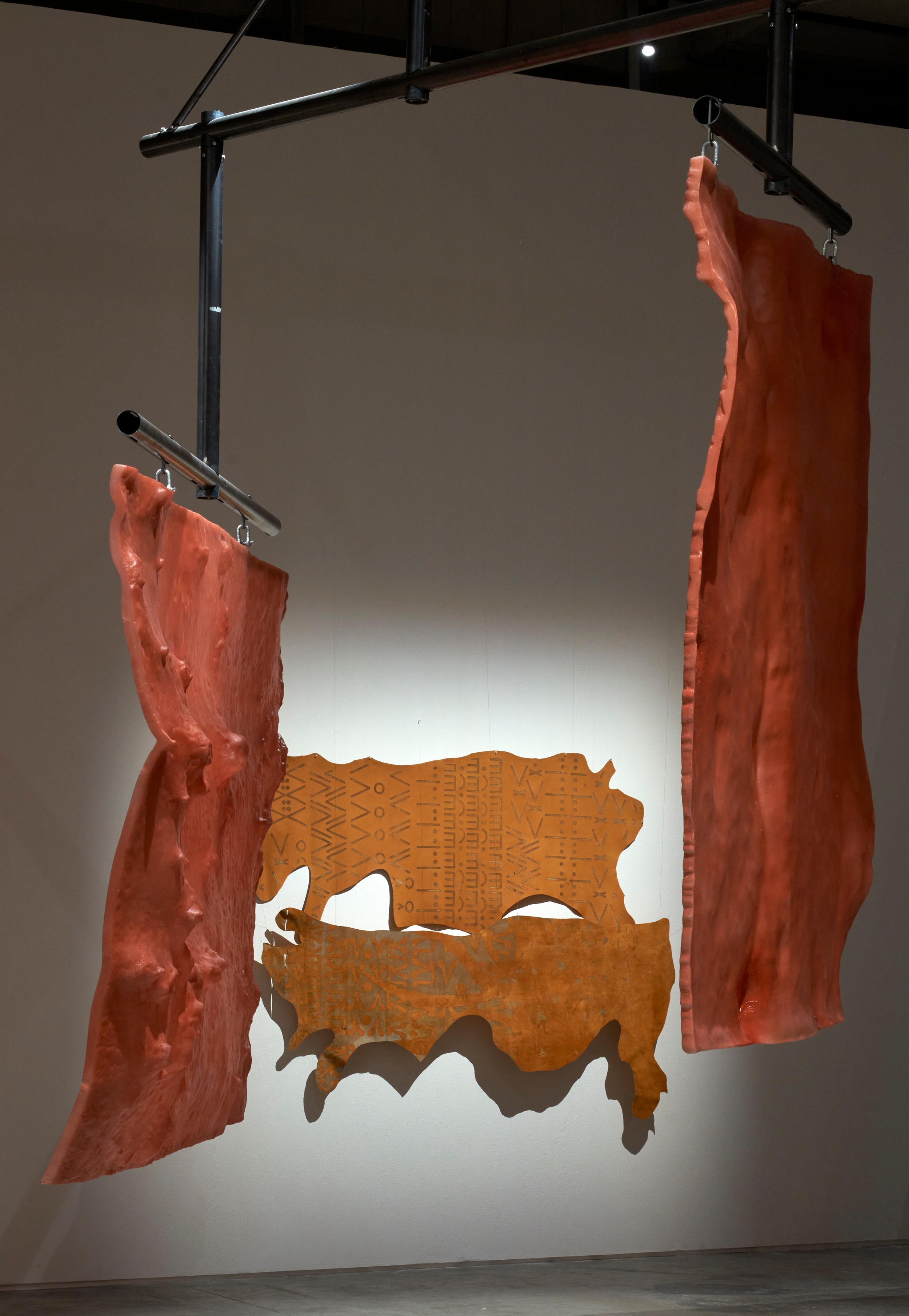
Asma Derouiche –– Wasm, 2020. Photo by Edmund Sumner.
In Qatar, a wasm (or tattoo) is used to declare ownership of a person’s halal (livestock). Branded on the neck of a camel to signify its belonging to a herd, it acts as conclusive evidence of ownership in case of loss. Great importance is placed on the design to personalise it, making it difficult to imitate or alter. These laser-engraved camel leather pieces attempt to introduce new graphic patterns and motifs, developed by graphic designer Zainab Al Shibani.

Dina Haddadin –– Sabil – The Nomad Pavilion, 2024. Photo by Edmund Sumner.
This is one monumental shard from a tent-shaped pavilion composed of nine “petals” rotated on thirty-degree angles. The design, inspired by a traditional “seed of life” pattern, exhibits a dedication to craftsmanship, sacred geometry, and sustainability. A living breathing skin made of coarsely woven goat hair, much like the native materials used to weave Bedouin tents, covers the structure, providing natural insulation via the trapped air cells. The full pavilion acts as a sabil, a traditional Arab structure that serves both as a shelter from harsh desert climates, and a water collecting tower.
The pavilion was designed in collaboration with Rasem Kamal, and made in collaboration with Issa Farah and Al-Taqwa Projects for Contracting.

Arab Design Now –– Design Doha Biennial, 2024. Photo by Julian Velásquez.
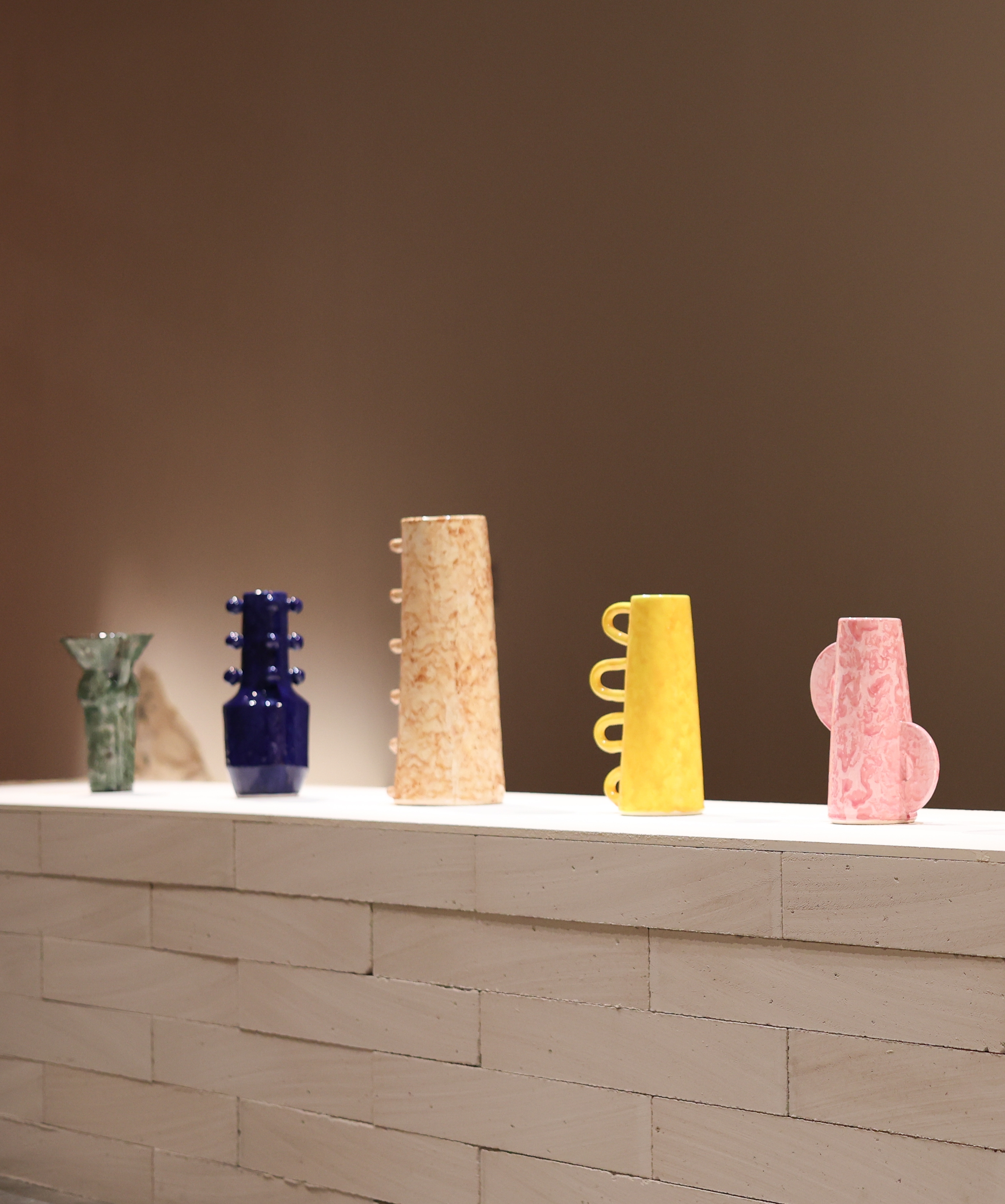
IBKKI –– The Process Collection II, 2023. Photo by Abdelaziz Alsafadi.
These ceramic pieces were created as a result of a geographical transit between Algeria, where the forms were turned, and France, where they were glazed and fired, often multiple times. The forms and glazes are inspired by the Algerian natural landscape.

Louis Barthélemy –– Manhood, Dancer, and Gazelles, 2022-2023. Photo by Abdelaziz Alsafadi.
In this triptych of hand-embroidered tapestries, Louis Barthélemy captures the rural landscapes and gender representations of Ancient Egypt. Surrounded by the lush foliage of a vibrant palm grove and frolicking gazelles, a muscle man and an ancient dancer leap side by side, their forms suspended in mid-air. The timeless elegance of the dancer, as depicted in the tomb in Saqqara, acts as a nod to the works of modern Egyptian painter Hamed Nada.
Made in collaboration with brother and sister Nejib and Zahra and seven other artisans in Mahdia, Tunis, the tapestries incorporate embroidery, weaving, and dyeing techniques that date back to the 10th century traditional stitches are combined with innovative materials like agave and metal.

BONE –– The Introvert, 2024. Photo by Alfaz Syed.
Embracing architectural heritage, this piece draws inspiration from historic concepts of privacy and protection. Emirati homes and forts were designed as shielded entities with minimal openings to the outside. These openings were thoughtfully positioned, and often fashioned in trapezoidal or conic shapes.
"Date Form" is a UAE-based material innovation startup that produces solid surface materials from date seeds, a by-product of the significant date farming industry. "Metal Fabrik," a UAE-based metal fabricator specializing in developing custom patinas for various metals and surfaces, has crafted a custom-made patina on metal derived from the natural yellow colour of the region's commonly used spice, turmeric.
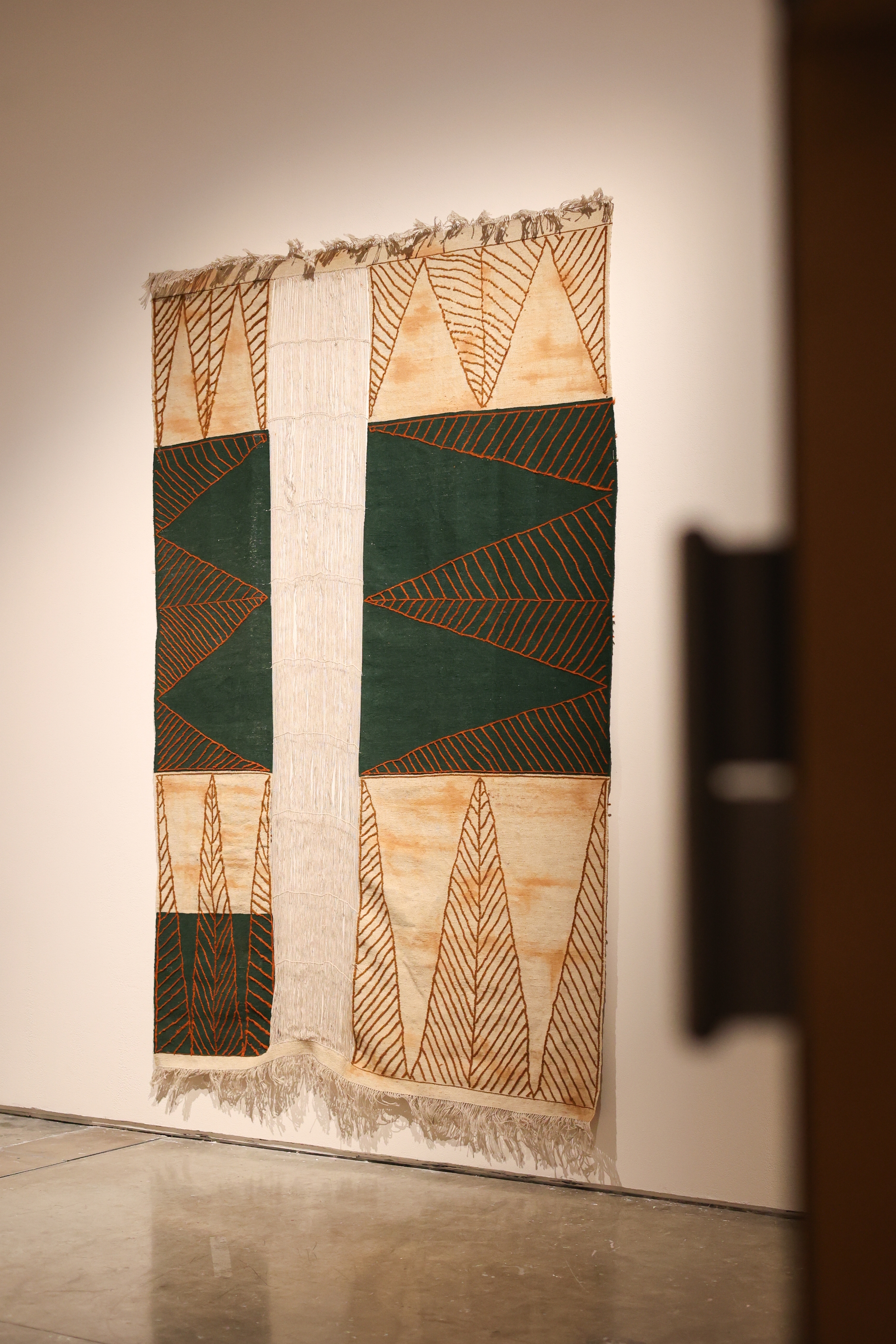
Abdulrahman Al Muftah –– Palm Fiber Carpet, 2023. Photo by Abdelaziz Alsafadi.
An homage to Qatar’s rich heritage traditional Sadu weaving, this carpet uses the palm tree as a primary material source. The intricate craftsmanship draws on the artist's familial connection to professional traditional weavers, bringing a deep authenticity to the work.

Arab Design Now –– Design Doha Biennial, 2024. Photo by Edmund Sumner.
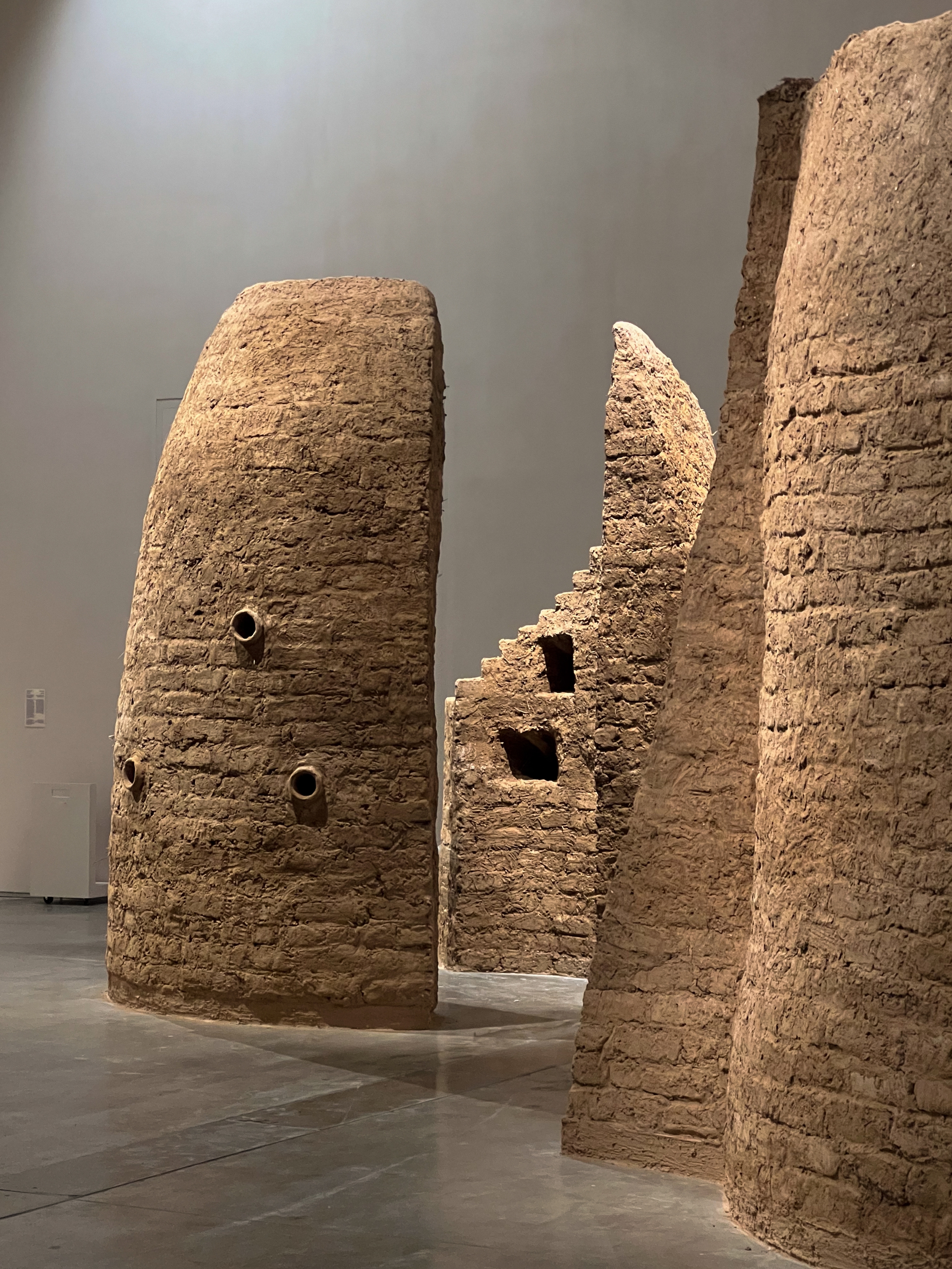
Salima Naji –– Sharing the Earth (Spatial Interiorities), 2024. Photo by Tala Alhaj.
Two raw-earth and bamboo pavilions, using palm trees for structure, create a series of cocoons. In a style typical of rural adobe architecture in Morocco, trellises of varying lengths are assembled to filter light and create a protective skin. The structure features skylights, as in the Sahara, lined with patterns of branch wood (tataoui) to protect it from the climate, to create shade and feel the soft breath of natural ventilation. This installation encourages a complex dialogue with materials, which are the very "flesh" of the building. The material for this pavilion was sourced at Torba Farm in Qatar, and built by master artisans Abdellah Akki, Brahim Sadik, and Samih Taibi.
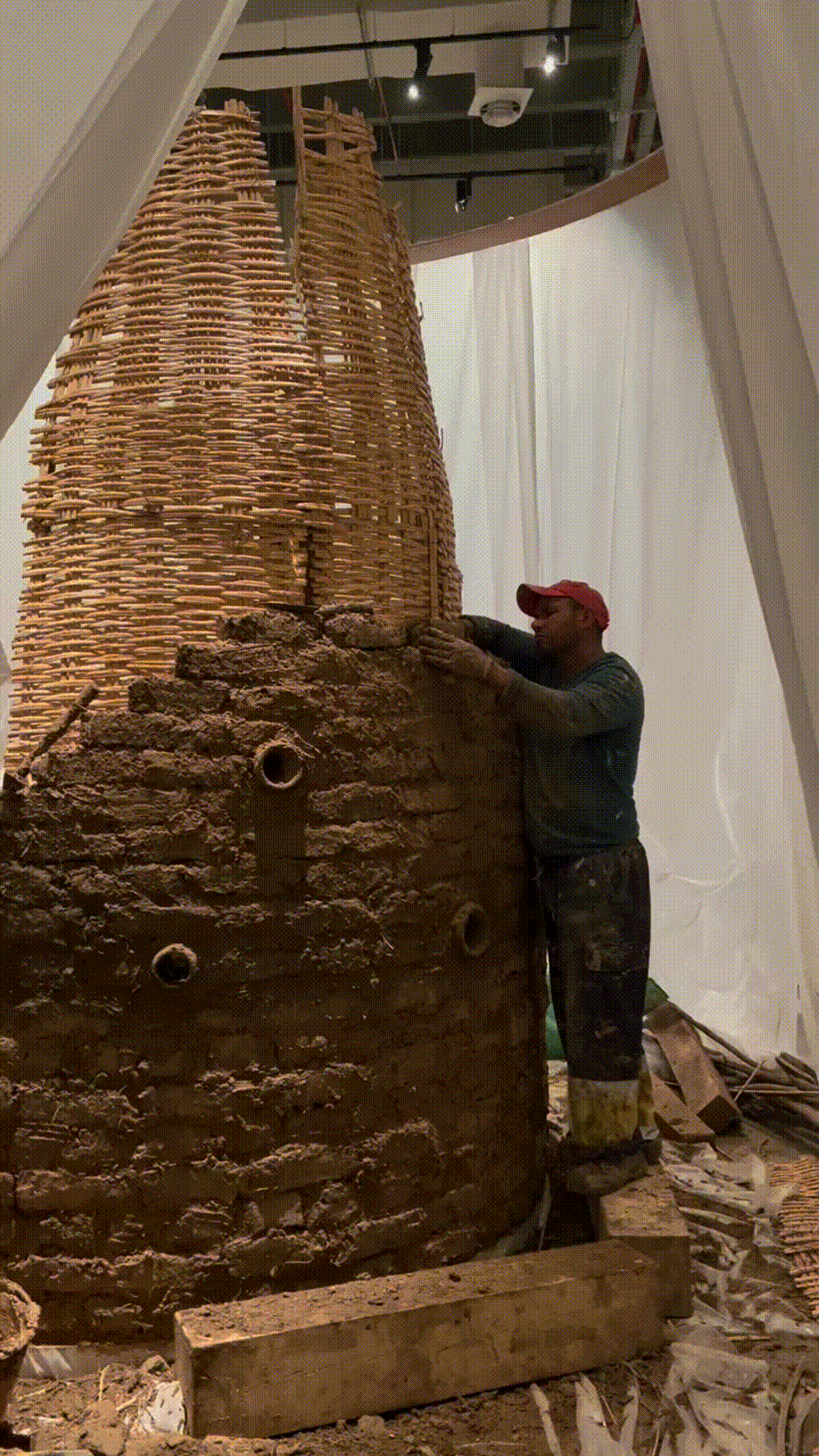
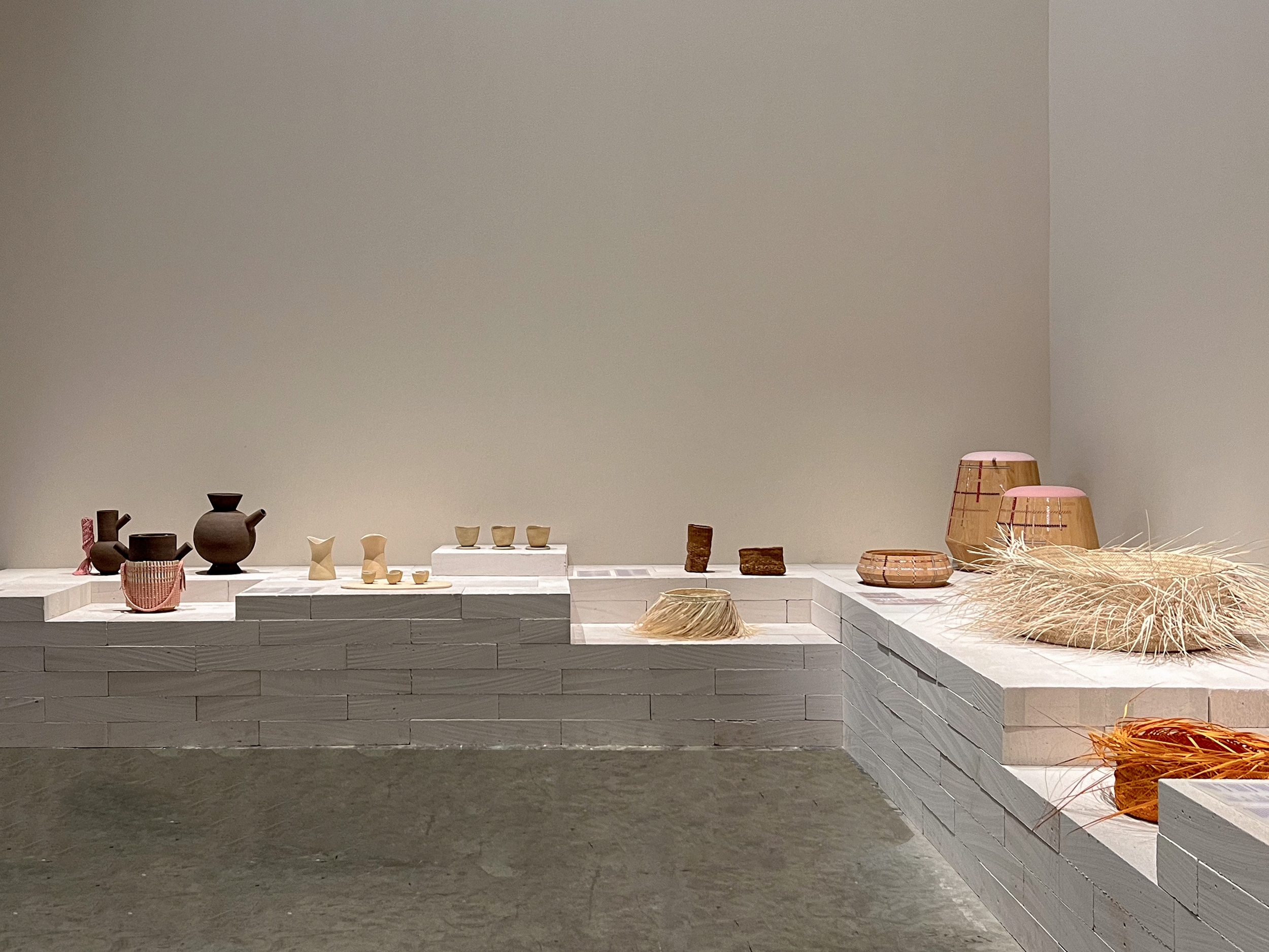
Irthi Council –– Zenobia Collection, 2022. Design Labs Collection, 2019. Nadd Collection, 2022. Thaya Collection, 2022. Sofra Collection, 2023. Photo by Tala Alhaj.

Sama El Saket –– Clay in Context, 2023. Photo by Abdelaziz Alsafadi.
The Jordanian landscape features a plethora of local clay deposits and a long history of ceramic production. Despite this, most of the clay used in Jordan today is imported.
This long-term research project aims to uncover sites of clay harvesting by referencing geological maps, participating in conversations with craftspeople, and locating historic workshops. The origin and composition of each clay was examined, and a series of preparation techniques were tested, resulting in a range of textures and outcomes.
The series of vessels present the resulting distinct clays found in Jordan, reflecting the subtle color gradations of the landscape. The repeated form references spindle storage bottles, a typology produced across different periods and regions in Jordan, originally used to safeguard valuable oils, perfumes, and medicines.
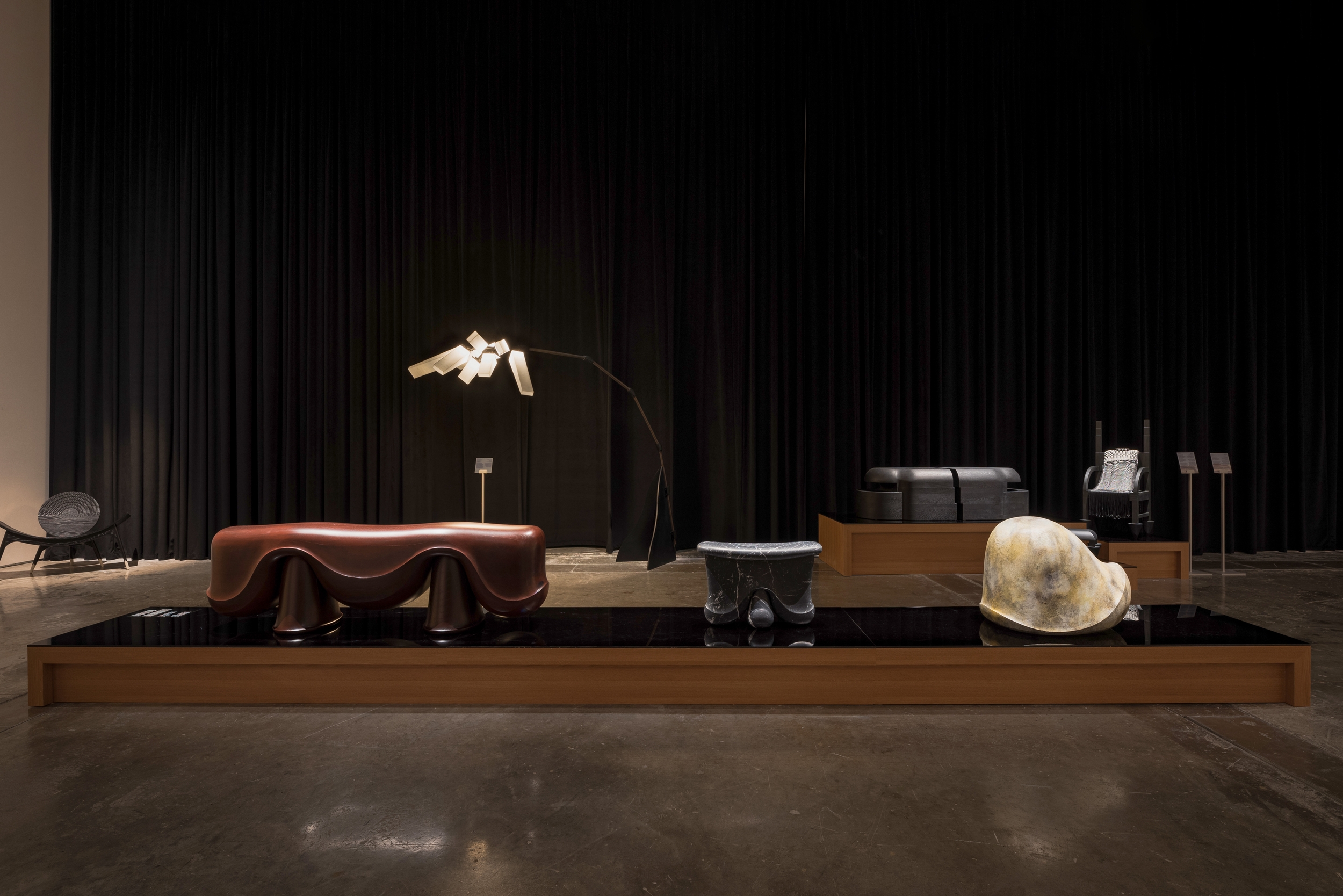
Hozan Zangana –– Nahiru, Hapiru, Kisal, 2024 (foreground). Photo by Julian Velásquez.
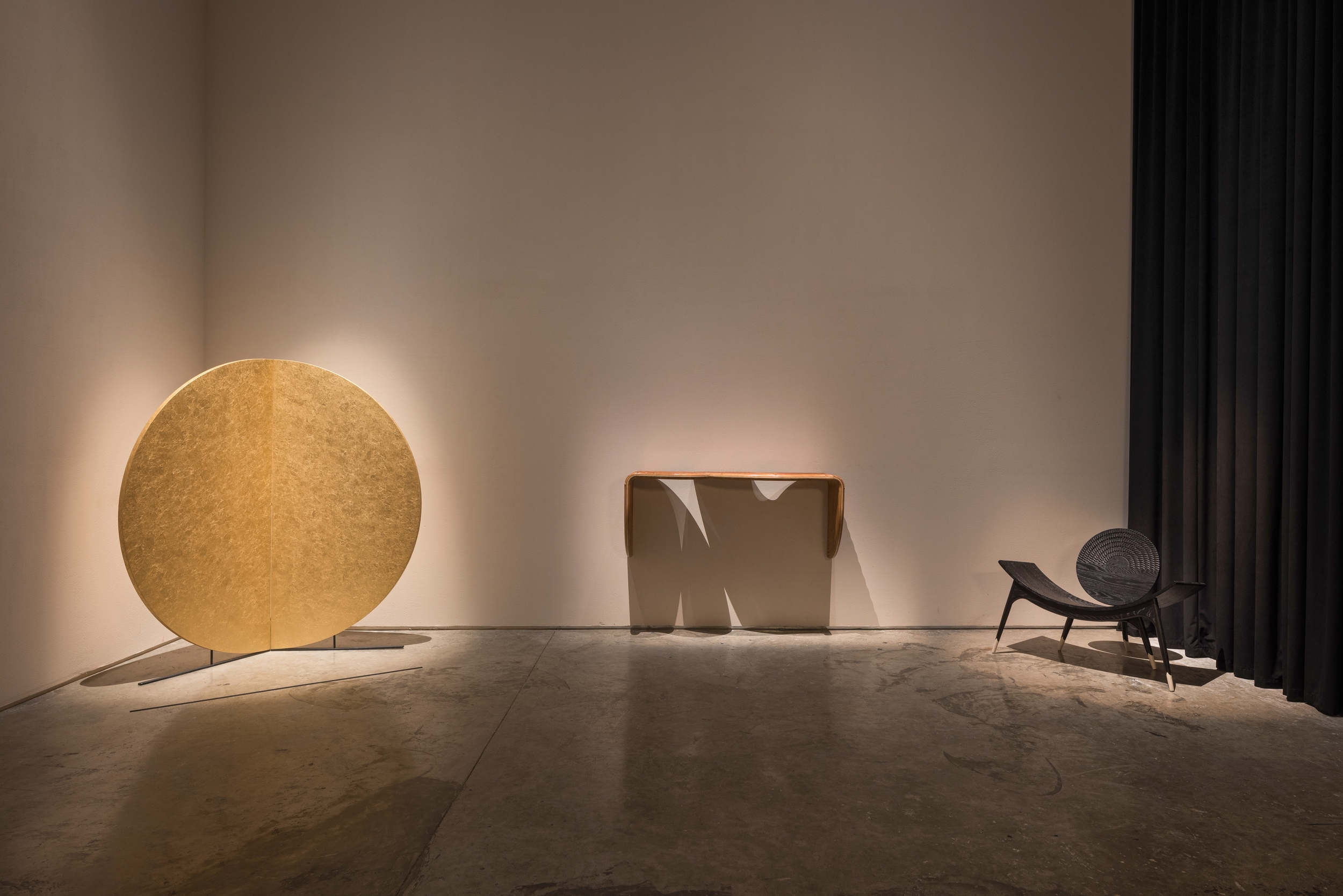
Lina Alorabi for Don Tanani –– Maat, Atet, Shen, 2021. Photo by Julian Velásquez.
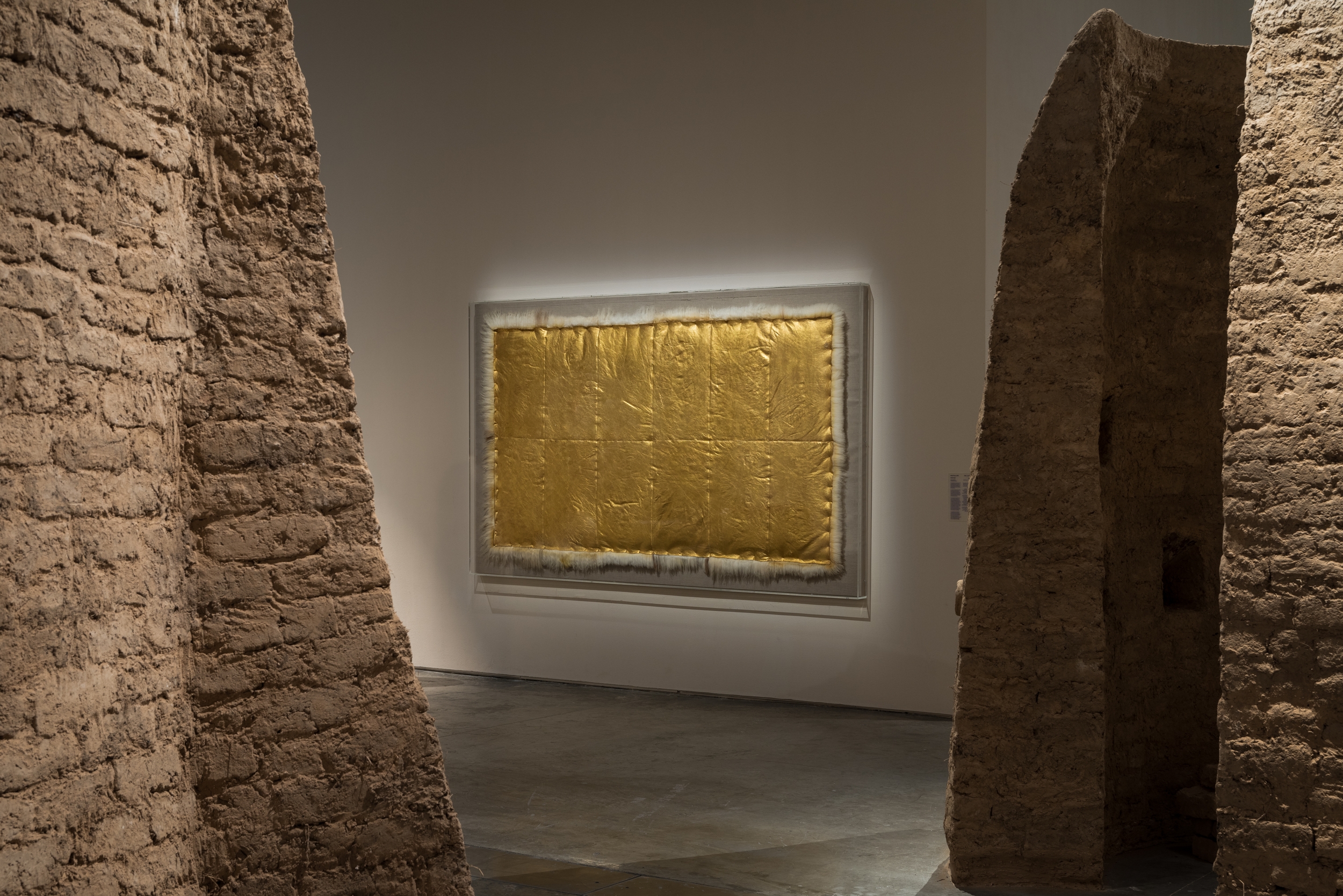
Adrian Pepe –– Gilded Fleece, 2024. Photo by Julian Velásquez.
This tapestry is constructed from the discarded skins of the fat-tailed Awassi sheep, gilded in 24 karat gold leaf on the reticular (back) side of the hand-stitched pelt assembly. In a blend of tradition, innovation, and critical inquiry, it invites conversations around the value and symbolism of materials, as well as the complex histories and cultural significance of animals and their by-products.
The Awassi sheep, also known as Ausi, Baladi, or Na’ami, is a widely recognized breed that originated in Western Asia. It is considered the most widespread non-European sheep around the globe. This breed has been a key protagonist in human history, domesticated for its meat, milk, skin, and wool. The Awassi embodies a pastoral way of life that has been an integral part of human culture for centuries.
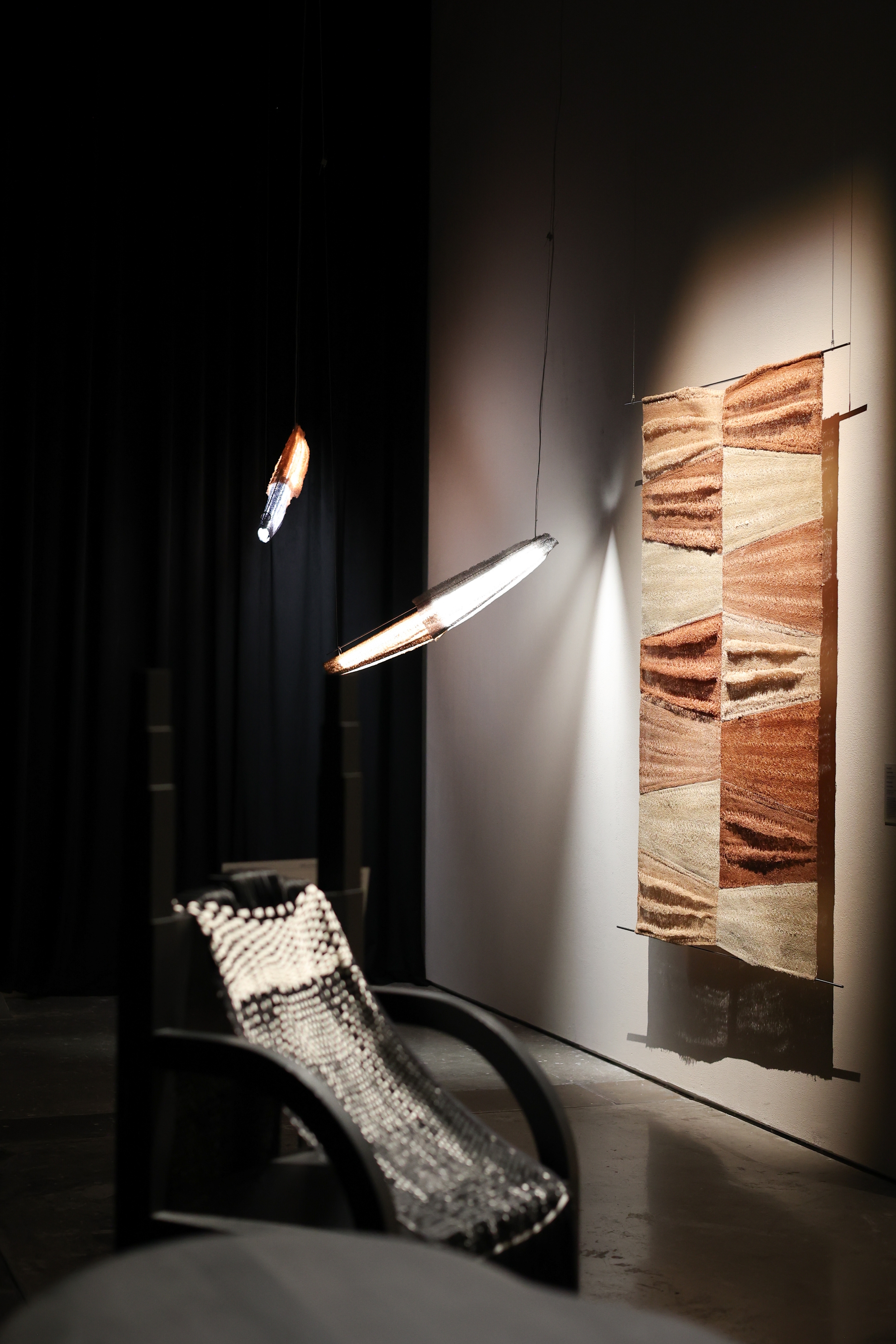
Samer Selbak –– Reef and Saffeer, 2022. Photo by Abdelaziz Alsafadi.
The Reef space divider and Saffeer pendant lamps are crafted from dyed luffa fibers which have been treated, shaped, flattened, and sewn. The resilient and biodegradable plant fiber permits the passage of air and light, giving a mystical presence. The pieces are supported by steel armatures, which simultaneously provide form and function.
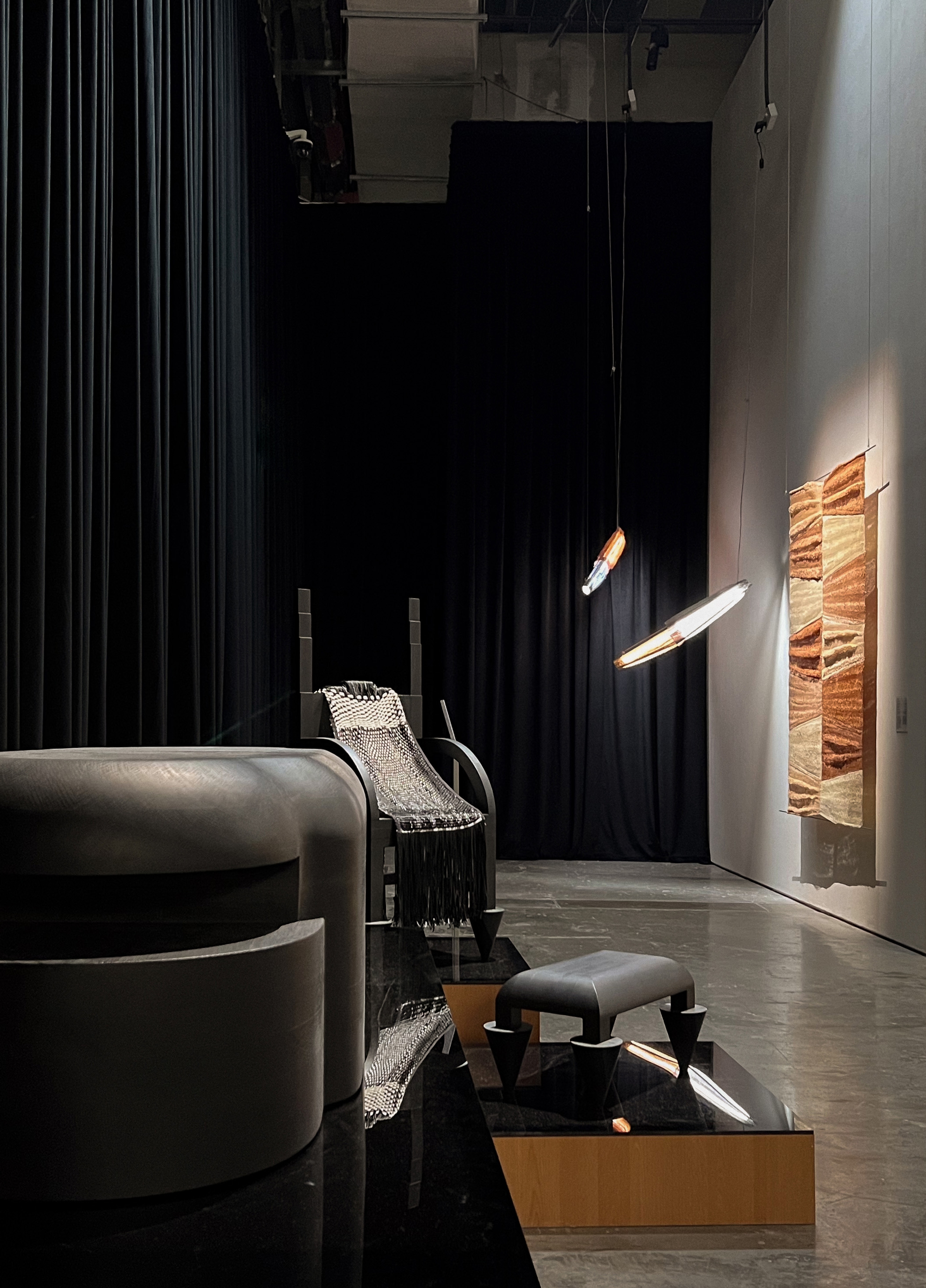
Sizar Alexis –– Ousia, 2022, Lahmu, 2021. Photo by Tala Alhaj.
The work of Swedish-Iraqi designers Sizar and Sinar Alexis draw reference from ancient Mesopotamian culture and are an exploration of their identity as part of the Chaldean diaspora.
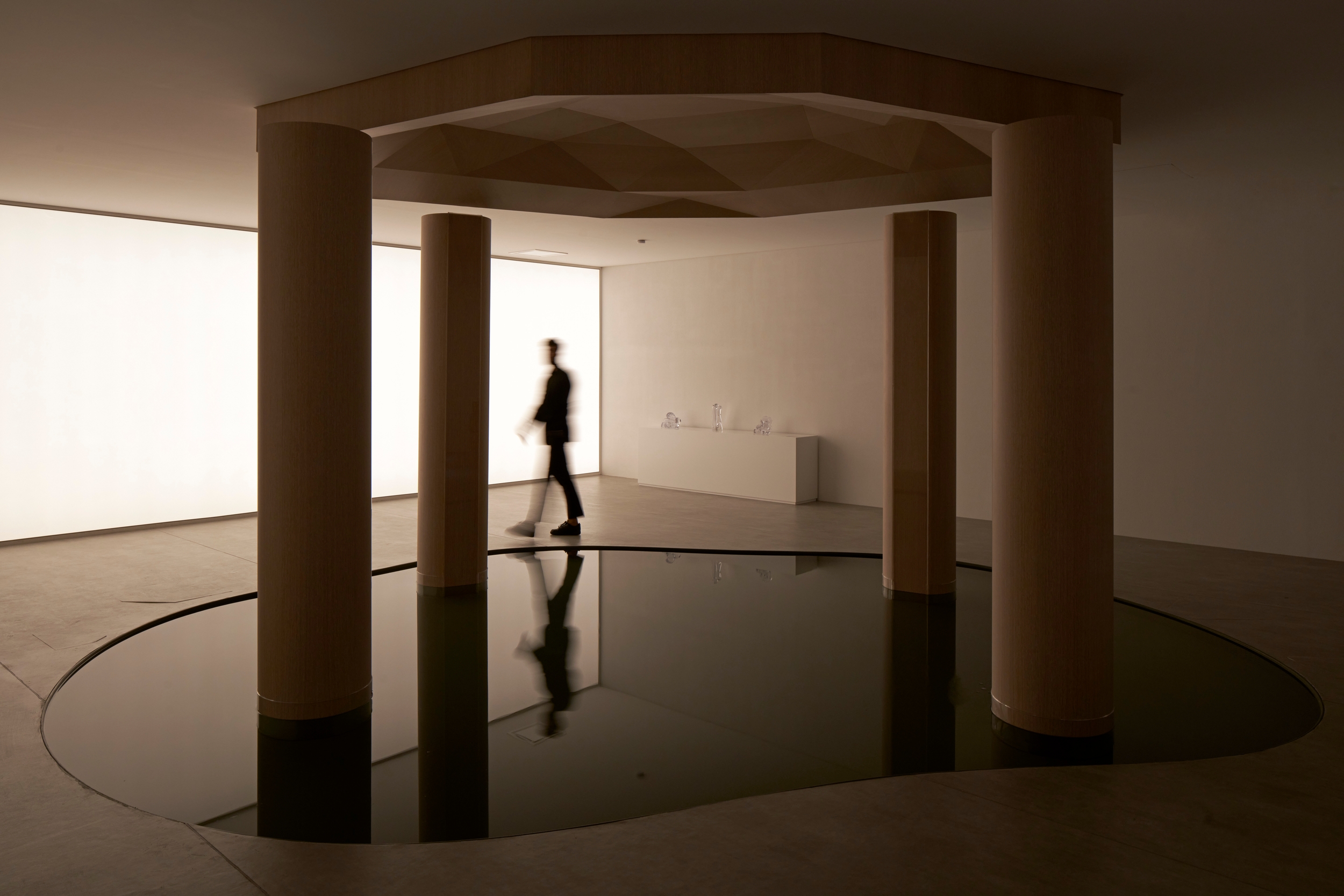
Hiba Shahzada –– Reverie, 2024. Photo by Edmund Sumner.
Reverie is an indoor water pavilion featuring a suspended wooden ceiling with a domed faceted interior, seemingly anchored from below by four freestanding wooden pillars. Set directly in a reflecting pool, the pillars double as inward cascading fountains that seem to reach for the ceiling’s edge. It is intended as a place of respite, the structure invites pause, wonder, and renewal.
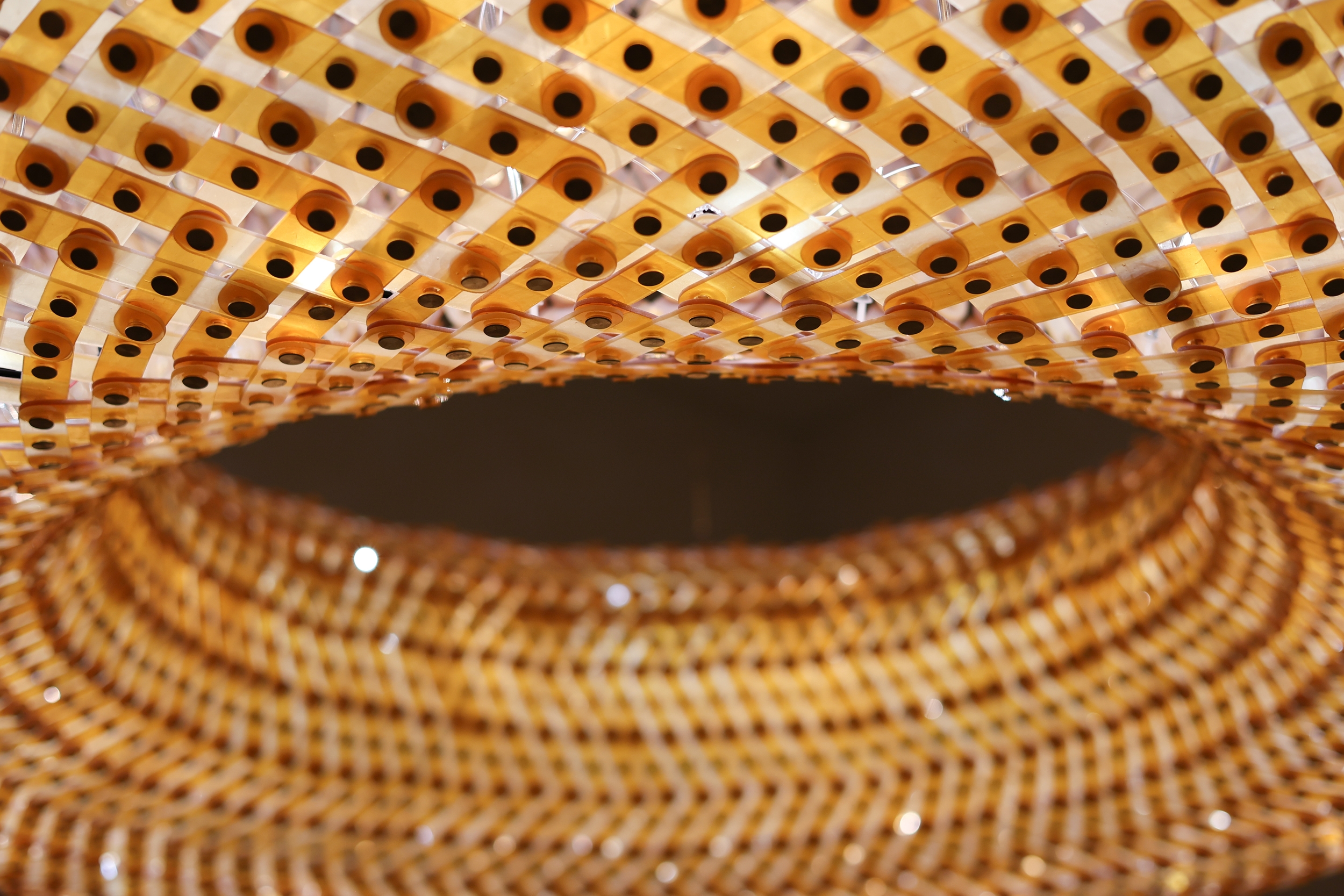
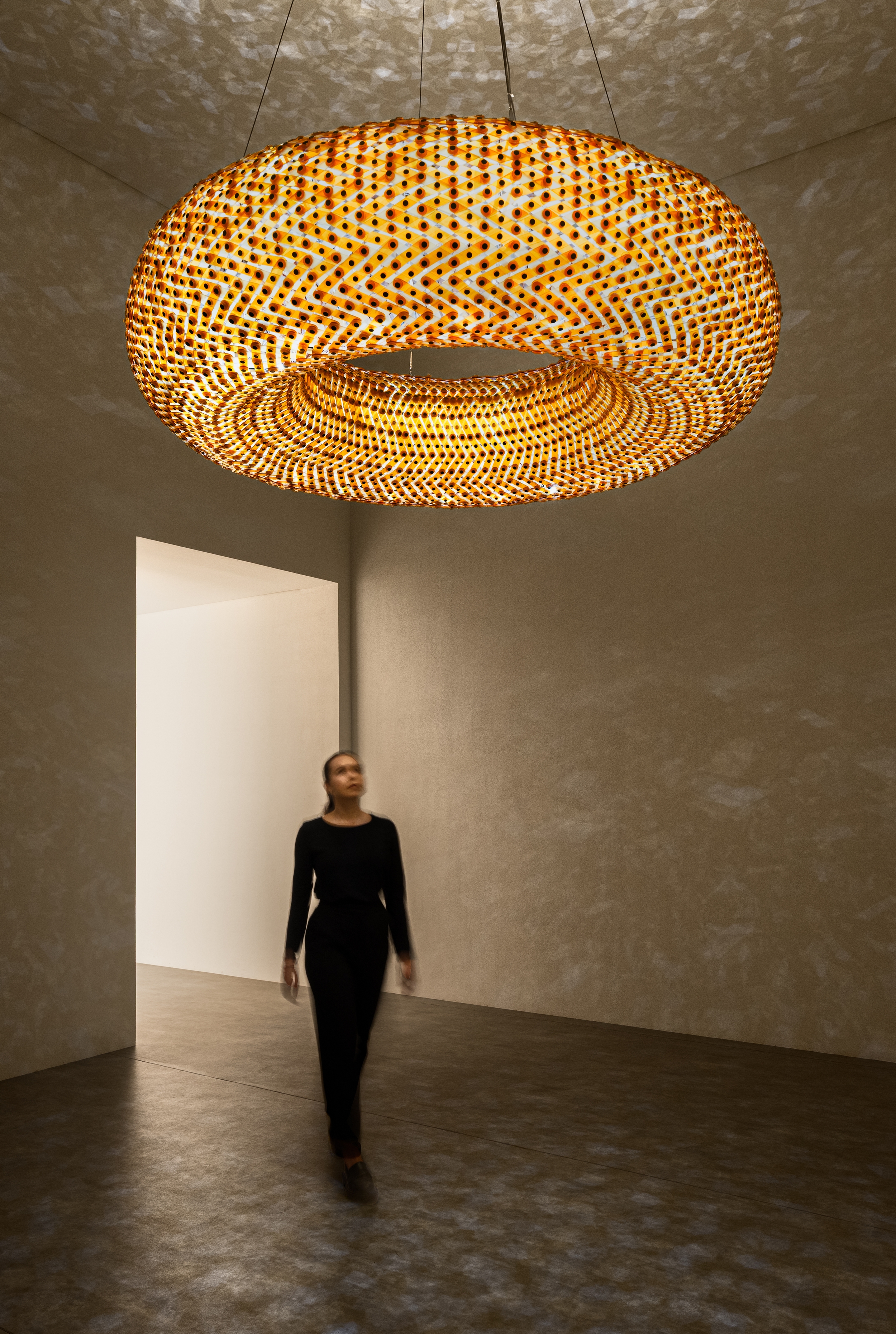
Abeer Seikaly –– Constellations 2.0: Object. Light. Consciousness., 2023. Photo by Julian Velasquez.
This suspended light sculpture is handcrafted from over 5,000 pieces of Murano glass, linked together to form one continuous mesh. It draws upon intangible heritage from both Italy and the Arab homeland, merging traditional Venetian glassmaking and Bedouin weaving practices.
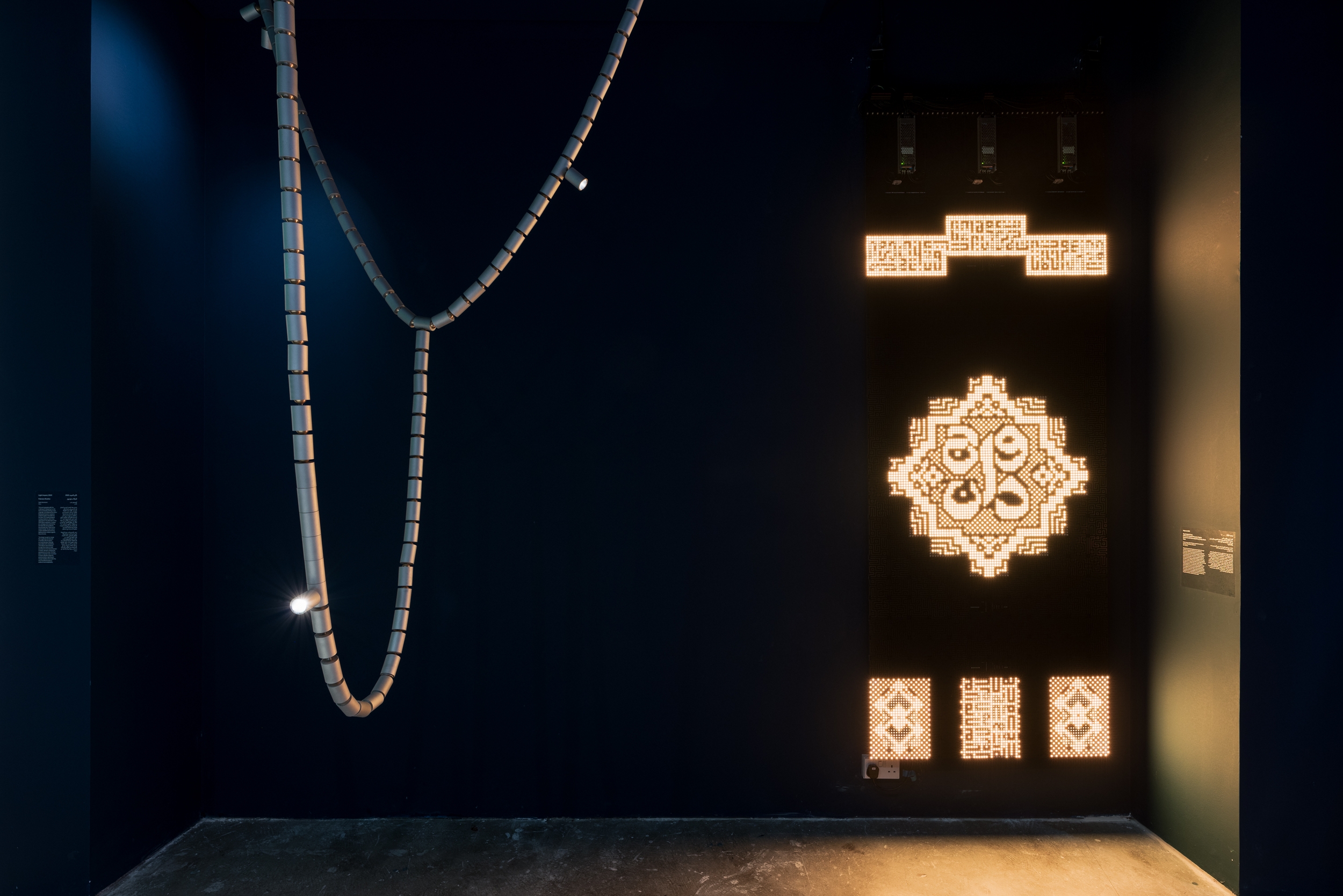
Fabraca Studios –– Light Impact, 2022 (left) and TypeAraby & xLab –– Wujood, 2024 (right). Photo by Julian Velásquez.
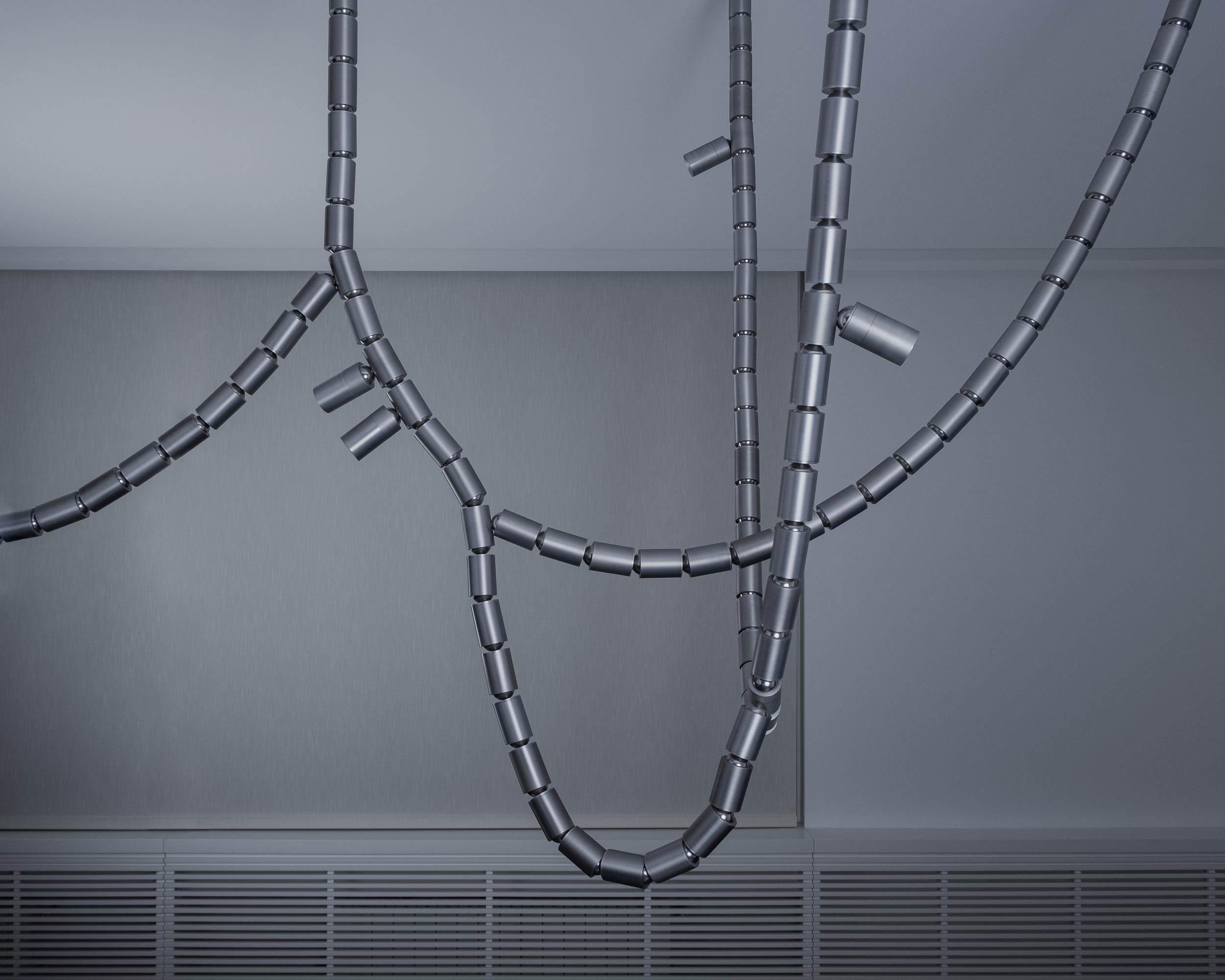
Fabraca Studios –– Light Impact, 2022. Photo by Roudy Farrane.
This work was originally commissioned by Karim Bekdache Studio to replace a shattered glass chandelier by the New York-based designer Lindsay Adelman, which was destroyed in the aftermath of the 2020 Beirut explosion. Located at a vantage point overlooking the blast site and guided by the principle that "what bends doesn't break", the aim was to create a flexible and enduring lighting fixture, resilient against future shocks.
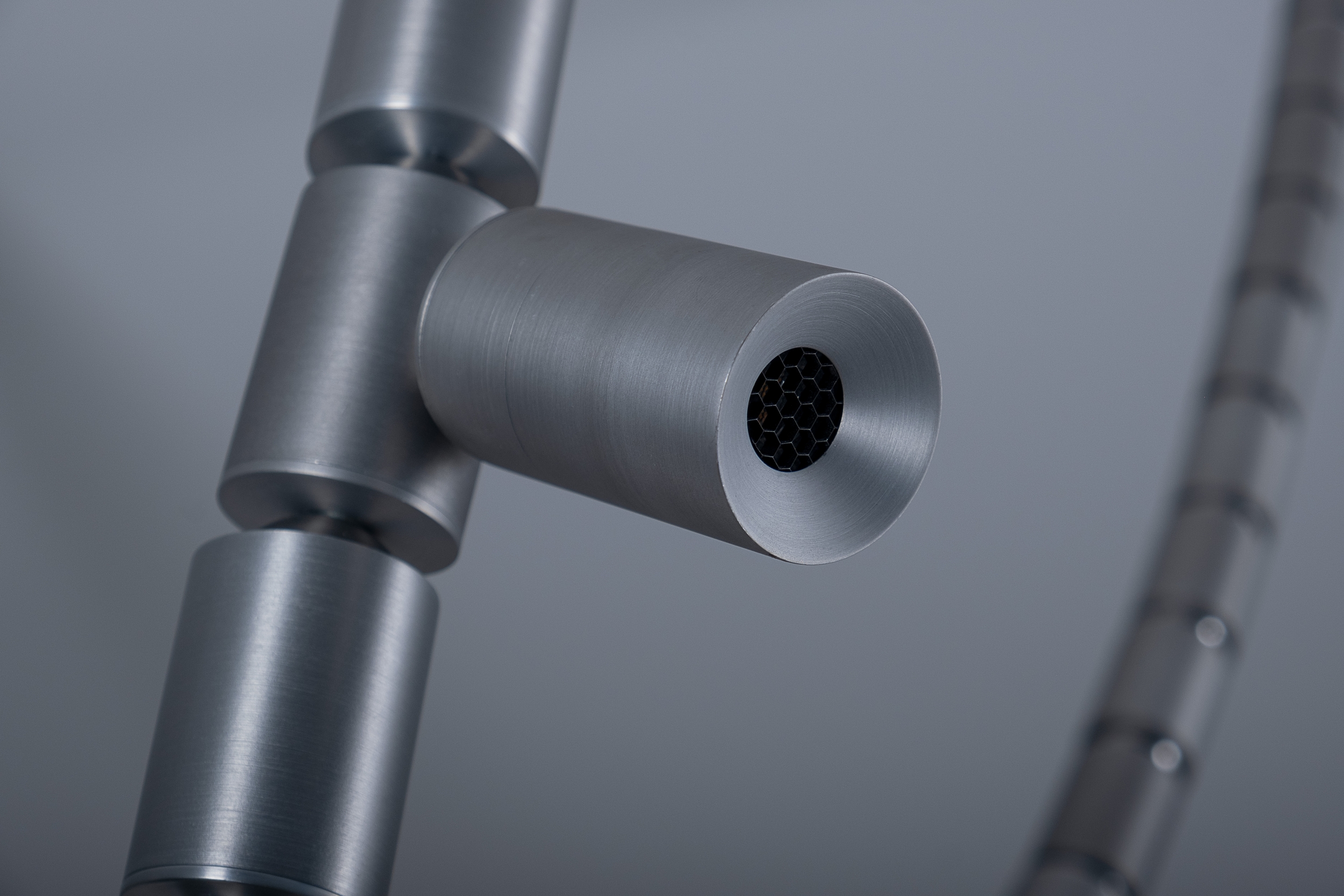
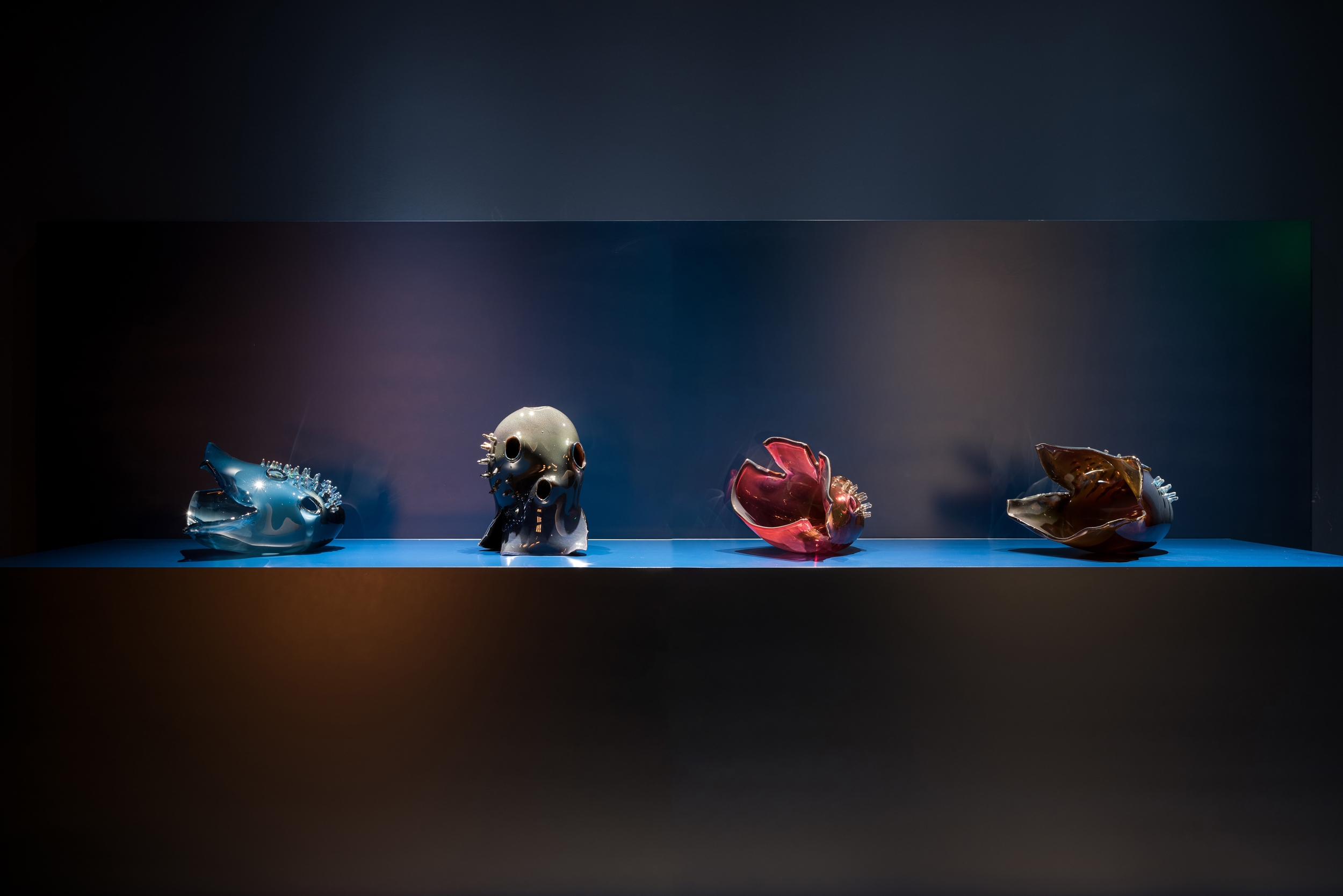
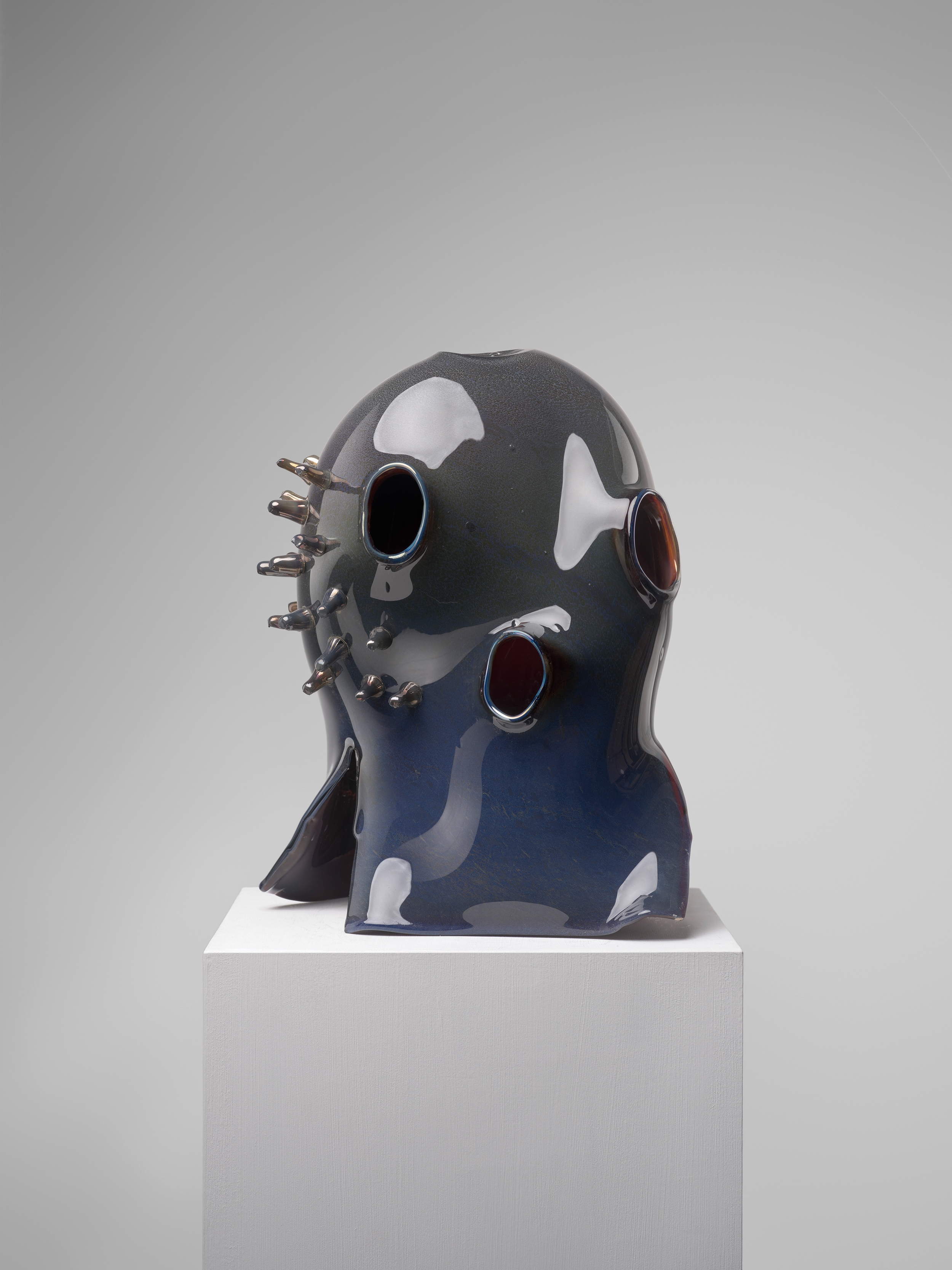
Ali Kaaf –– Helmet, 2024.
The Helmet series is a collection of blown glass sculptures inspired by ancient war-time headgear from a diversity of historical moments. Despite these helmets being used by fighters of different cultures and across time, they often share the same destiny of becoming relics at museums. For the artist, the choice of material adds fragility to an immortal object that remains resilient throughout history, unlike the humans it served to protect.
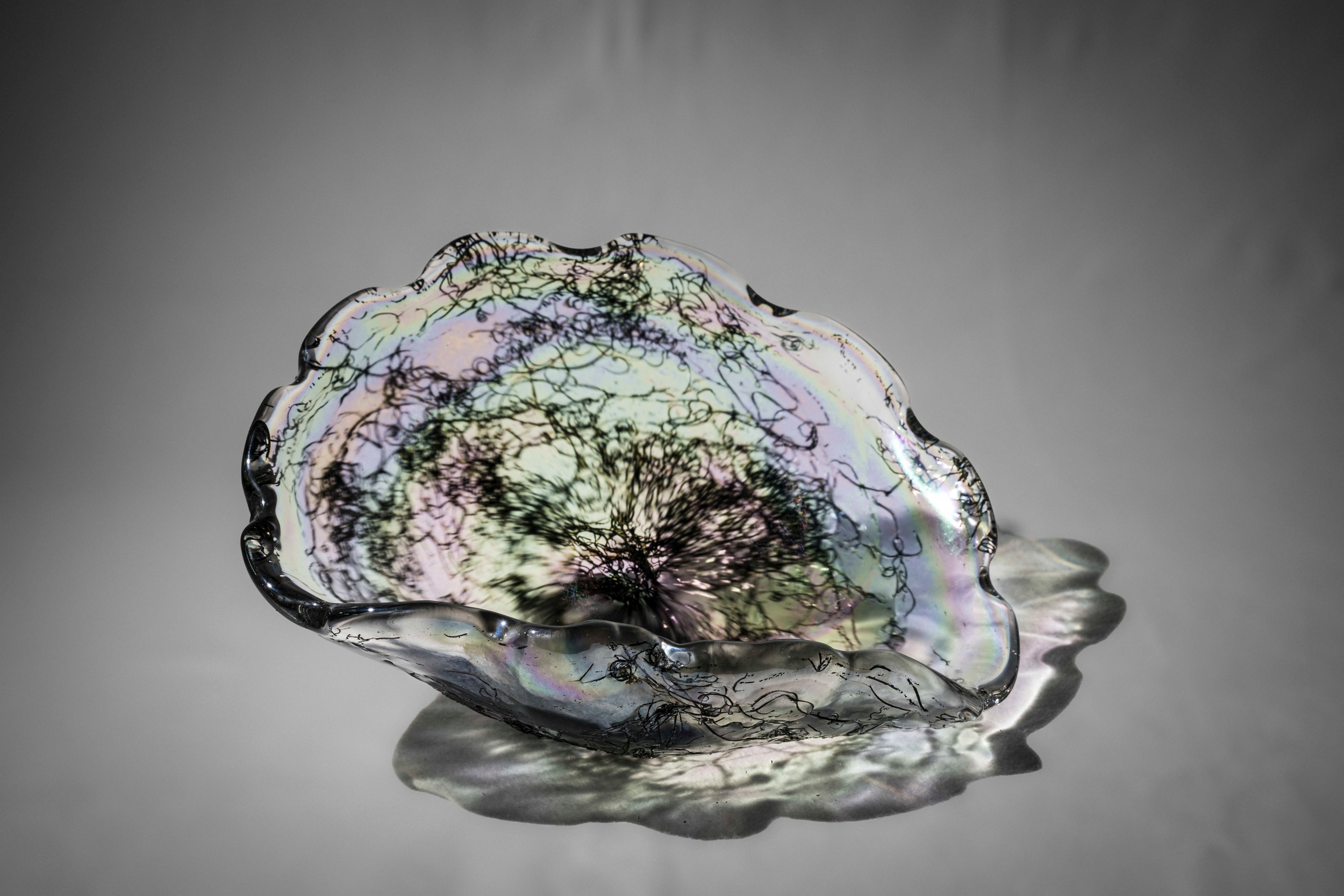

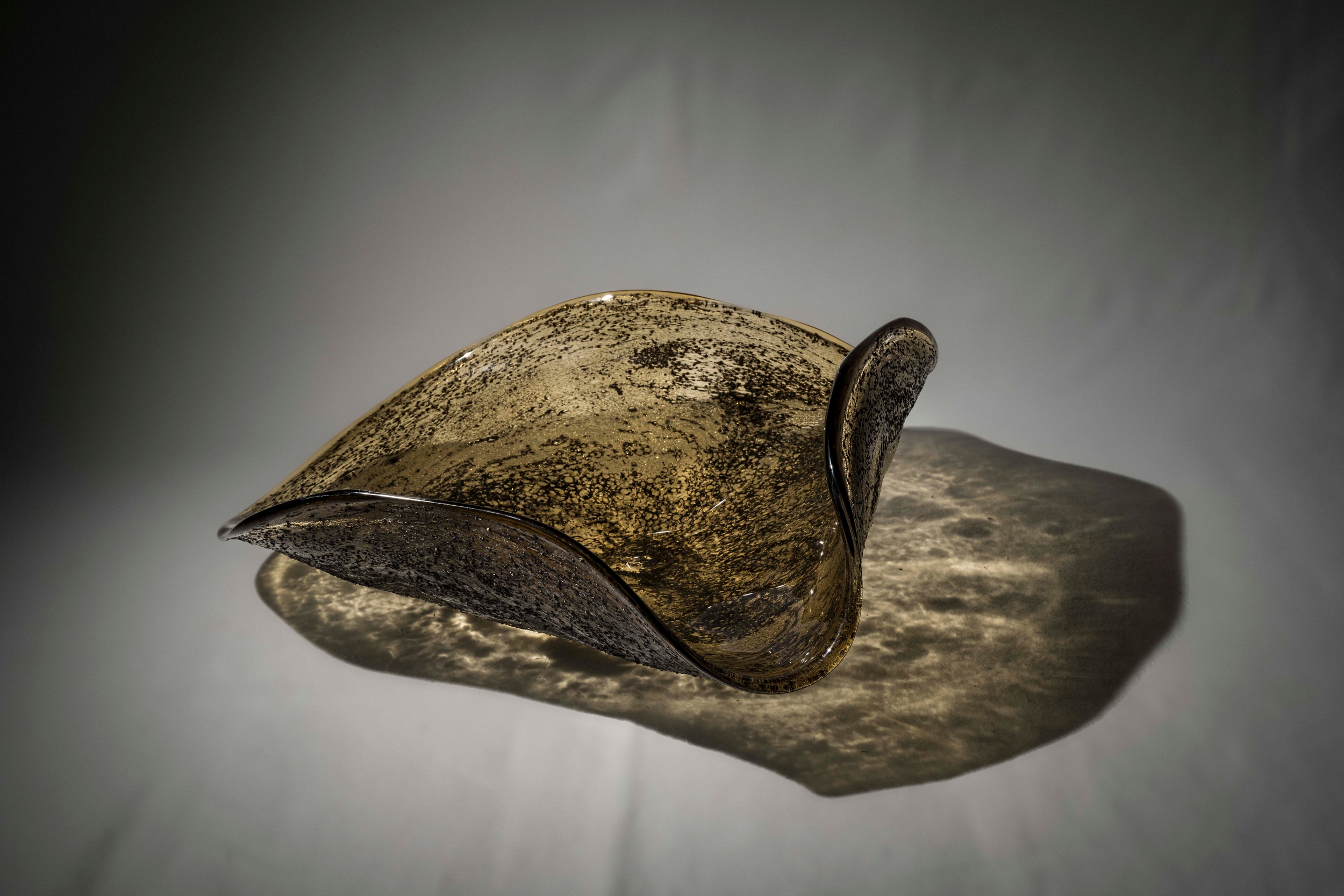

Left: BRICKLAB + 6:AM –– An Archive for Modern Glass, 2024. Photo by Edmund Sumner.
This illuminated 5-metre-tall column combines Bricklab’s ongoing research on modern development in Jeddah with 6:AM’s intimate knowledge of the Venetian glass industry.
The patterns, textures, and colours used in the glass panels reference Jeddah’s modernist buildings of the 1960’s to the 1990’s. This is a critical period in the region's history, often excluded from mainstream discourses on cultural heritage. As the region's oil economy flourished, a new material taxonomy emerged with unique structures of manufacturing, labour, and professional expertise. The work critically engages with the architecture that took shape during this transitional period.
The materials and forms of the era are reinterpreted as contemporary design pieces crafted by Italian master artisans in Venice. The patterns are extracted from photographic surveys, digitally traced, remodelled, and then cast into the glass using a variety of processes. Composed of over 400 individually cast glass panels, the sculpture is crafted by Italian master artisans, eloquently marrying traditional craftsmanship with contemporary innovation.
Right: TSAKHI –– Whispers from the Deep, 2024. Photo by Edmund Sumner.
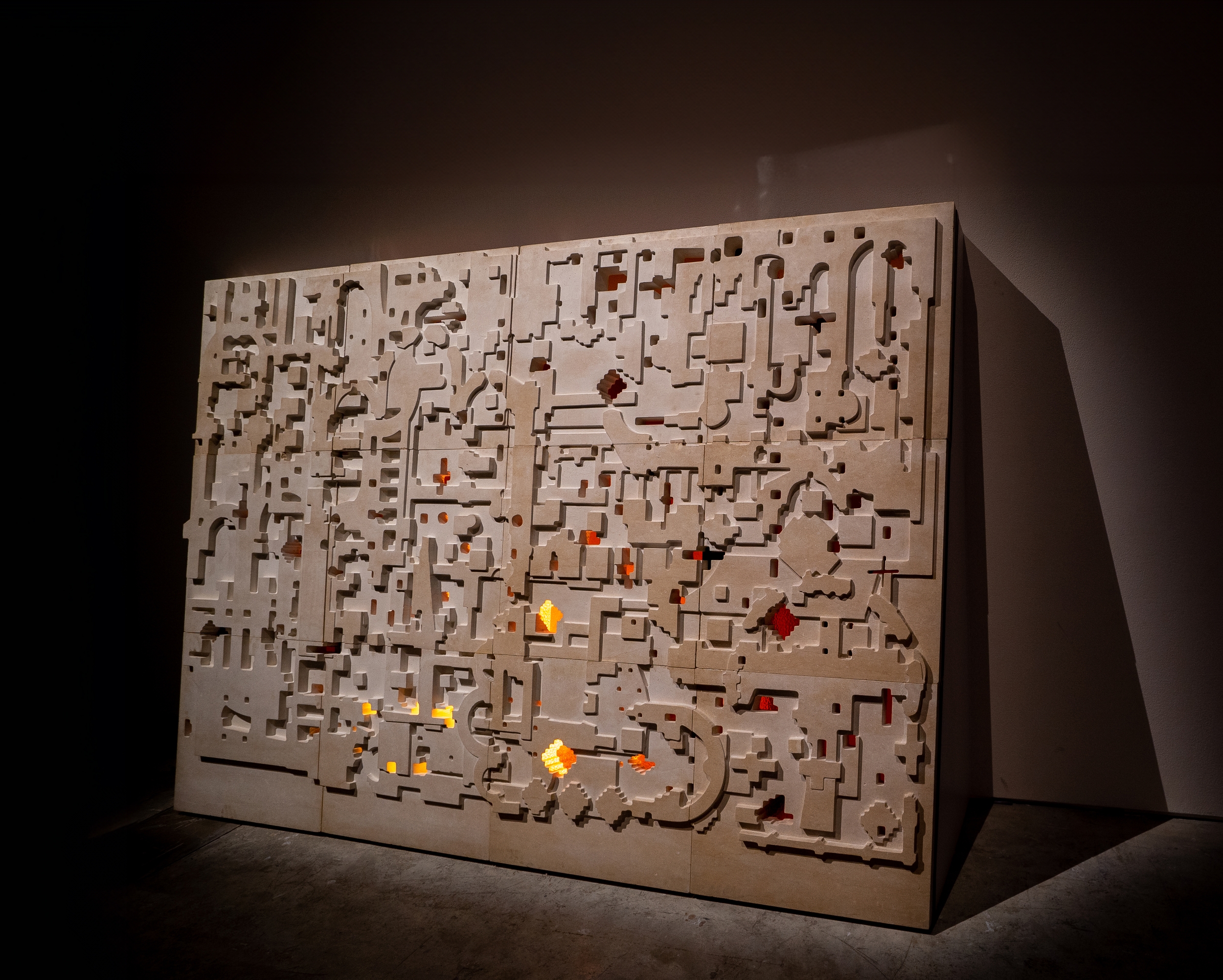
Dima Srouji –– Transparent Histories, 2024. Photo by Shaima Al Tamimi.
By diving deep into the forgotten history of glass in architecture, this freestanding wall partition depicts seminal architectural monuments that are often understudied and celebrates techniques of stone carving and glass inlay that have been employed in the Middle East for centuries. The room divider, itself an architectural element, becomes the storyteller through its material as well as its design.
The monuments are engraved and carved into the surfaces in a style drawn from Piranesi’s Campo Marzio map of Rome. Similar to how Piranesi flattened time and space by inventing his own monuments, inspired by archaeological sites in Rome, this map does the same for architectural monuments in Jerusalem, a city convoluted in its strata with layers of hidden narratives waiting to be excavated. The installation creates a speculative space, in which to tell an alternative spatial reality of the city from below.
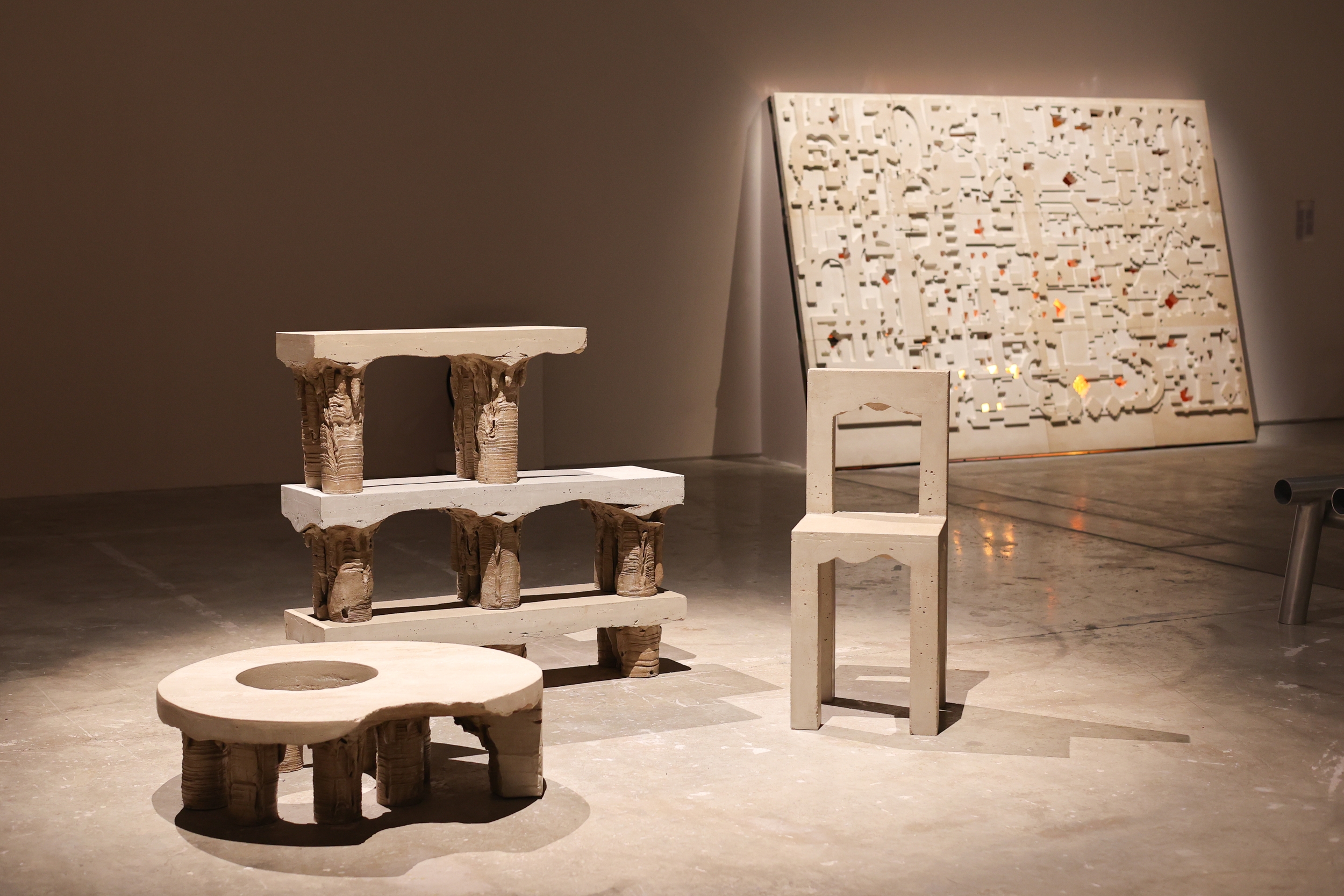
Christian Zahr Studio –– Concrete Memories Collection, 2021. Photo by Edmund Sumner.
These furniture pieces were developed during the 2020 pandemic, in a moment of warped temporality, where according to the designer, “memories of a ruinous past coincided with undecidable futures.” During the lockdown, the urge to return to nature provoked a rethinking of the relationship between humans and interiors. Zahr envisioned homes transformed into caves, and rooms into intimate primitive landscapes.
These objects are handmade but textured by nature by means of drops of water. The objects are an agglomeration of the unpredictable and the predesigned, with forms that are at once archetypal and fictional, archaeological and geological.

Naqsh Collective –– Green Bridal Chest, The Shawl, 2023. Photo by Edmund Sumner.
Traditionally, bridal chests were integral to any wedding ceremony, and accompanied new brides as they prepared for their new homes. This bridal chest was created in celebration of the designers’ niece and was embroidered with traditional Palestinian patterns depicting flora and fauna in the region. The selected patterns have been compiled through a process of diligent research and documentation of Palestinian heritage. Reacting to the threat of erasure of this craft, the designers make works that eternalize these patterns in stone.

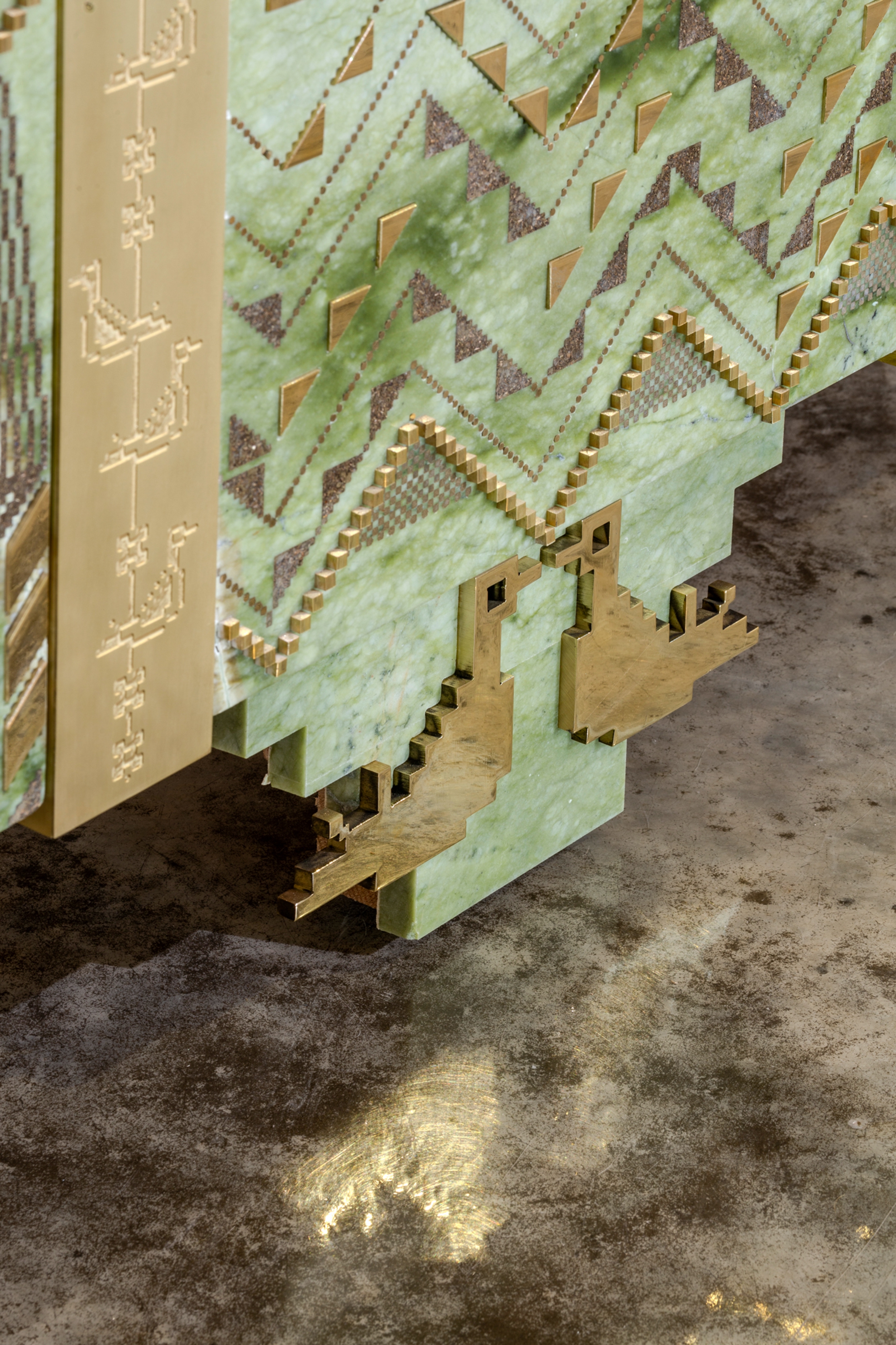
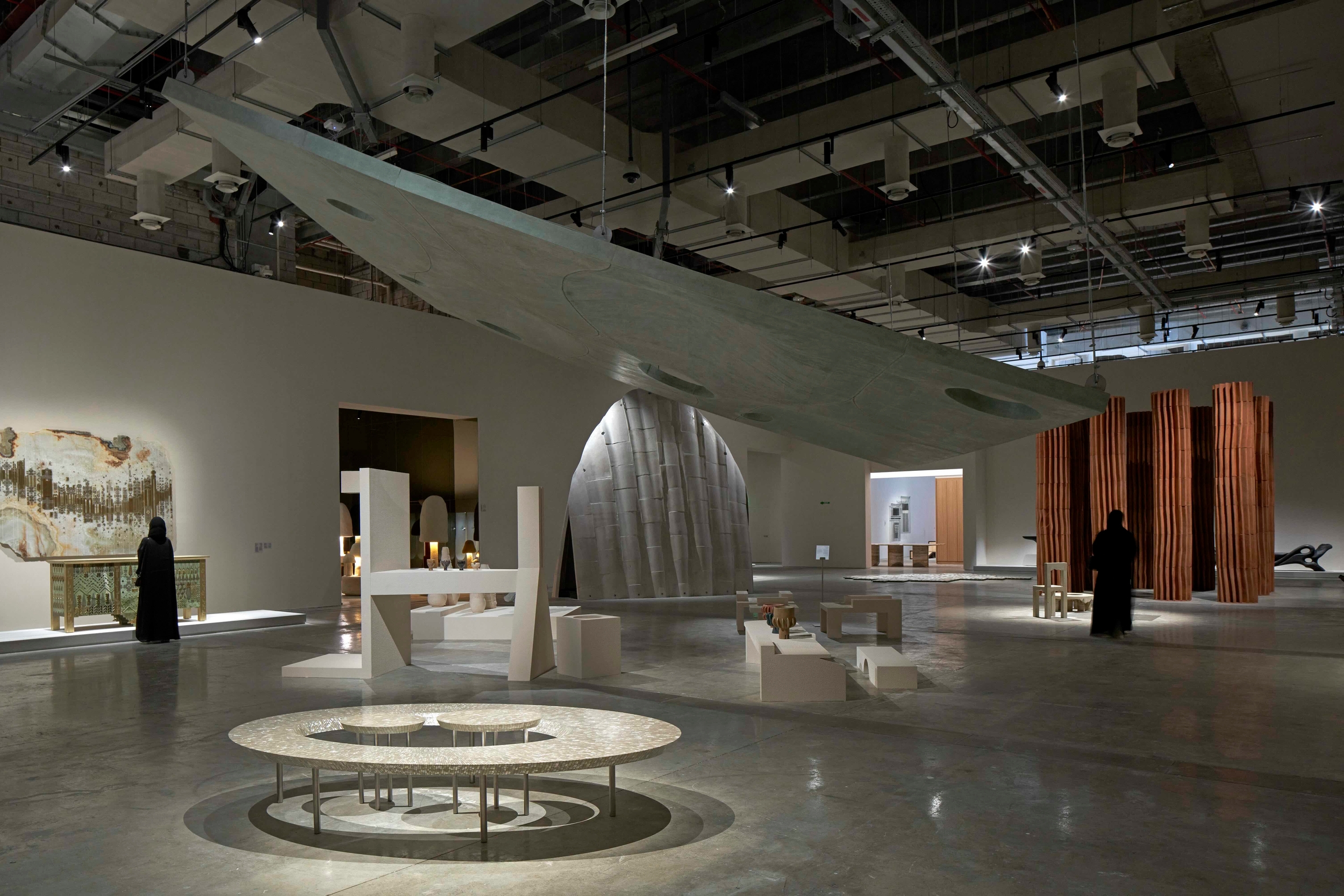
Arab Design Now –– Design Doha Biennial 2024. Photo by Edmund Sumner.
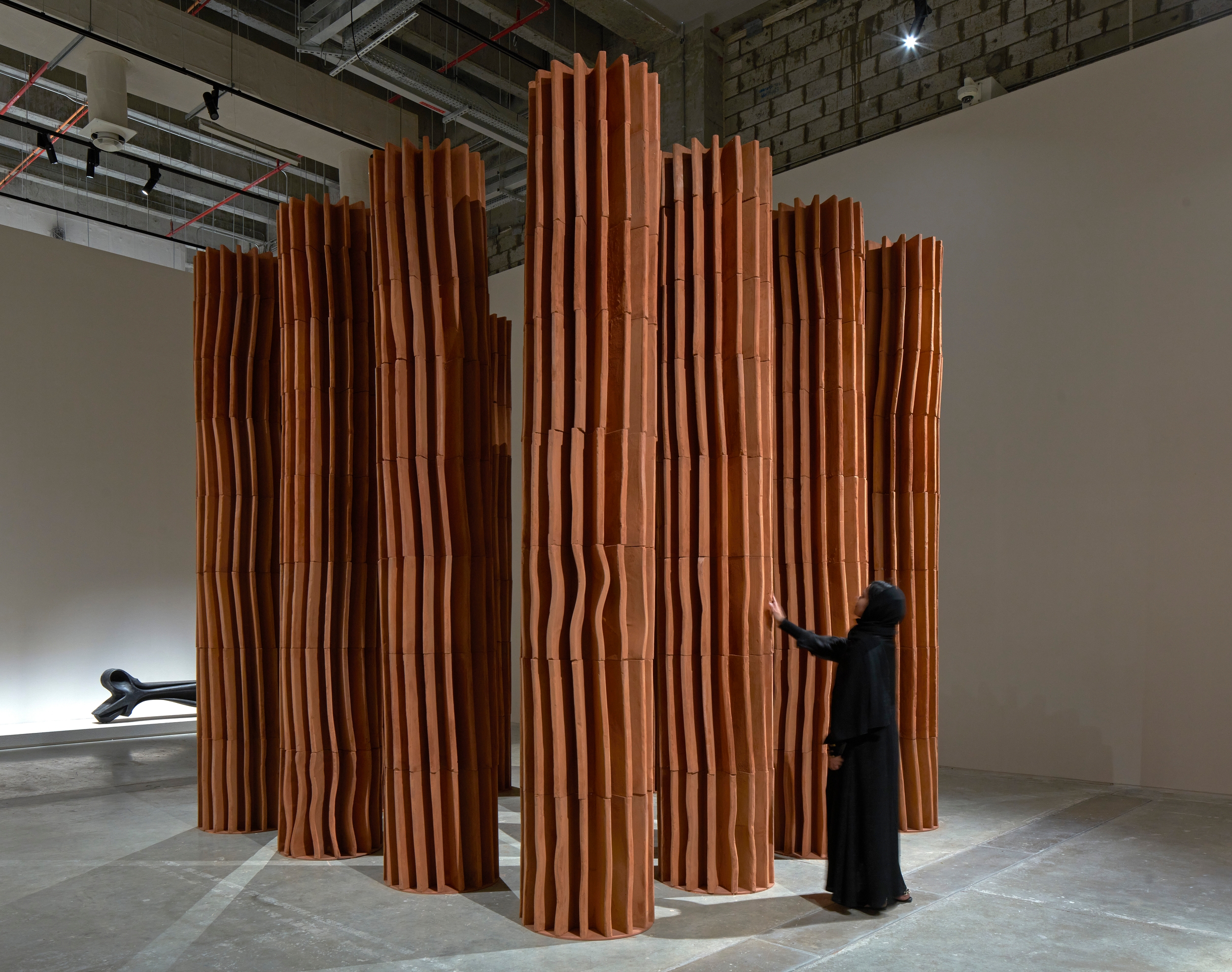
Sahel Alhiyari –– Eleven, 2024. Photo by Edmund Sumner.
Eleven fluted columns are erected from vertically stacked hand-crafted terra cotta segments. Conjuring orders of classical antiquity, yet underscoring the vitality of contemporary materiality and technique, the columns rely on moulding and forming rather than cutting and carving as was typical in ancient architecture. The craftsmanship, with its adobe-like malleability, recalls techniques used to make pottery, and showcases texture and imperfection as integral outcomes.
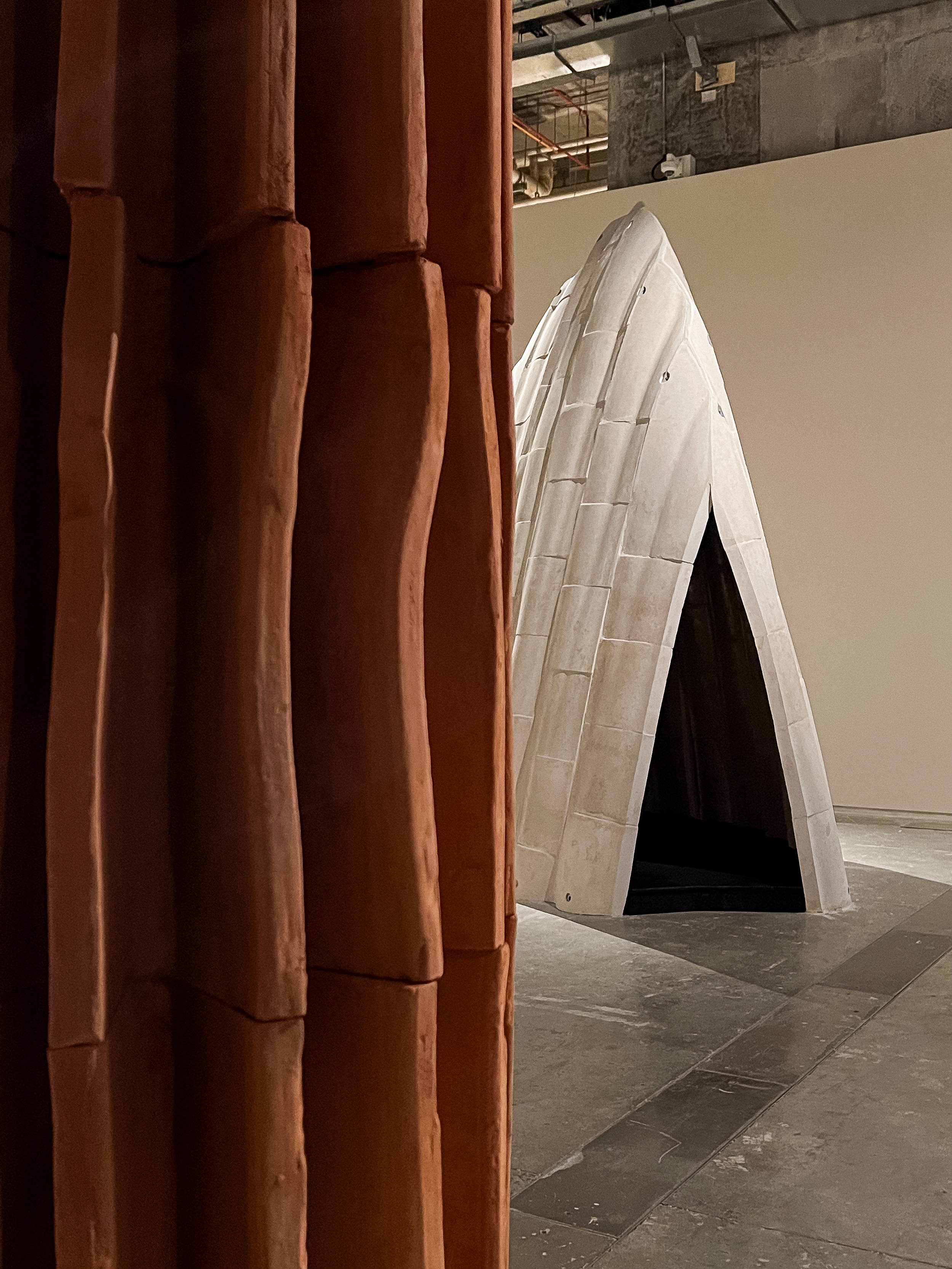
AAU Anastas –– Tiamat, 2024. Photo by Tala Alhaj.
Tiamat is the latest iteration of the Stone Matters, a research project which studies the possibilities of combining historical stone building methods with modern technologies to promote the use of structural stone. Through a study of techniques, forms, and theoretical and natural principles, the architects suggest new ways of using stone in contemporary architecture.
Tiamat morphs the Gothic-inspired structural systems and pointed arches found across Palestine, Syria and Lebanon to create an architectural enclosure. The internal atmosphere of the space is unique to stone construction in terms of light, sound reverberations, climate control, and texture. Inspired by the intrinsic geometry of desert sand dunes, the installation structure rises to a vault on structural ribs.
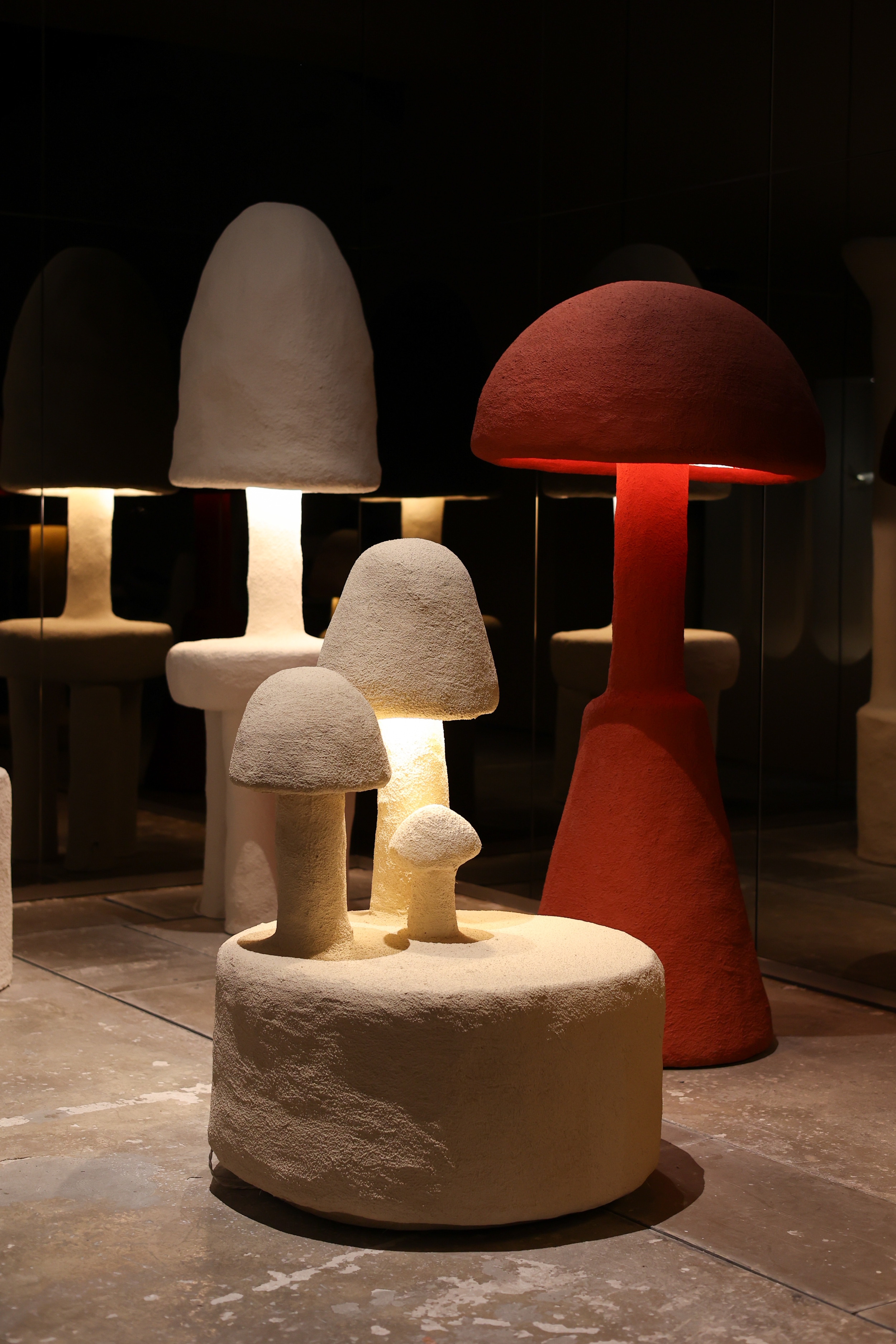
Mary-Lynn & Carlo –– Shiitake, 2023. Photo by Abdelaziz Alsafadi.
Shiitake is an installation inspired by the fungi, which thrives in the most unexpected places. An ode to the interplay of reality and fantasy, the creation comprises five floor lamps of varying sizes and forms. The artists envision new strains of mushrooms with soul-nurturing properties—antioxidants for heartbreak, vitamins for self-assurance, and sources of contemplation of nature's unexpected wonders.
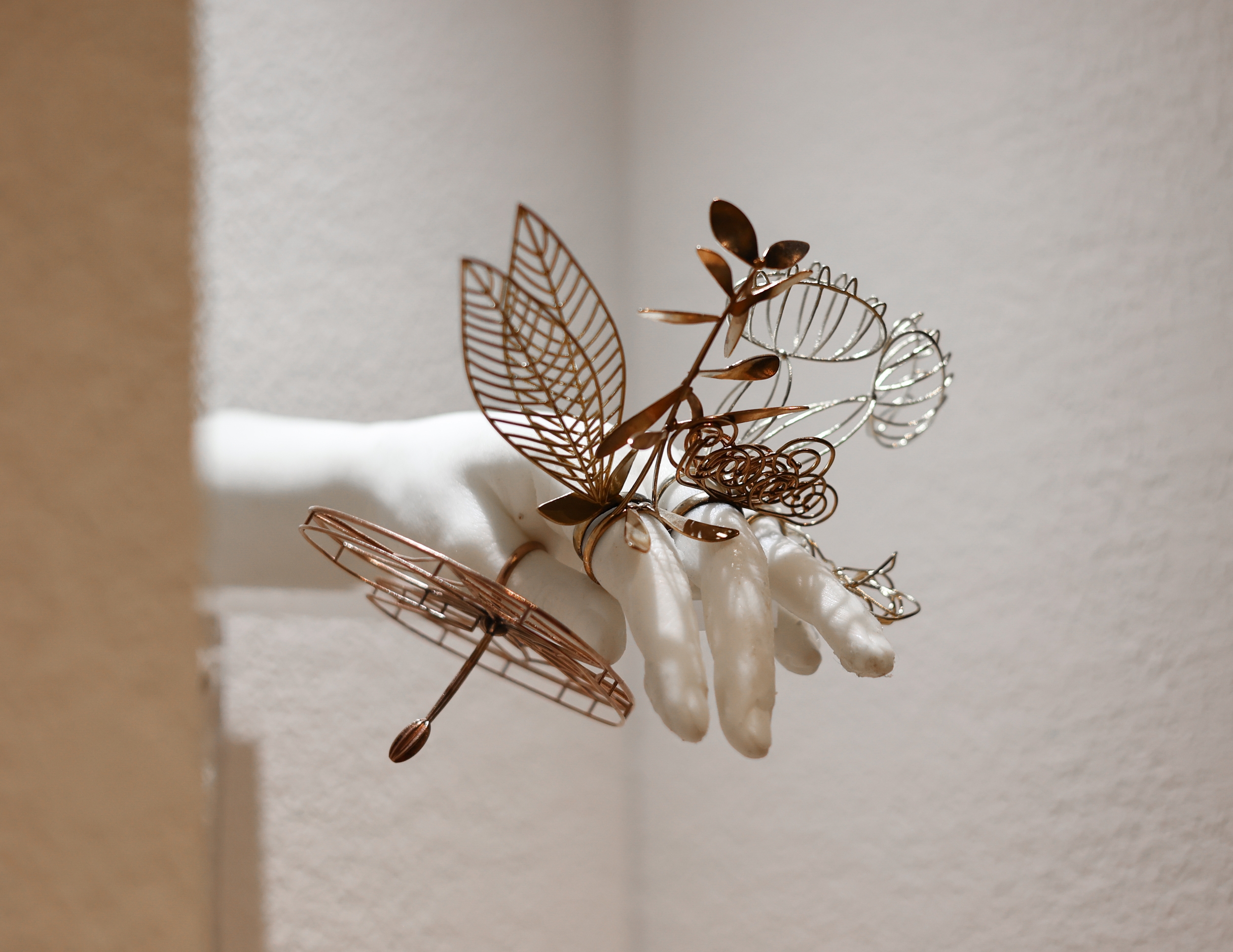
Architects Independent –– The Plant & Weed Rings, 2022-23. Photo by Abdelaziz Alsafadi.
This collection of wearable artefacts is inspired by the flowers, grasses, weeds, and trees of Doha. They challenge conventional notions of how jewellery is worn, perceived, classified, and valued. The designs were fabricated through the lost-wax-casting process, utilising 3D printed models.



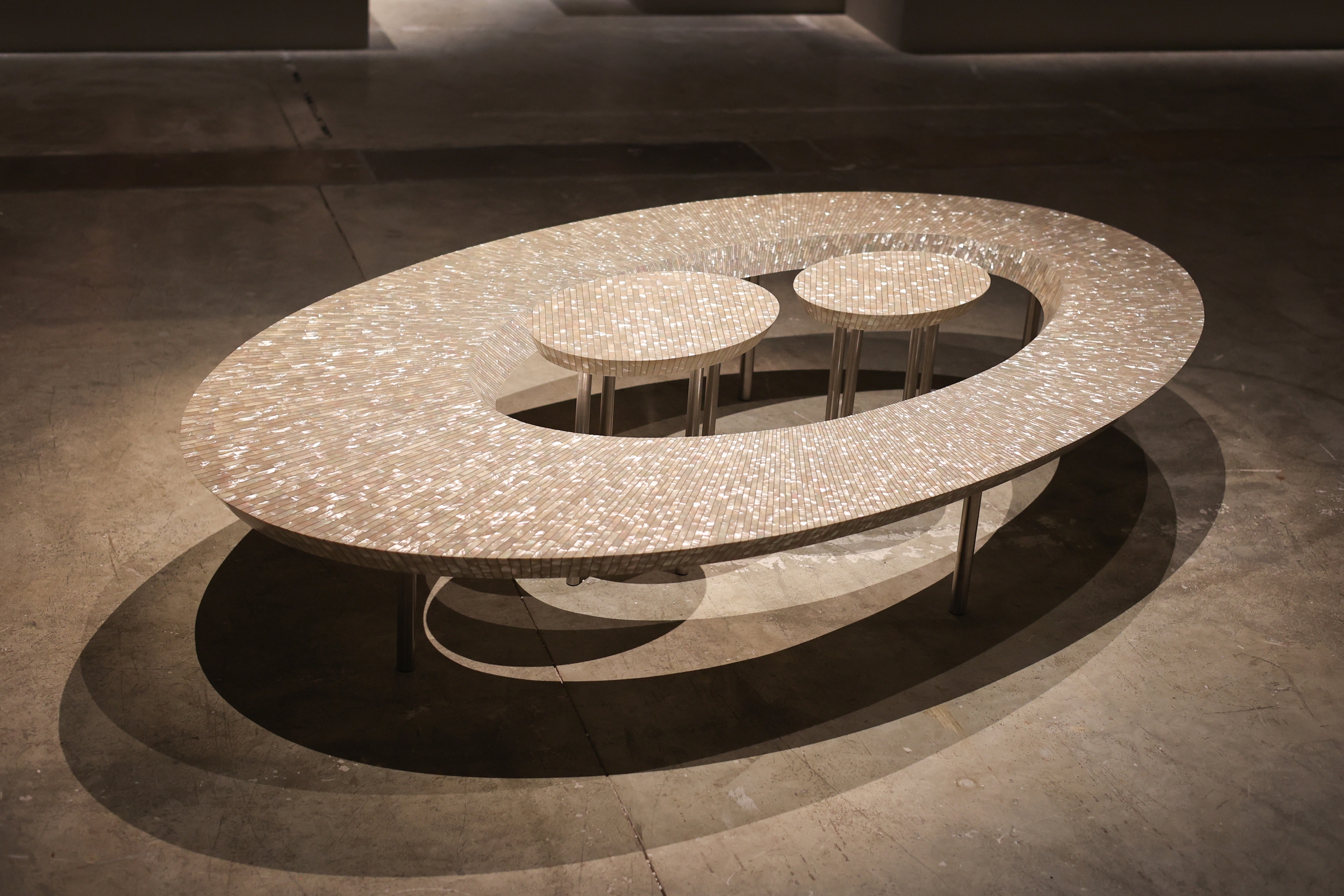
Studio Nada Debs –– The Bling Bling Coffee Bean Table, 2013. Photo by Abdelaziz Alsafadi.
The Bling Bling Coffee Bean Table is a variant of Studio Nada Debs' classic Coffee Bean Table. It features an opulent inlay of 90 kilograms of mother-of-pearl, every piece set by hand and seamlessly integrated into the wood of the table. This labour-intensive craft was prevalent during the Ottoman era, and purposefully revived and taken further in this piece.
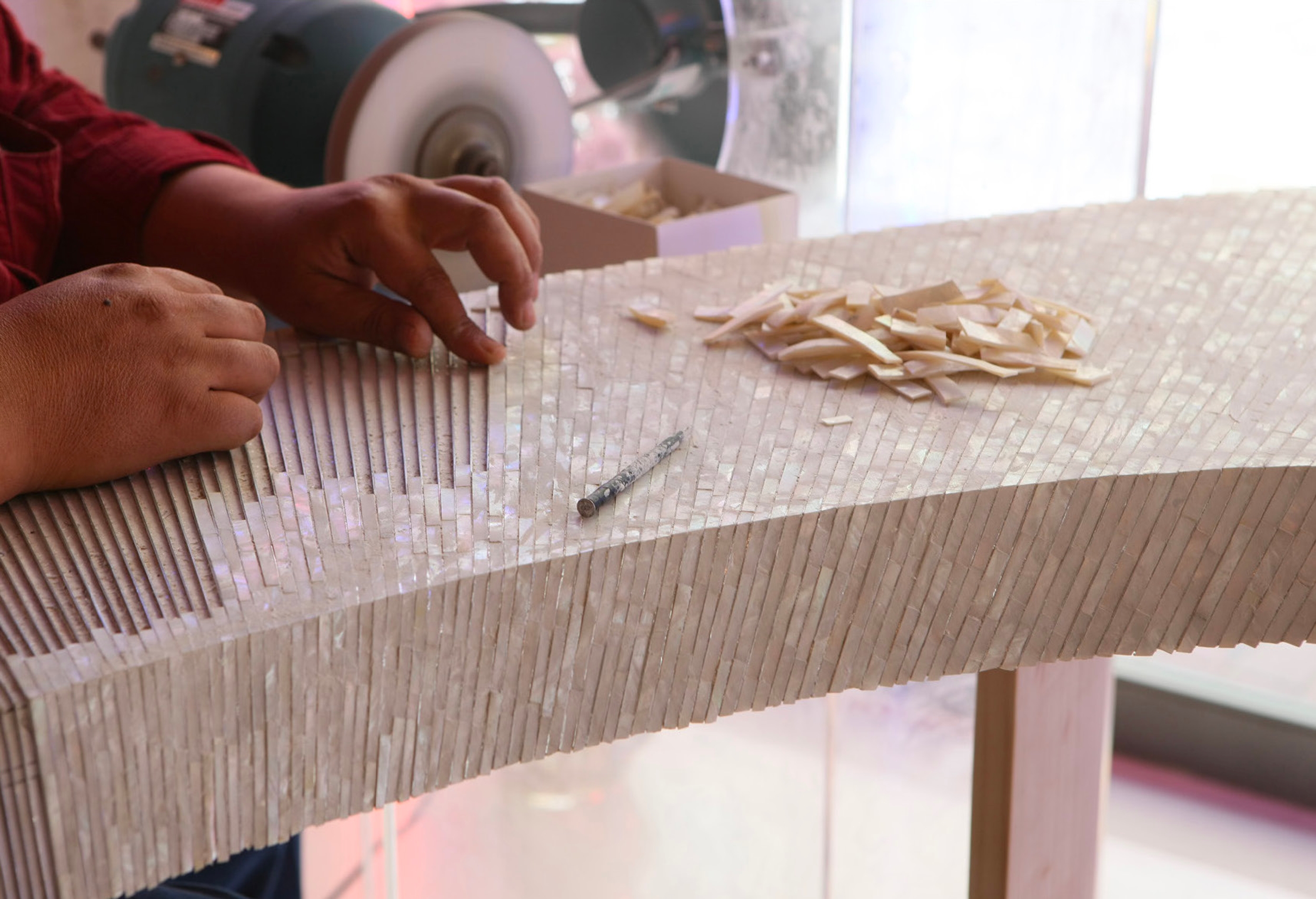

Maryam Al-Homaid –– El Bebat (The Construction Pipes), 2023. Photo by Edmund Sumner.

Mohammad Sharaf –– After the End, 2024. Photo by Abdelaziz Alsafadi.
This wall of “brickbooks” represents a form of contemporary archaeology. The books contain photographs of abandoned places in Kuwait, going back fifty years. Many of these places and objects, along with their stories and history, no longer exist, while others are disappearing all the time due to negligence or gentrification. The chapters of the book are divided based on location: schools, police stations, palaces, houses, apartments, islands, hospitals, and storage facilities.
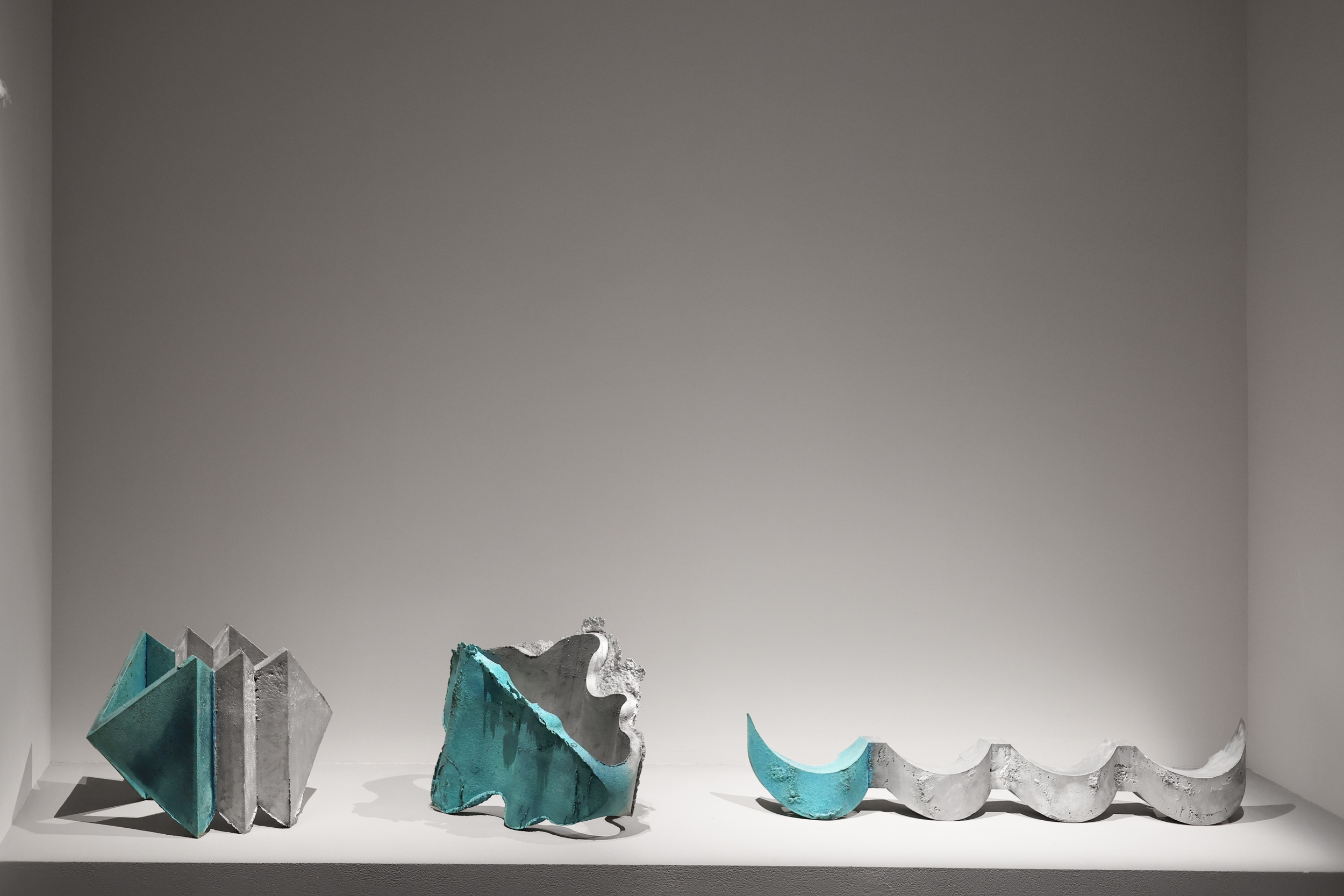
Desert Cast –– Towards an Identity, 2023. Photo by Abdelaziz Alsafadi (left) and by Tala Alhaj (right).
These sand-cast aluminium pieces are presented as a critical alternative to the kitsch architecture motifs that have permeated Kuwait’s buildings. According to designers Jassim AlNashmi and Kawther Alsaffar, the replication of such imported classical motifs creates a disingenuous sense of luxury and contributes to Kuwait’s struggle to develop a context-based identity. By re-applying borrowed regional elements and hybridised motifs from Kuwait, Desert Cast suggests an alternative practical scenario of how the phenomenon of identity could continue to evolve.
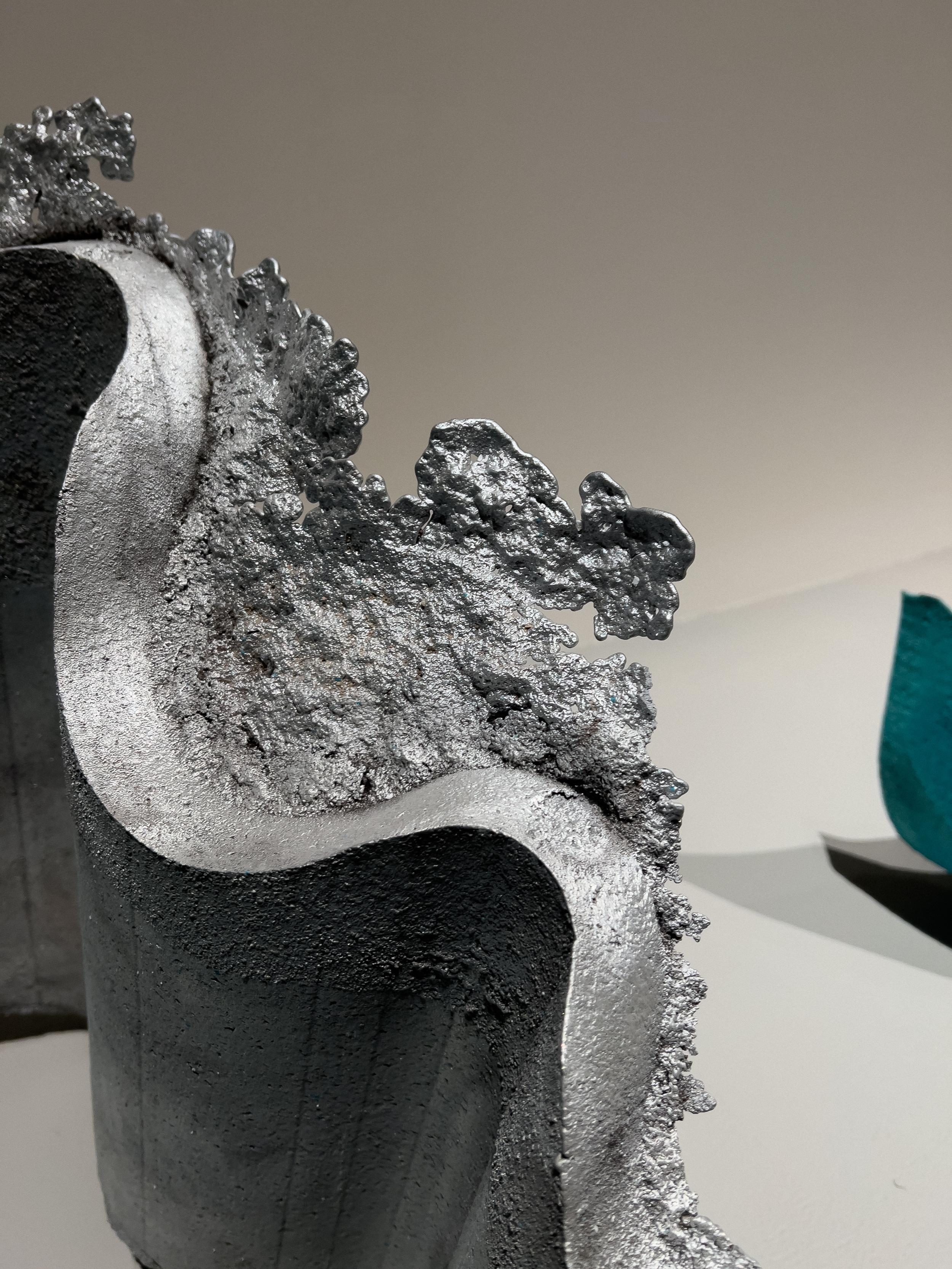
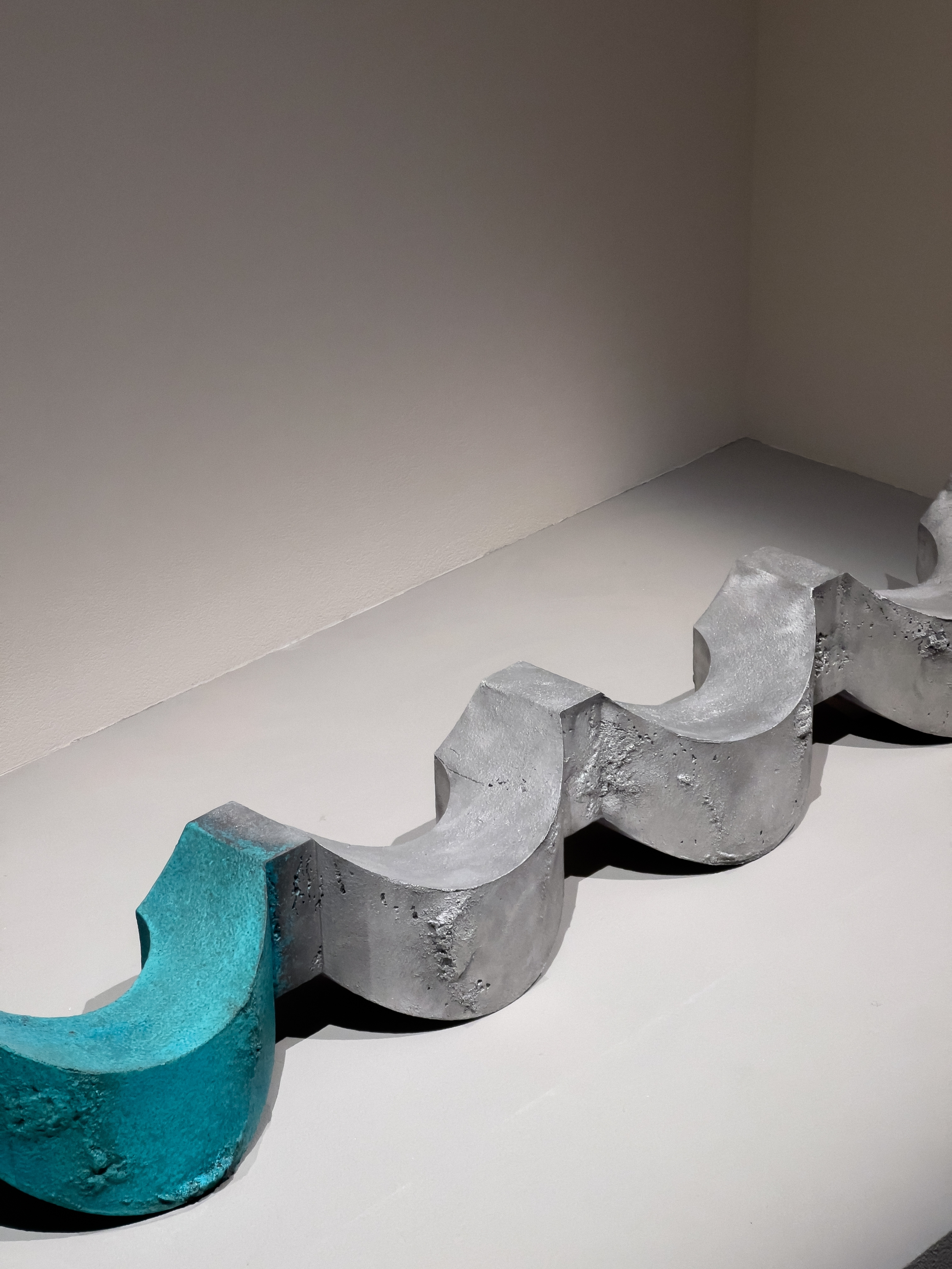
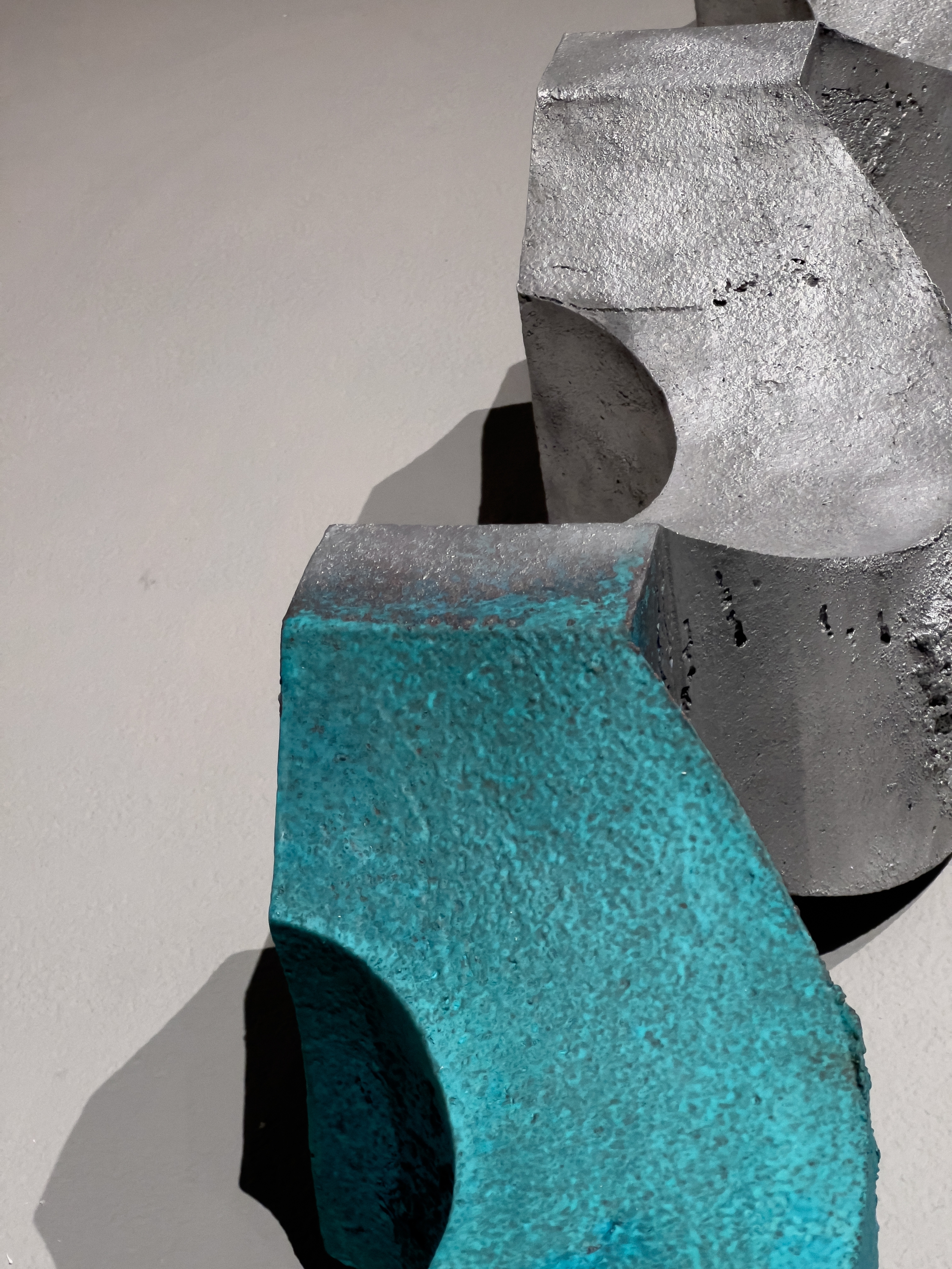
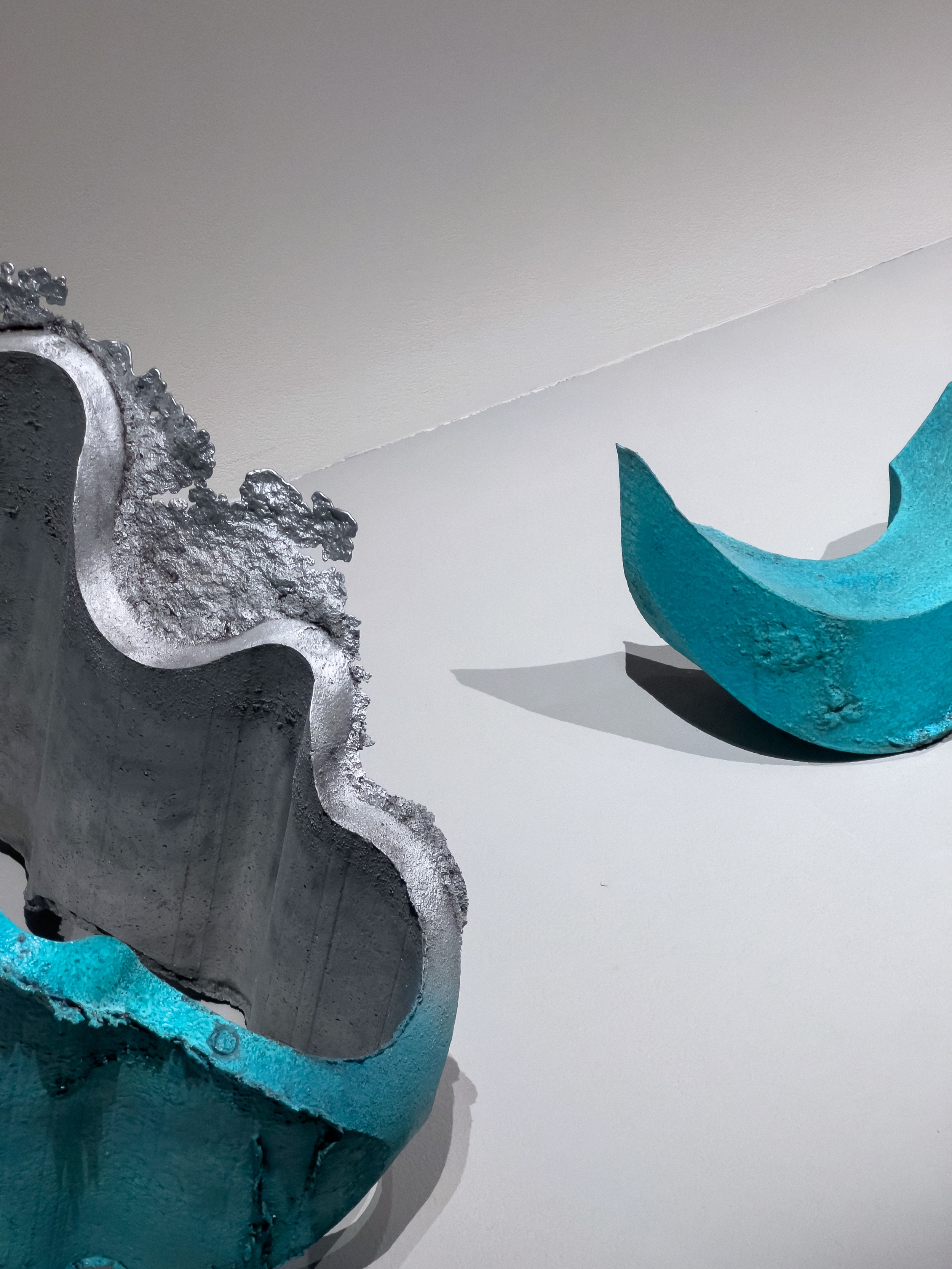
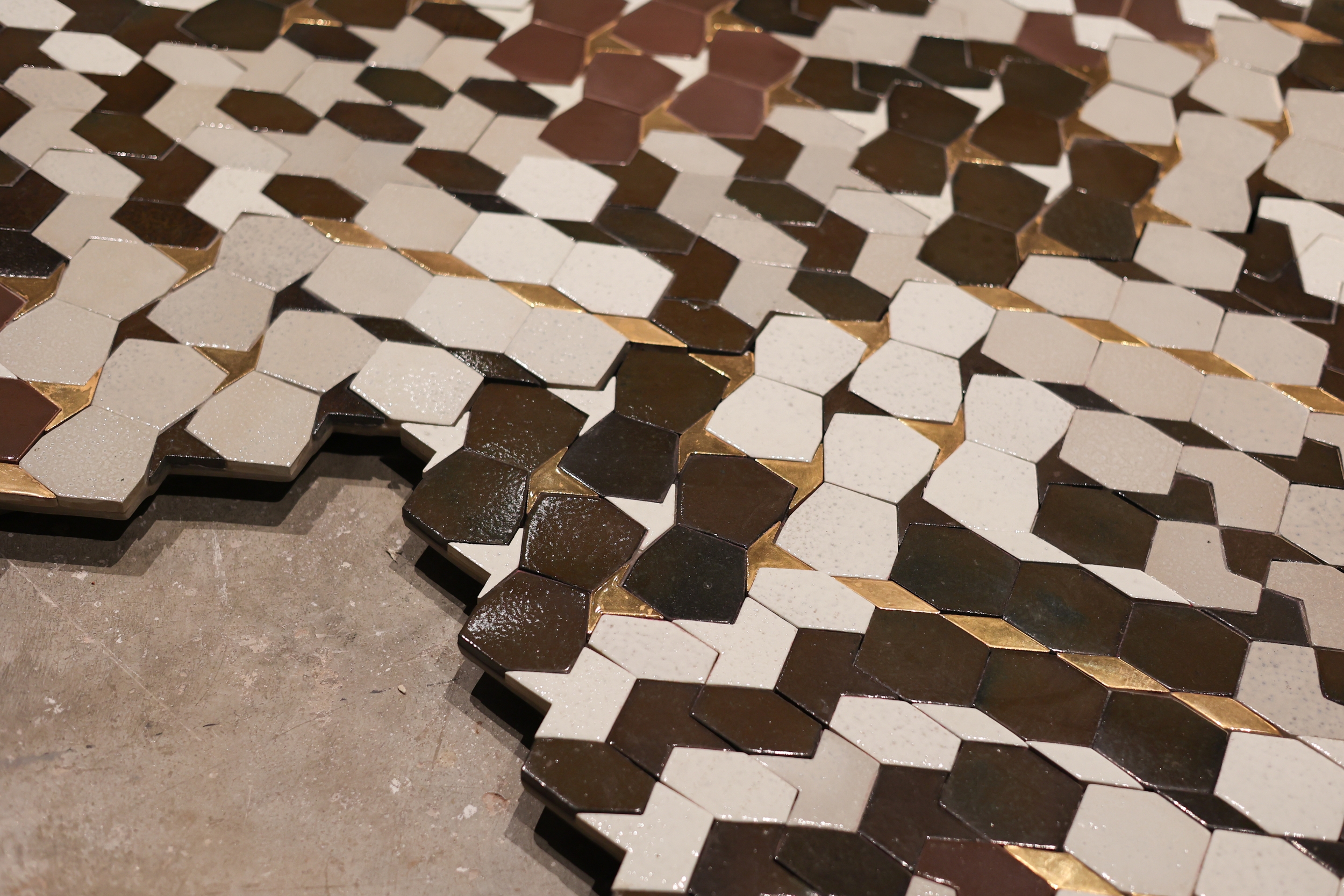
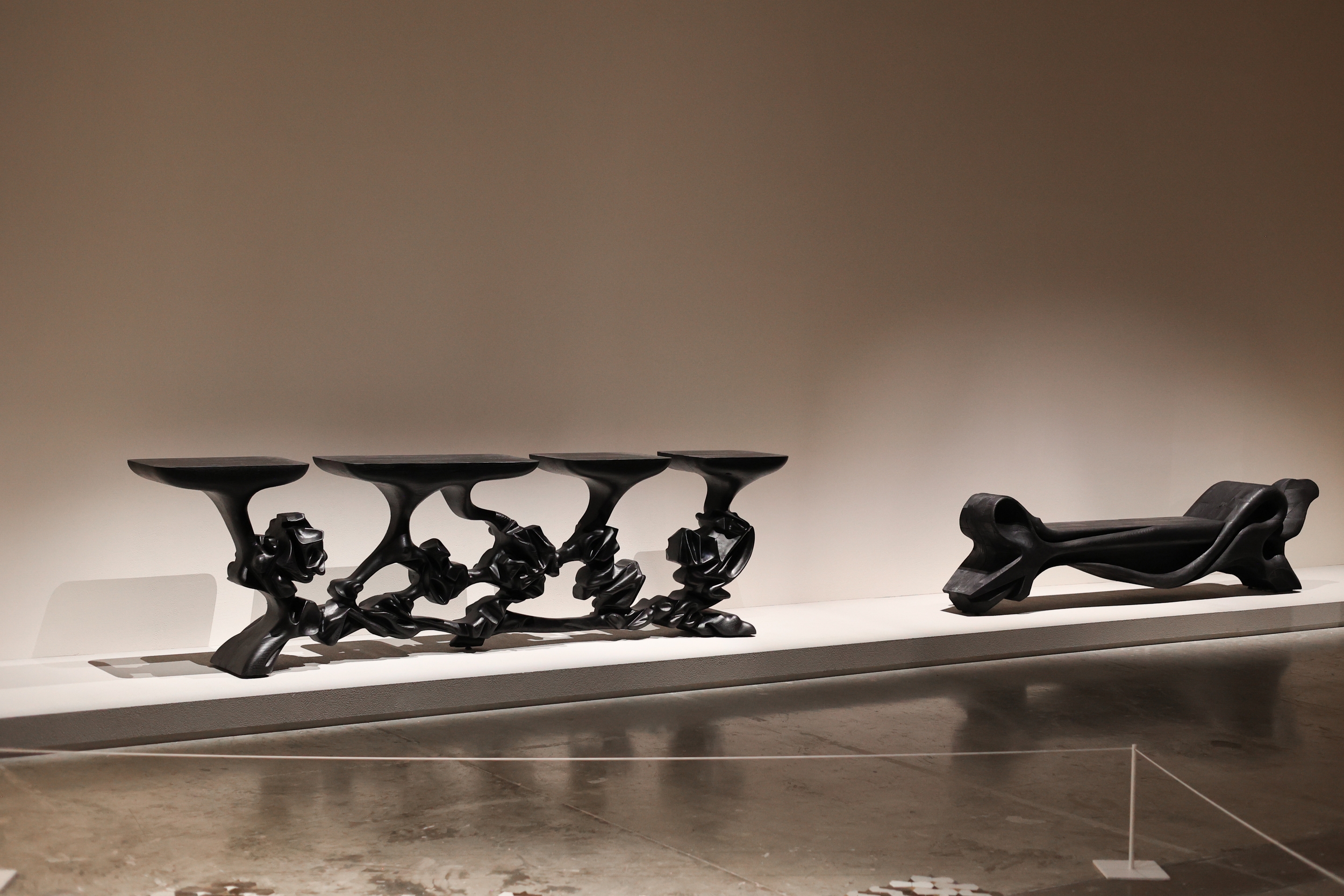
Hamza Kadiri for Ateliers Courbet –– Sculptural Console AM7V1-3, 2023, Bench 01, 2022. Photo by Abdelaziz Alsafadi.
This sculptural console is entirely hand-carved by Kadiri. In a process that unites two opposite forces, one seemingly destructive, the other restorative, the wood is first exposed to sudden bursts of flame, then brushed smooth as it cools.
Inspired by mythology and classical art, this bench features bold curves and textured surfaces achieved through the traditional Japanese Shou-Sugi-Ban technique, a process by which wood is cut into planks, dried in the sun or open air, burned on the surface to create a thin layer of char, then brushed and sealed. The piece is finished with beeswax, emphasising the natural grains and patterns of the solid ash wood.
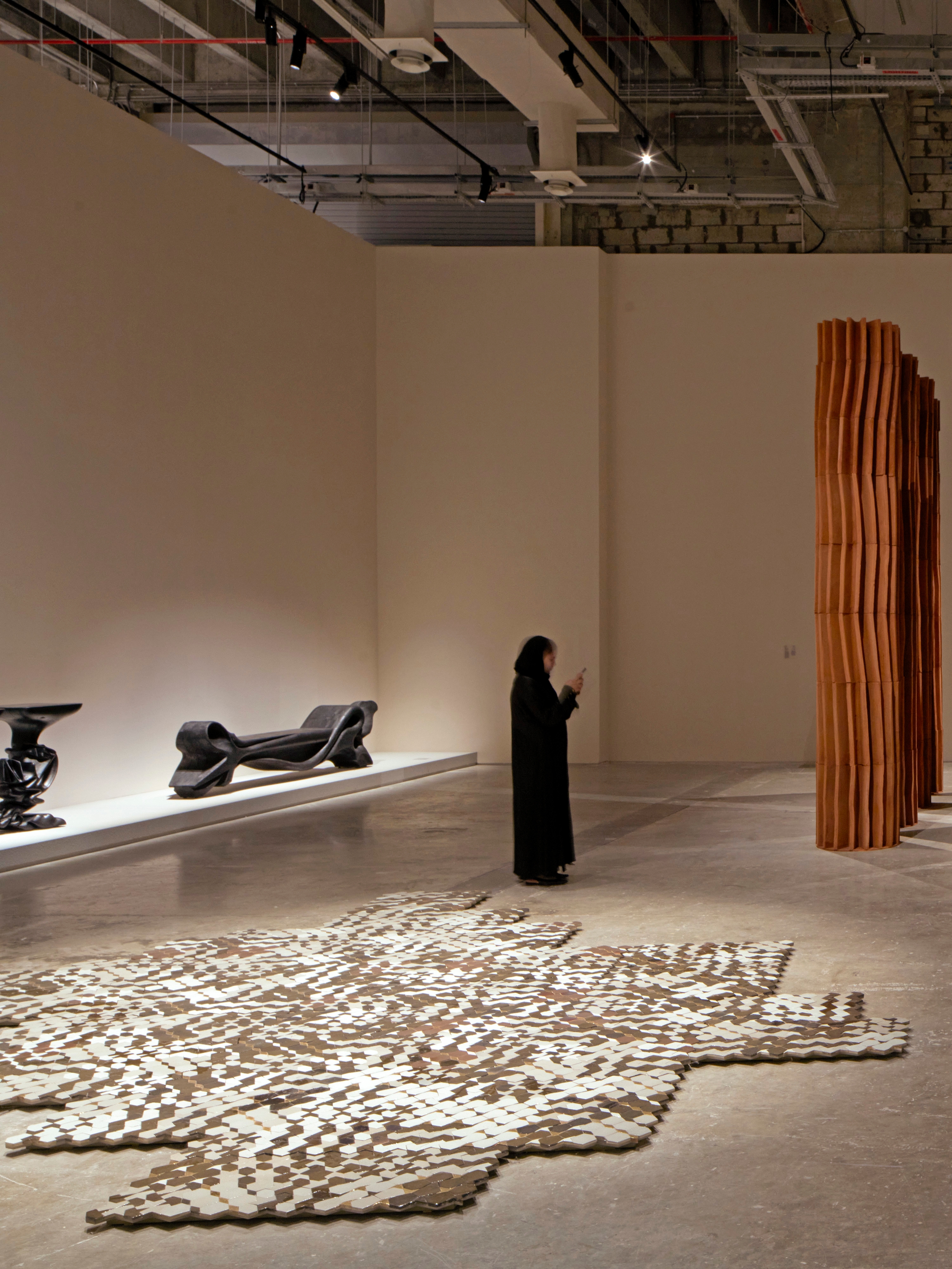
Amine Asselman –– Metamorphosis, 2024. Photo by Abdelaziz Alsafadi.
Metamorphosis is a geometric research project that arises from the artist’s doctoral thesis on Tetouan Zellige, a unique artisanal technique in Morocco which has been classified by UNESCO as threatened to disappear. In his thesis, Amine Asselman developed a mathematical method to generate an infinite number of geometric figures based on the same rhythm. The hand-cut ceramic tesserae, glazed with mineral oxides and assembled with resin, create a body with an organic quality despite being composed entirely based on arithmetic permutations.
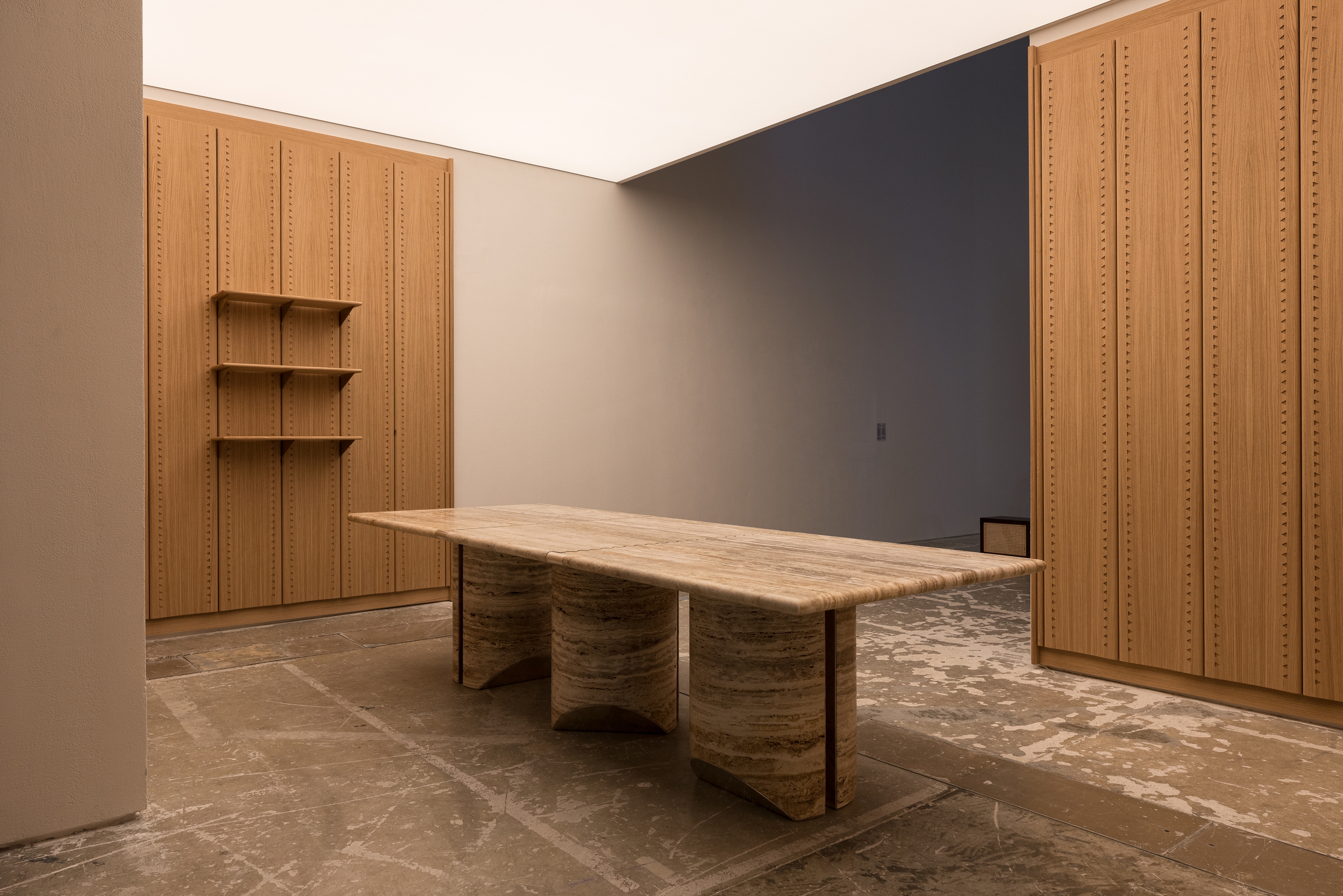
david/nicolas –– Constellation C080, 2018 and Boiserie, 2024. Photo by Edmund Sumner.
Constellation C080 dining table is a piece from david/nicolas's Supernova collection. Crafted from travertine slabs and adorned with intricate esoteric brass symbols, it stands as a testament to the designers’ deep fascination with the cosmos. The table is coupled with david/nicolas's boiserie system of wall cladding.
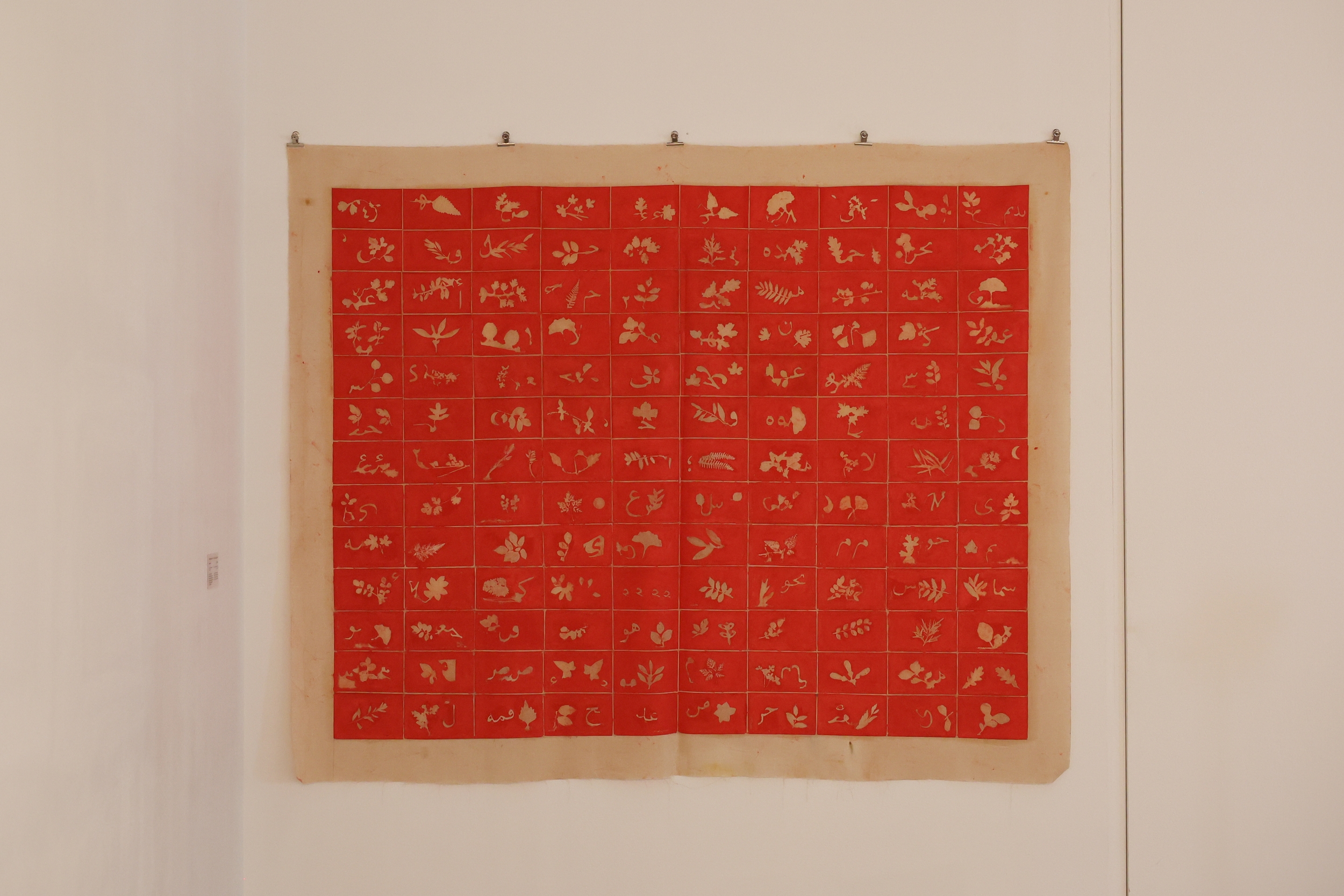
Nedim Kufi –– The Red Keyboard, 2023. Photo by Abdelaziz Alsafadi.
As its name implies, this printed textile introduces a new speculative language for digital communication based on plant materials foraged from daily walks in the garden.
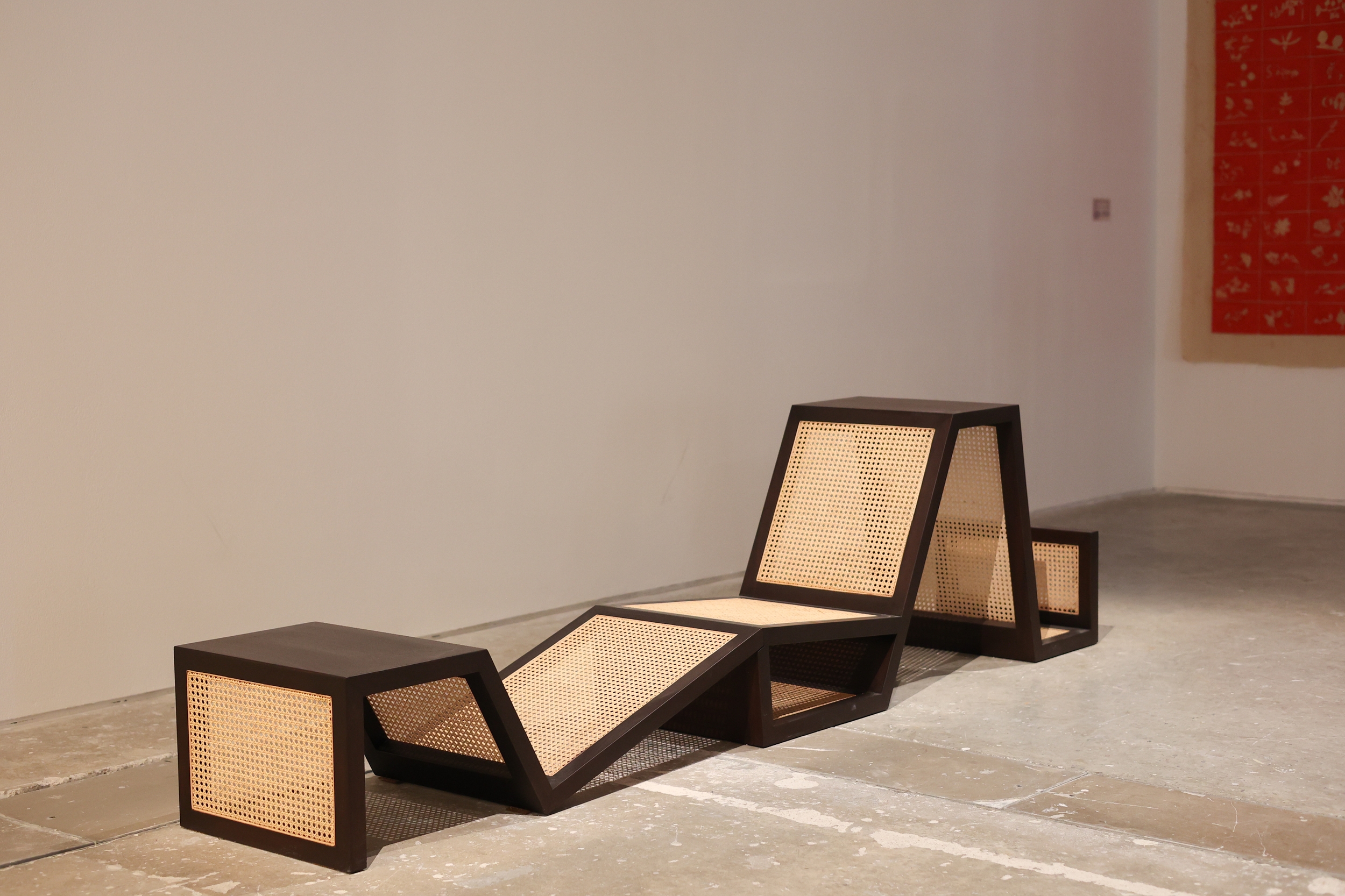
Karen Chekerdjian Studio –– Living Space III, 2010, photo by Abdelaziz Alsafadi.
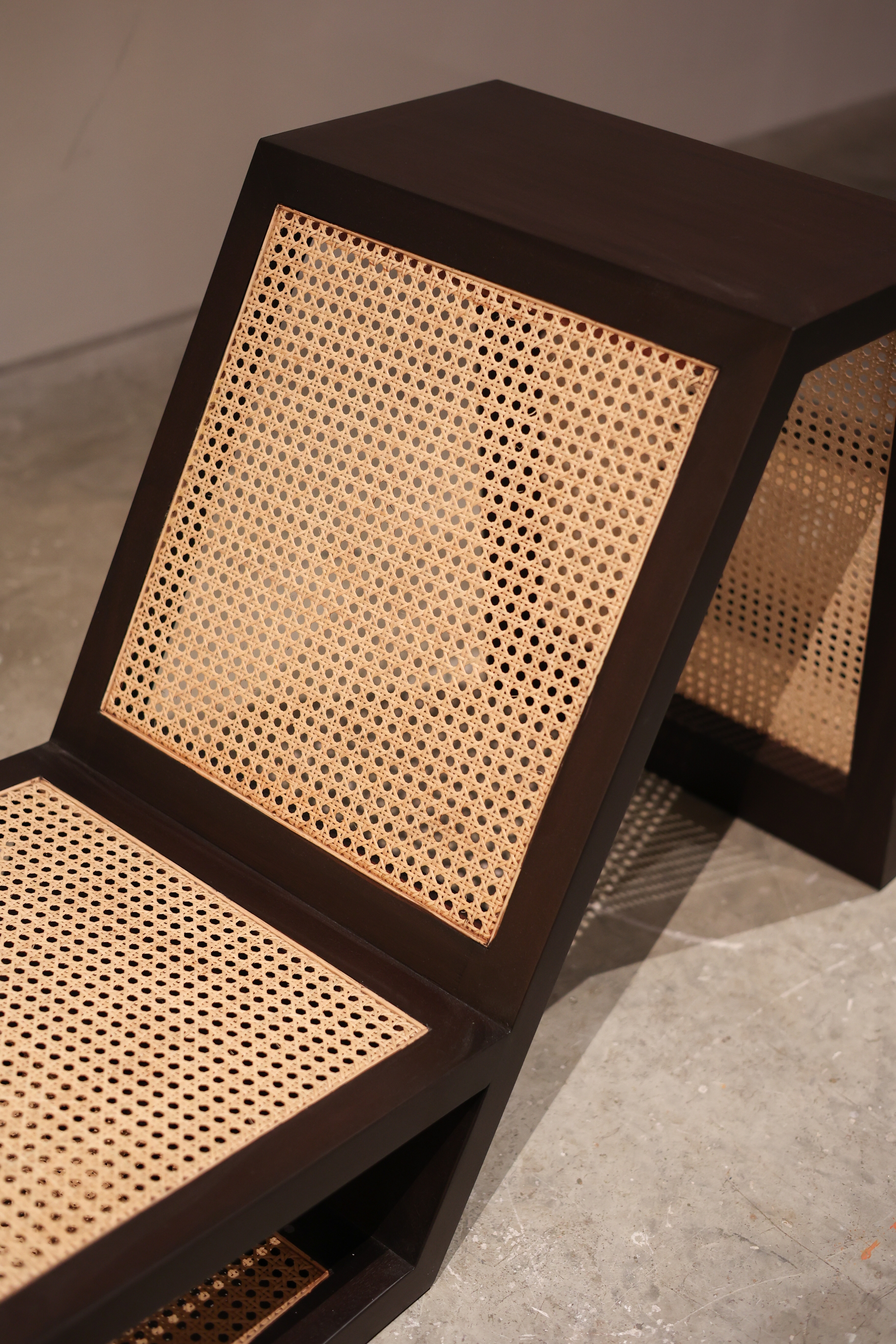

Arab Design Now –– Design Doha Biennial 2024. Photo by Edmund Sumner.
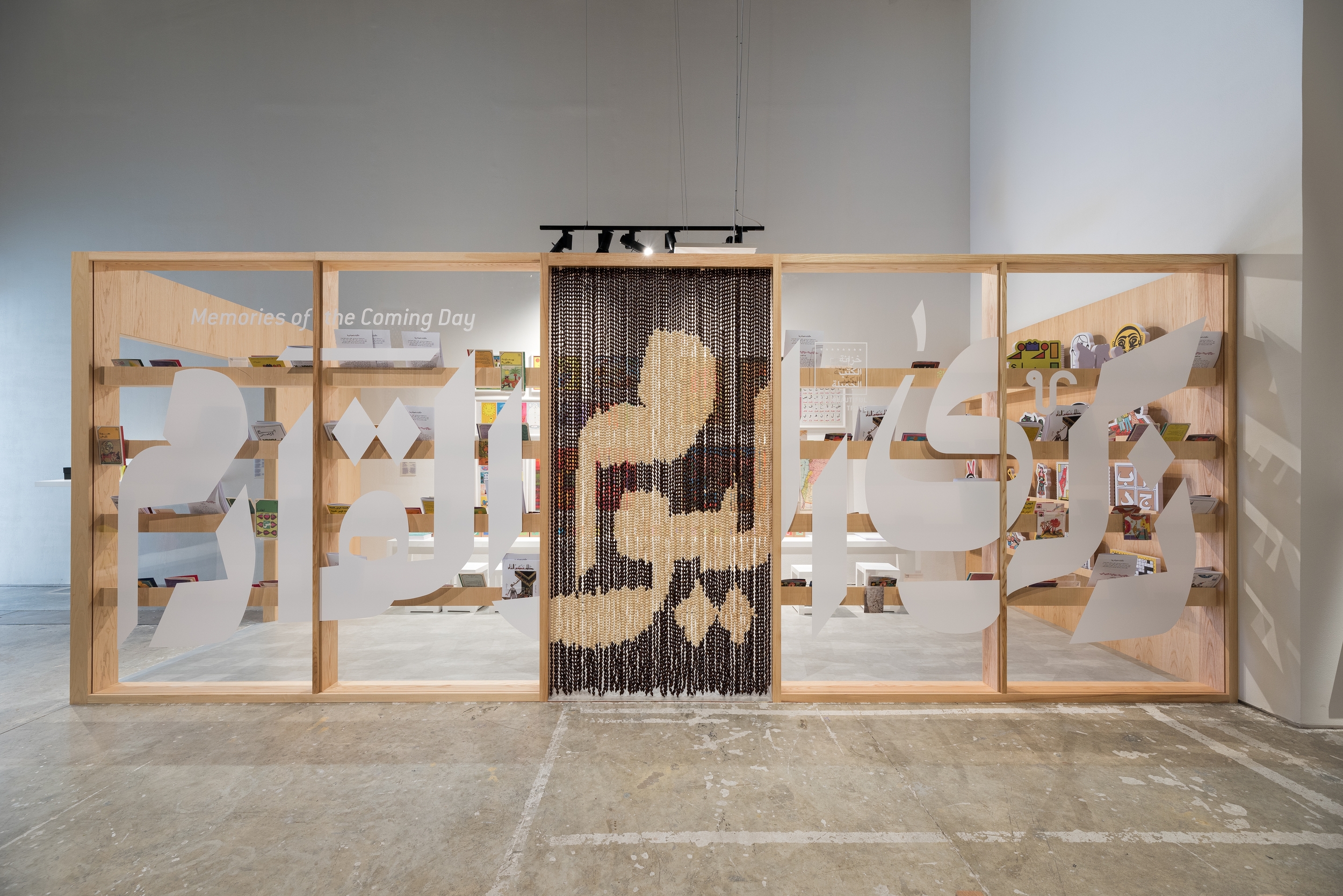
Hussein Alazaat –– The Beautiful Books Trove, 2024. Photo by Julian Velasquez.
An homage to modern-era graphic design and typography from the Arab world, this installation draws from Hussein Alazaat’s ‘The Beautiful Books Trove,’ a project currently housed in Amman, Jordan to create an educational space for children. Alazaat’s space offers a curated selection of reproductions of children’s publications from the 1960s, ‘70s, and ‘80s.
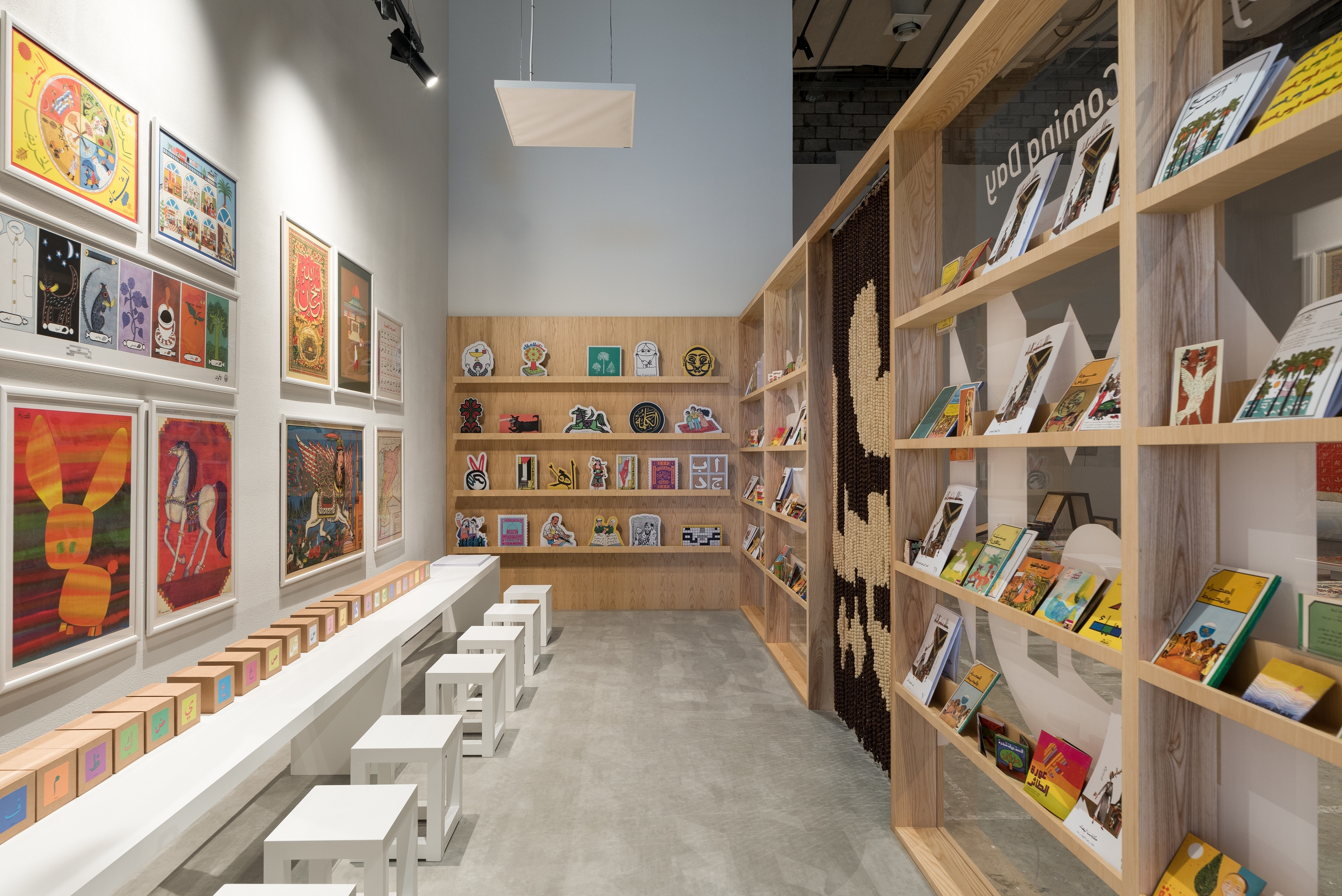
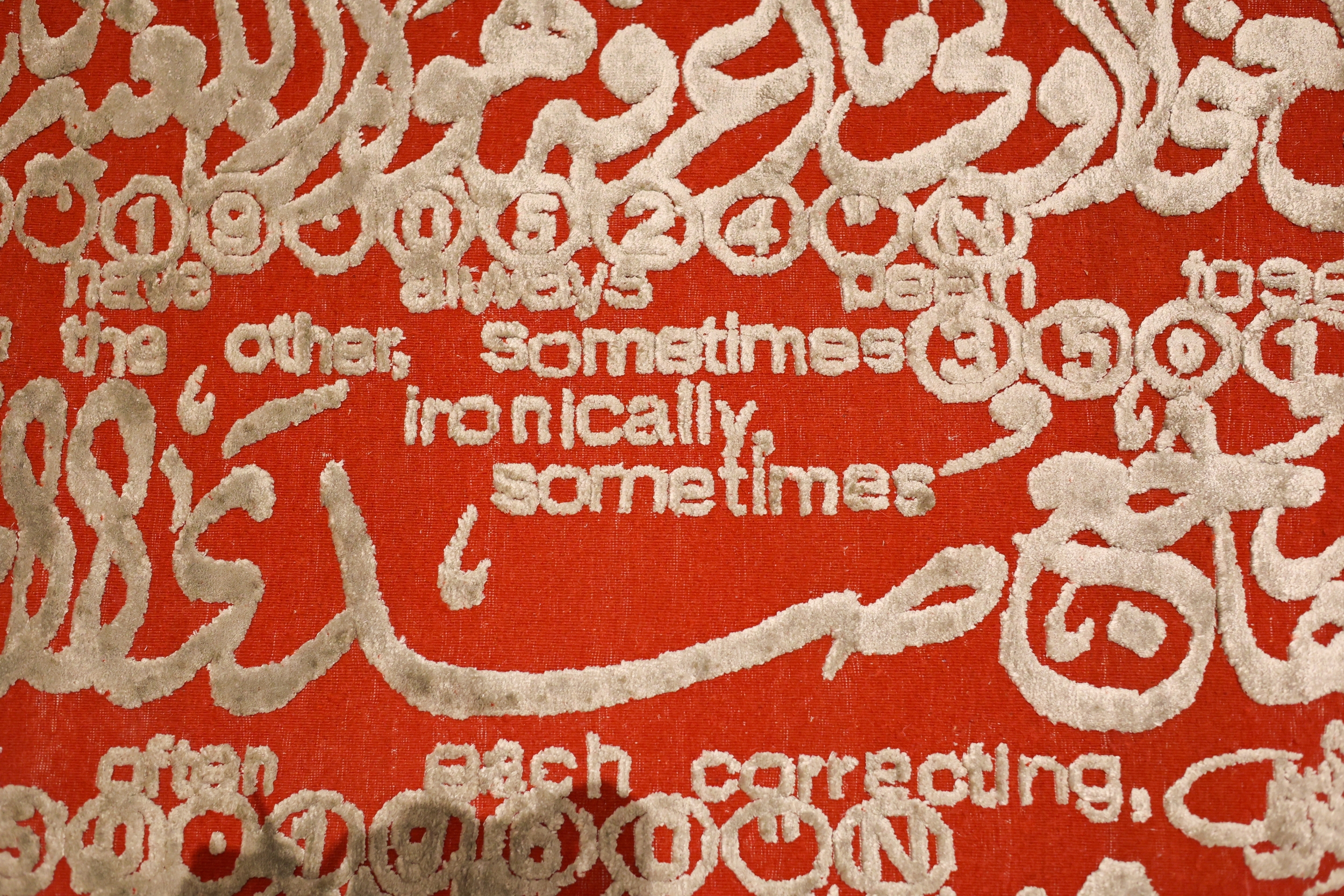
40MUSTAQEL –– A Woven Mimesis, 2024. Photo by Abdelaziz Alsafadi.
This intricately hand knotted carpet, crafted by skilled Egyptian artisans of Kiliim from the distant village of Abees, Alexandria, features the words of Palestinian American author Edward Said and is reproduced from the hand-drawn Arabic calligraphy executed in collaboration with Yemeni calligrapher Zaki Alhashimi.
The carpet, which serves as a reproduction of the internal conflict faced by polyglot/multicultural individuals, embodies the perpetual state of systematic aggression prevalent in the region, frequently leading to circumstances of migration and displacement. This hostility begets sentiments of estrangement towards one's own tongue as well as the uncertainty surrounding one’s own cultural identity, heritage, and linguistic experience.

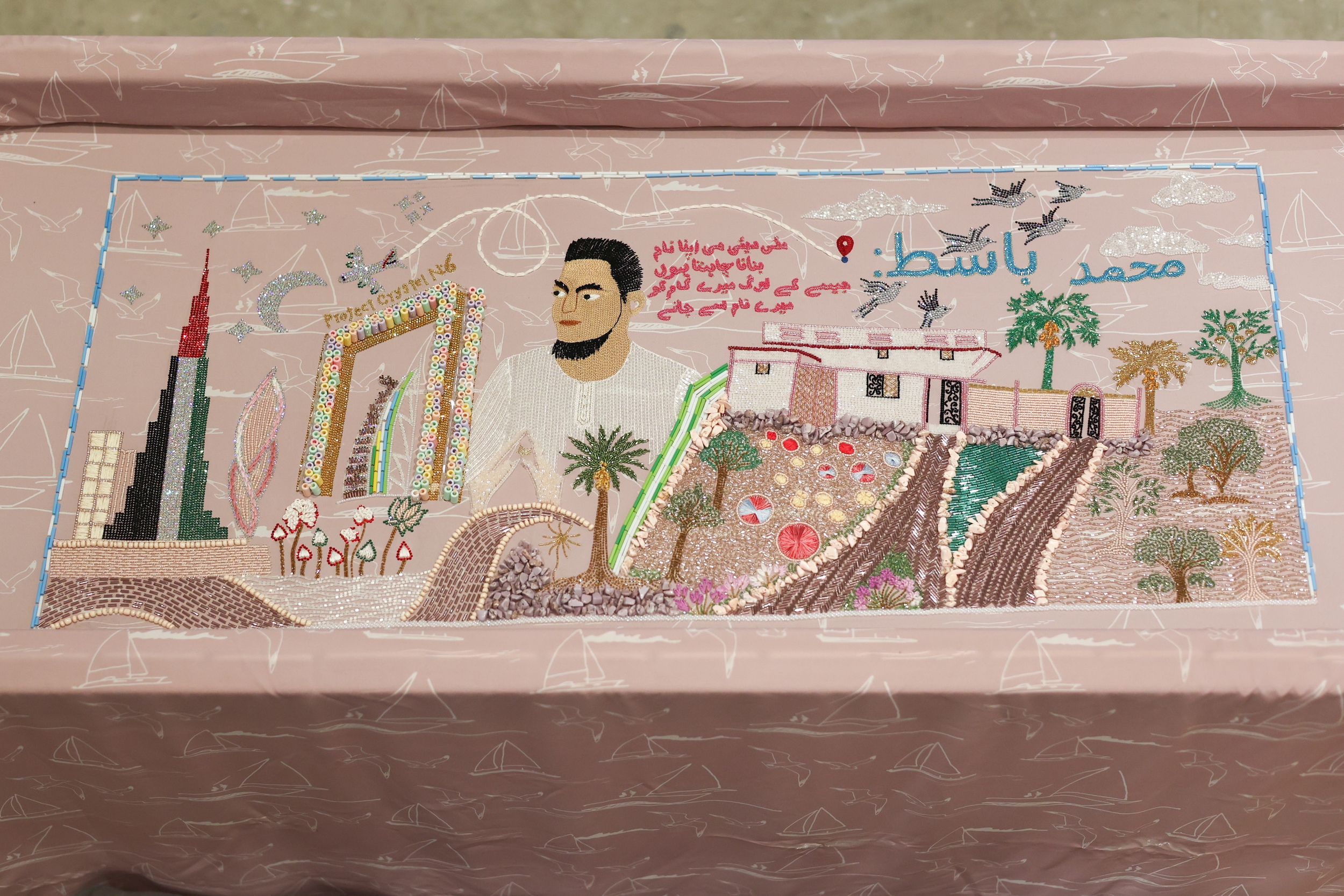
Mobius Design Studio –– Crystal No. 6, 2024. Photo by Abdelaziz Alsafadi.
This installation presents intricately embroidered self-portraits on wooden stretchers made by artisans in the Freej Al-Murrar neighbourhood in the UAE. With the accompanying texts and videos spotlighting artisans' identities and the stories behind these hand-embroidered garments, the project aims to foster recognition, appreciation, and ethical accountability by shifting focus to artisans while bridging the gap between art and their skilled crafts.
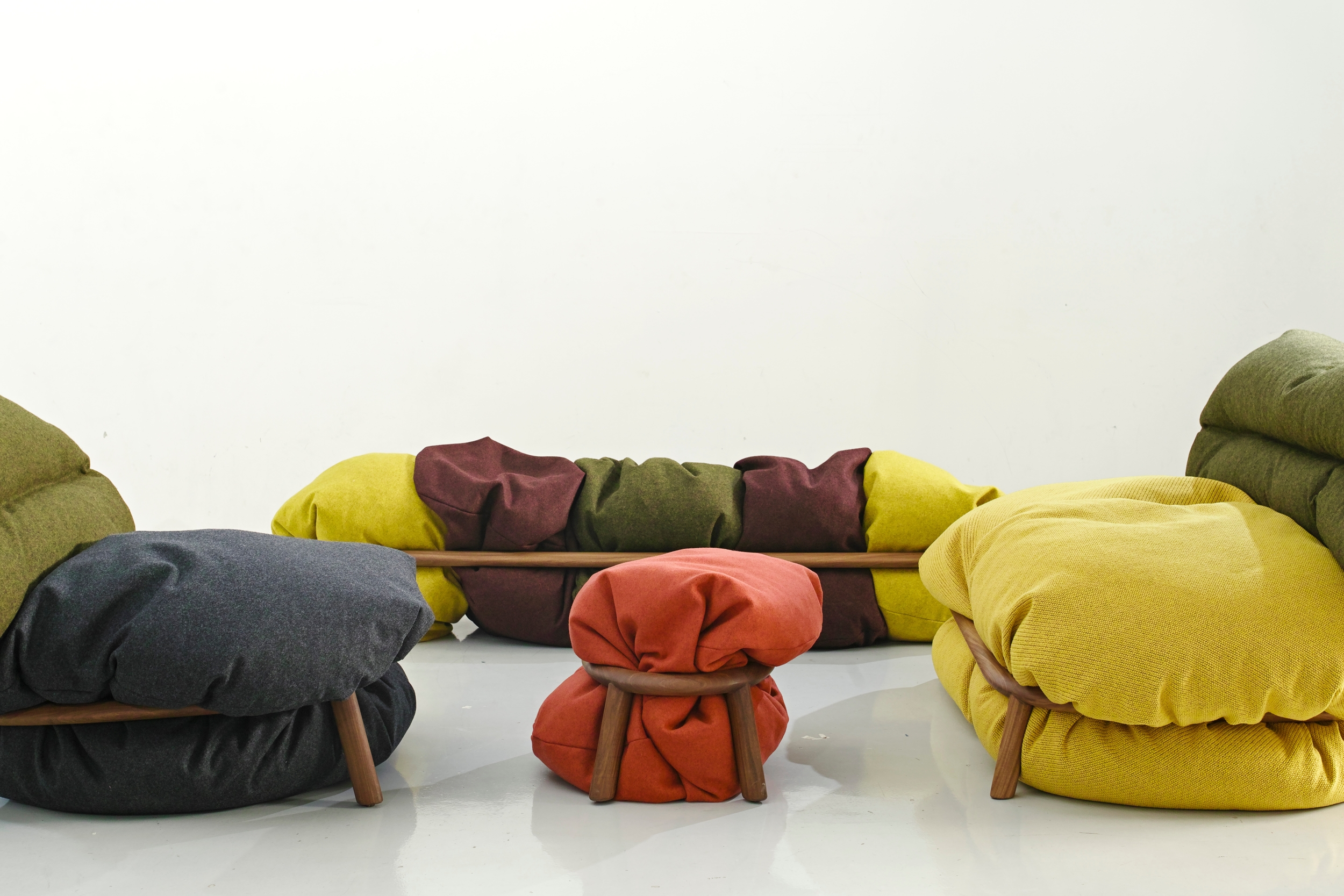
Anastasia Nysten –– Troll Chair, Troll Footrest, and Troll Bench 2017-2018. Photo by Marco Pinarelli.
In the Troll collection, de-constructivism is married to amorphic softness. A wooden structure, hand-carved by artisans, acts as the skeleton for loosely stacked pillows.


Nora Aly –– Beyond the Arabic Alphabet, 2014. Photo by Abdelaziz Alsafadi.
Three typographic booklets, each of which incorporates a poster, explore the letters Nun Al Niswa and Waw Al Jama'a, and the diacritic sign, Al Sokoun, in a quest to reveal some of the beauty and mystery of a culture constantly misjudged.
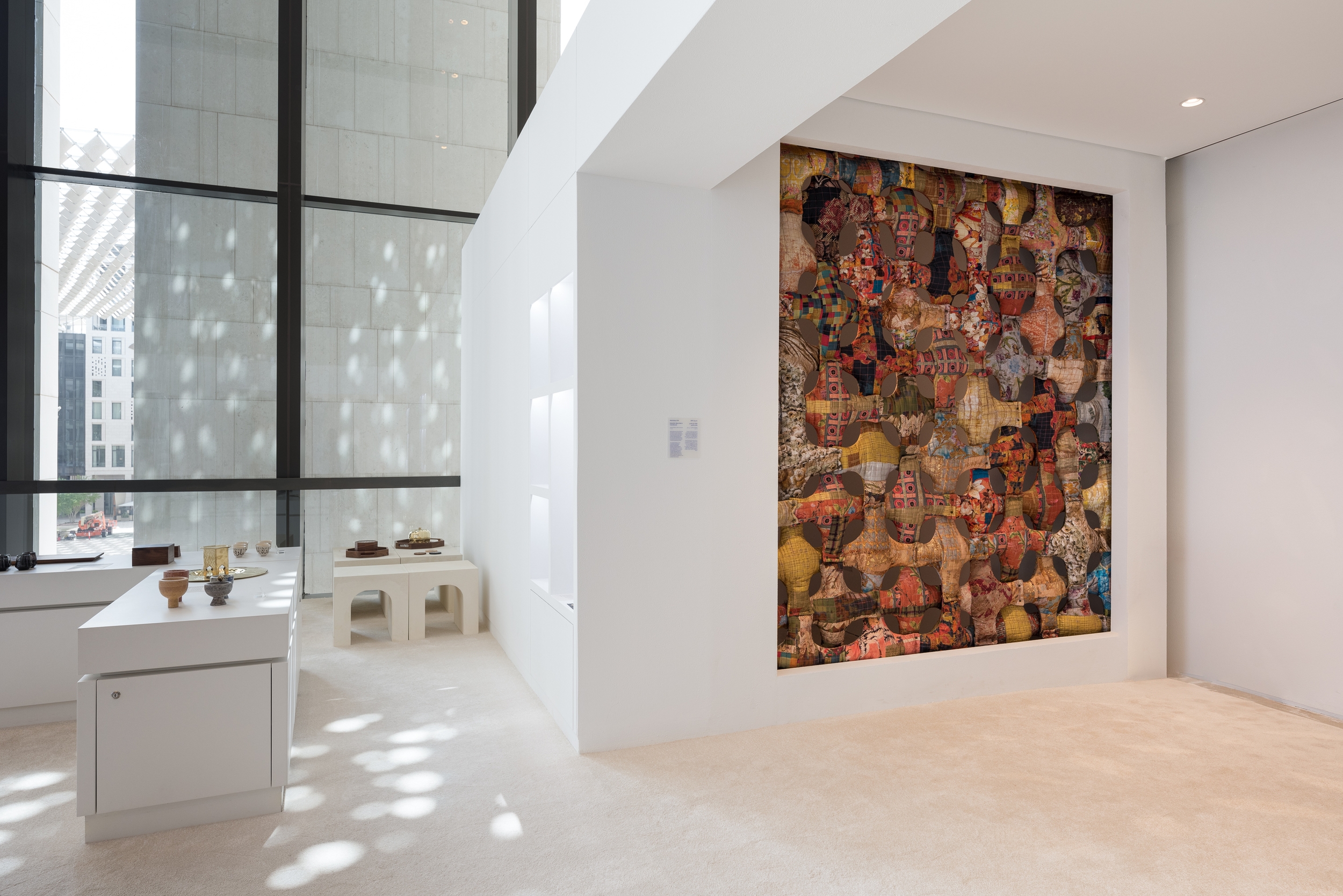
Bokja SAL –– Mashrabiya, 2015. Photo by Julian Velasquez.
Mashrabiyas are the architectural expressions of the importance of privacy in Islamic architecture. They function as ornate veiled surfaces, allowing viewers to face the world, while also being protected from the curious eyes of people wandering outside. This reinterpretation of the mashrabiya uses Bokja’s signature assemblage aesthetic, bringing together textile fragments of a time and place, situating them in unusual arrangements. Composed of modular adjustable units, its malleable nature references a sense of openness, autonomy and transparency, adapting to any context it may occupy.
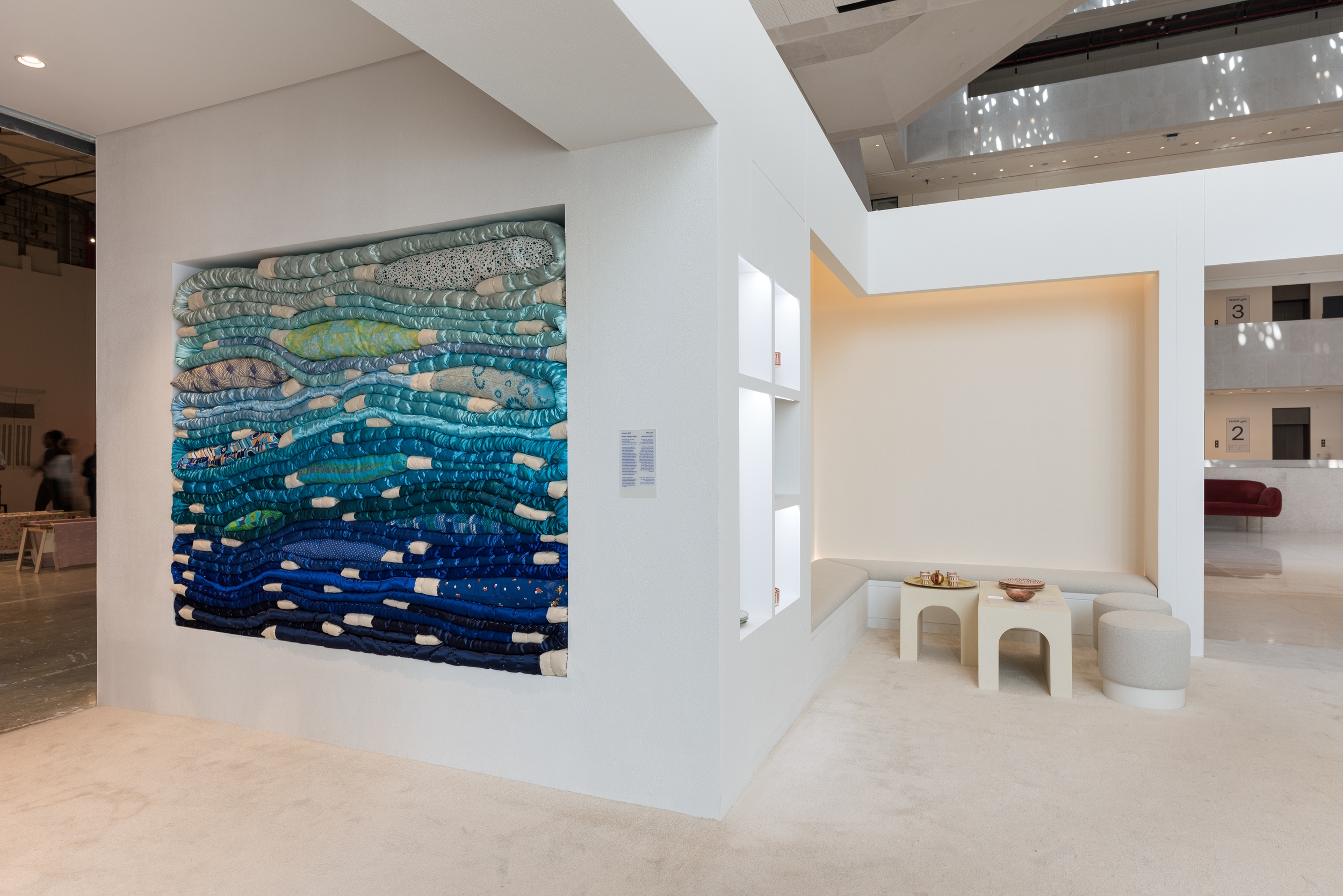
Ishraq and Tasneem Zraikat –– Al Matwa, 2024. Photo by Julian Velasquez.
Al Matwa is an homage to the traditional Middle Eastern linen closet typical of traditional regional architecture. The installation recreates this long-lost domestic feature by stacking several wool stuffed mattresses and blankets within a niche. The mattresses and blankets are hand upholstered in Jordan by expert artisans utilising traditional techniques. The wool used is from the native Jordanian Awassi sheep, and hand-processed by Bedouin women. The textiles used for the covers of the mattresses and blankets are a mix of new silk and cotton fabrics and repurposed vintage fabrics.
